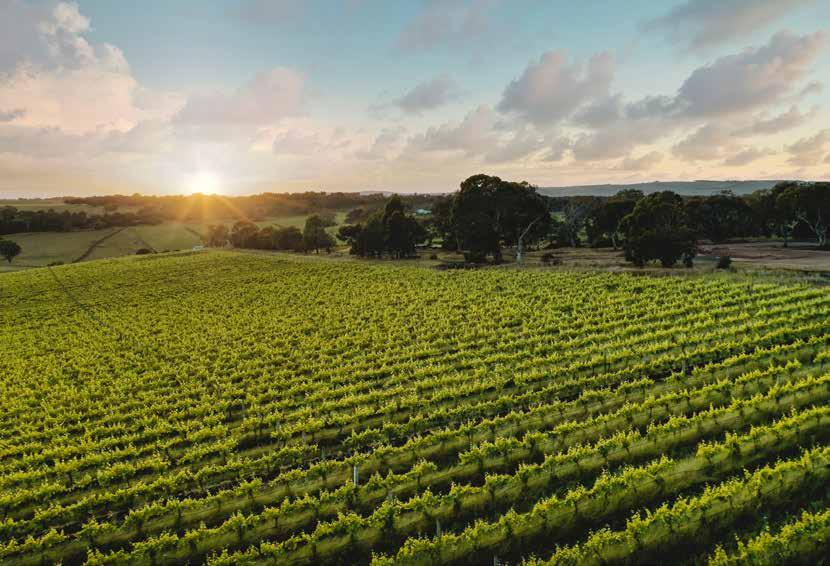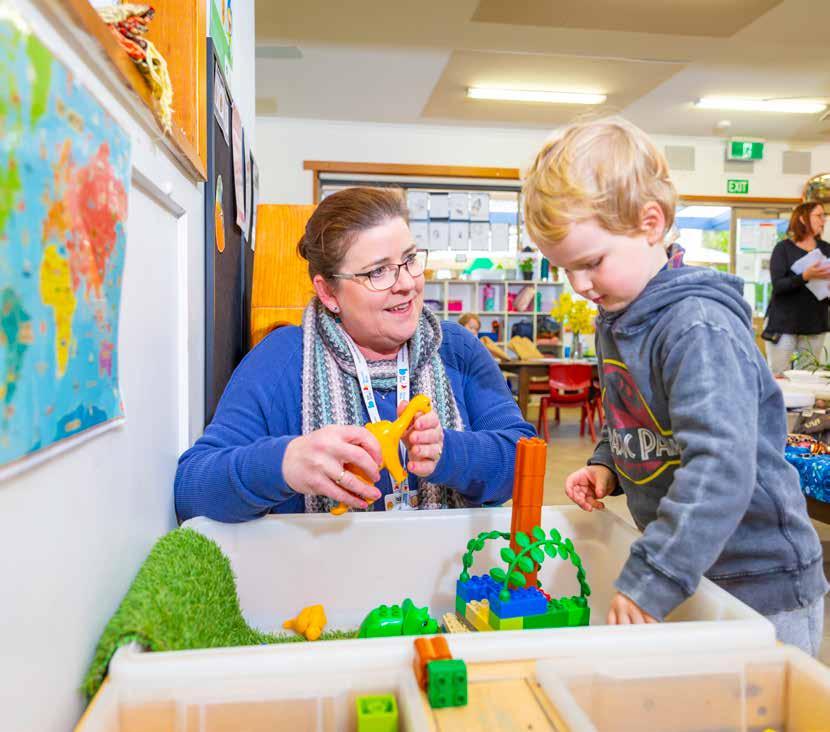

acknowledgement of country

Golden Plains Shire spans the Traditional lands of the Wadawurrung and Eastern Maar Peoples. Council acknowledges them as the Traditional Owners and Custodians and pays its respects to both Wadawurrung and Eastern Maar Elders past, present and emerging. Council extends that respect to all Aboriginal and Torres Strait Islander People who are part of Golden Plains Shire.
Artwork: ‘Wabdallah’ by Shu Brown Image: Sunset over Bunjil’s Lookout in Maude.
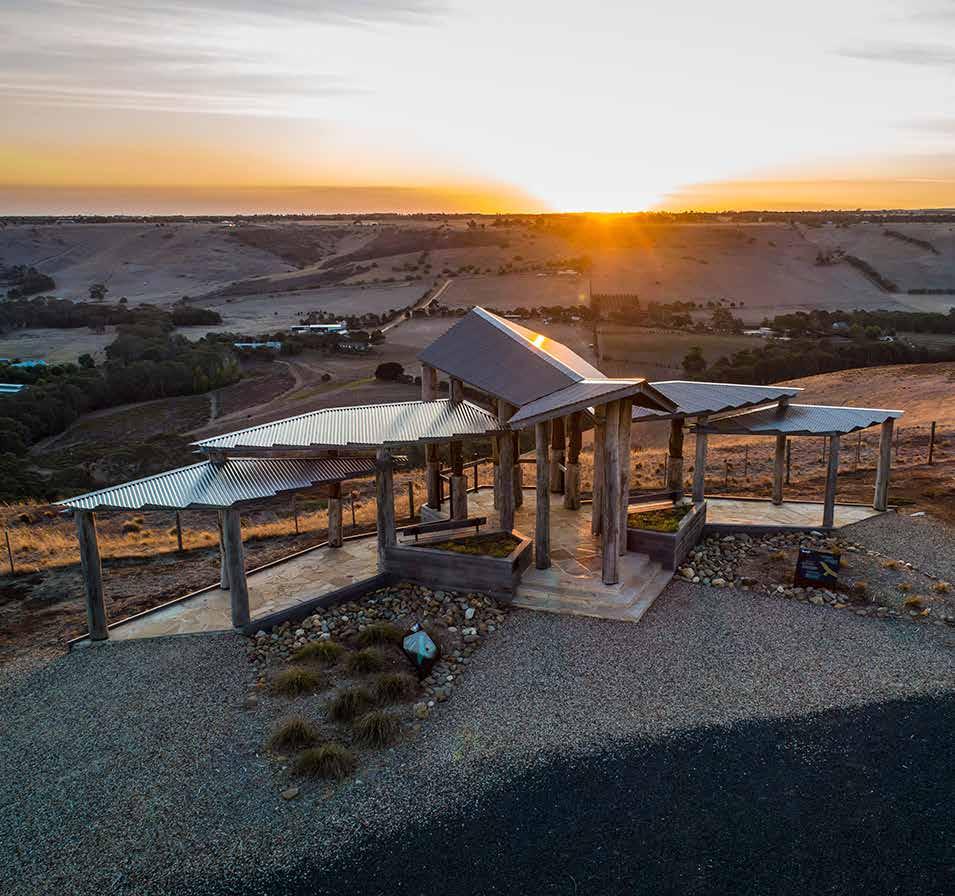
contents
report of
statements
138
139
of
145 Note 3 152 Note 4 156 Note
165
158 Note
report of operations

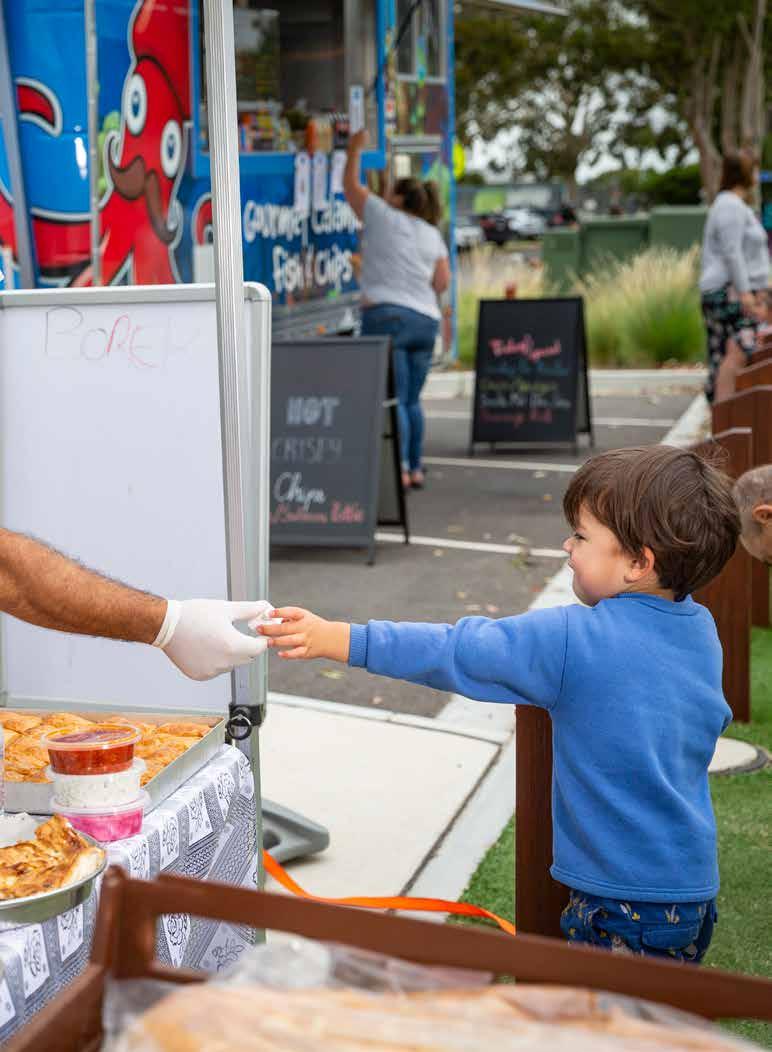

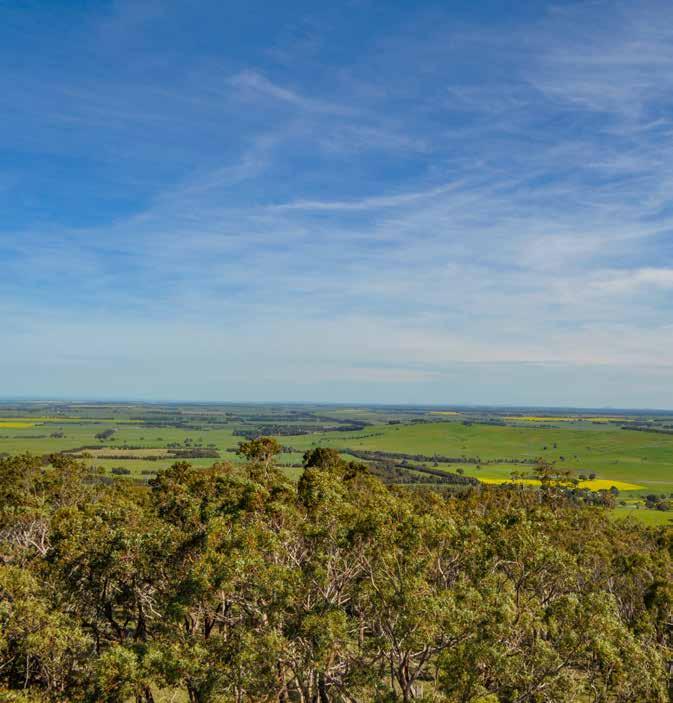
our vision, our mission, our values
VISION
A healthy, safe, vibrant, prosperous and sustainable community supported by strong leadership, transparent governance and community partnerships. Our Community • Our Economy • Our Pride
MISSION
We will achieve our vision through:
Demonstrating good governance and involving the community in decision-making.
Working and advocating in partnership with our community to address social, economic and environmental challenges.
Promoting gender equality and equity and inclusion for all.
Sustaining a focus on long-term outcomes and delivering increased public value through good decisionmaking and strategic spending.
Building awareness and strategic alliances with government, regional groups and the community.
VALUES
Honesty and Integrity
We will act ethically and honestly and work to continue to build the trust and confidence of the community.
Leadership
We will demonstrate strong and collaborative community leadership.
Accountability
We will act in an open and transparent manner and be accountable to our community for our processes, decisions and actions.
Adaptability
We will implement progressive and creative responses to emerging issues and will continue to work to build organisational and community resilience.
Fairness
We will base our decision-making on research, information and understanding of the needs and aspirations of the whole community and promote equitable access to the Shire’s services and public places.
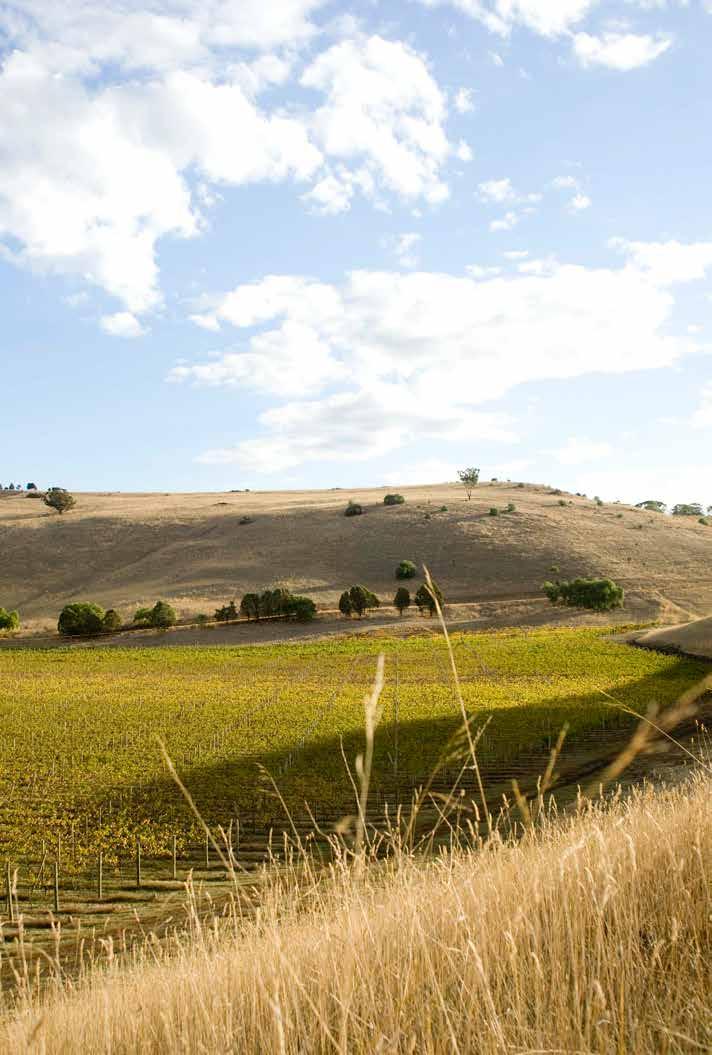
HIGHLIGHTS and ACHIEVEMENTS
MONEY FOR THE COMMUNITY
In 2021/22, 33 community projects received almost $153,337 in funding from Council’s Community Strengthening Grants program.
PLAYING UNDER LIGHTS
Lethbridge football and cricket clubs celebrated the opening of the lighting and irrigation upgrade at the Lethbridge Recreation Reserve..
A POSITIVE DIRECTION
Council commenced the preparation of a new Structure Plan for Smythesdale, providing direction for future growth and development in the town.
A DELICIOUS GARDEN
Edible Gardens, a webinar series on growing fresh produce at home, was a new health and wellbeing initiative launched in Golden Plains.
A CLIMATE EMERGENCY
Golden Plains Shire Council declared a Climate Emergency and committed to developing a plan to put the declaration’s words into action.
AUGUST 21
ALL ABOARD!
The Golden Plains Community Bus trail ran a free fivemonth service from northern towns to Ballarat and southern towns to Geelong.
READY TO RIDE
Funding for the Leighdale Equestrian Centre Upgrade was announced by the Victorian Government, Council, Inverleigh Riding Club and the Centre Committee.
KICKING GOALS AT VICTORIA PARK
New safety nets will be installed at Victoria Park, thanks to the State Government, Council, Bannockburn Football Netball Club and Cricket Club.
NEWS STRAIGHT TO EMAIL
The first issue of the eGazette was published, Council’s latest e-newsletter featuring community and Council news straight to resident’s inbox.
THE NEW DIGITAL HUB
Golden Plains Shire’s first coworking space was officially opened at The Well in Smythesdale, established with a Regional Digital Fund grant.
COVID-19 FINANCIAL SUPPORT
Council extended its COVID-19 Financial Hardship Policy for 2021/22, giving rates relief and mental health support to residents and businesses.
KEEPING COMMUNITY SAFE
A volunteer steering committee was established to guide a policy on Closed Circuit Television (CCTV) in public places in Golden Plains Shire..
A PLAN FOR SOCIAL HOUSING
Addressing the lack of social housing is the aim of the new Golden Plains Social Housing Plan, the results of a regional G21 commitment.
MARQUEES FOR LOCAL EVENTS
Local community events received the State Government’s Regional Recovery Fund support to return to strength following the COVID-19 pandemic.
A PLAN FOR PETS
Community feedback formed the development of Council’s Domestic Animal Management Plan, promoting responsible pet ownership in Golden Plains.
A VIRTUAL WELCOME
Golden Plains welcomed nine residents as the Shire’s newest Australian citizens at Council’s first virtual citizenship ceremony.
As part of Council’s COVID-19 Business Support Program, Golden Plains residents and businesses were able to access the Digital Hub for free for the first 12 months of operation.
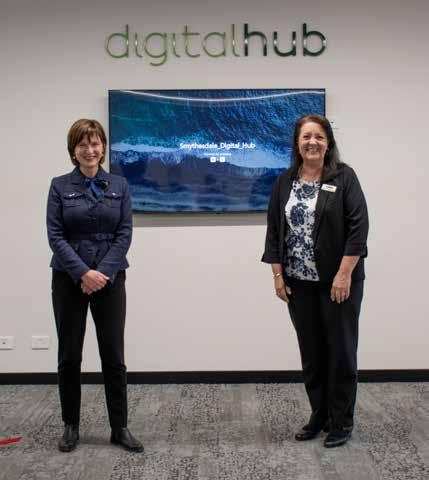
HIGHLIGHTS and ACHIEVEMENTS
A DIGITAL HISTORY
Golden Plains Stories, an interactive community history digital museum, will connect residents to the Shire’s past through the technology of the future.
IMPROVING RURAL ROADS
Invasive weeds and pests on rural roads in Golden Plains were targeted, as part of the Victorian Government’s Roadside Weeds and Pests Program.
A PHOTOGRAPHIC SHIRE
Council’s Spring in the Shire photography competition returned, capturing the Shire’s unique surrounds under the theme of ‘What we share.’
GROWING BANNOCKBURN
The Bannockburn Growth Plan, prepared by Council and the Victorian Planning Authority, was incorporated into the Golden Plains Planning Scheme
FUNDING FOR LOCAL PROJECTS
Council endorsed seven community projects to share in $2.6 million funding from the Australian Government’s Local Roads and Community Infrastructure Program.
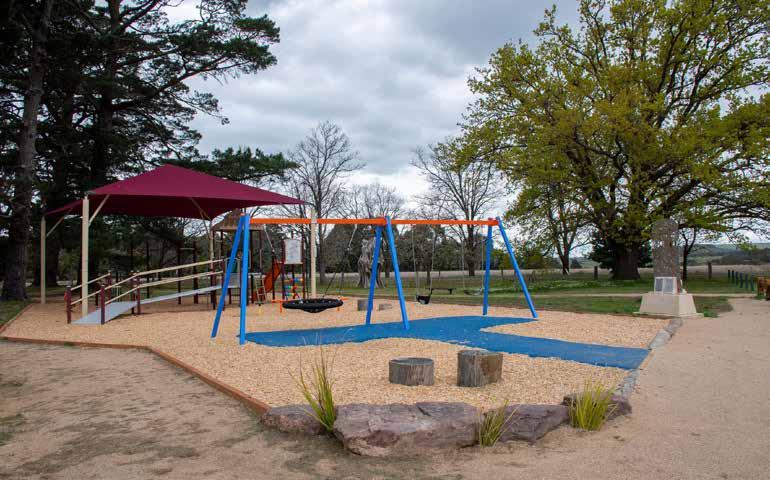
october
CELEBRATING CHILDREN’S WEEK
Fun and educational popup outdoor events were held in Maude, Haddon and Teesdale for local families to celebrate Children’s Week 2021.
october
ENJOYING SAFE PLAY
The Garibaldi Community Park Playground received a significant upgrade to ensure safe, active play, funded by the Australian Government’s LRCI Program.
POWERED BY THE SUN
Funded by the Berrybank Wind Farm, community buildings in Meredith, Scarsdale, Inverleigh, Haddon, Teesdale and Bannockburn are now solar powered.
NEW STATE ELECTORATES
New Victorian state electoral boundaries were announced, with Golden Plains spanning three electorates: Ripon, Eureka and Geelong.

A WHEELY GOOD MEAL
The Mobile Traders Policy was adopted, providing a framework that balances the needs of bricks and mortar businesses and mobile vendors on Council land.
STAYING CONNECTED DURING COVID
During pandemic lockdown, Council supported young people across the Shire to stay connected with online activities including trivia and gaming events.
HIGHLIGHTS and ACHIEVEMENTS
november 21
TAKING THE WICKET
Local cricket players were bowled over by new cricket wickets at recreation reserves in Shelford, Bannockburn and Ross Creek.
TURN ON THE TAP Advocacy from the local community drove the project to connect Maude Recreation Reserve and Bunjil Lookout to the reticulated water supply.
Works were completed on the installed flashing warning signage on the approaches to the single-lane Sharp Road Bridge, She Oaks.
DECEMBER 21
SANTA COMES TO GOLDEN PLAINS
To welcome travellers during the festive season, new Santa Claus’s were installed on the major Shire entry signs across Golden Plains.
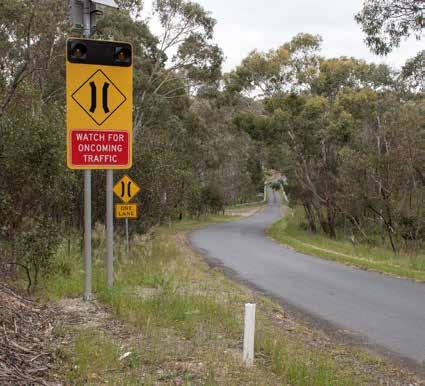
FUNDING FOR FLOOD STUDY
With funding secured from the Victorian and Australian Governments, Council will undertake a new flood study of the Teesdale area.
A NEW PLAYGROUND FOR ENFIELD
Enfield residents and visitors enjoyed playing on the new playground at Harrison Reserve during the Christmas holidays.
CONNECTING WITH TRANSPORT
The Golden Plains Transport Connections Study will help identify current and future transport needs, funded by the Victorian Government and Council.
TWO NEW BRIDGES FOR SHIRE
The $2.3 million Slate Quarry Road Bridge in Meredith and the Paddys Gully Road Bridge in Rokewood Junction were opened..
A SAFER BRIDGE
Supported by the Maude-She Oaks-Steiglitz Community Planning Group, Victorian Government and Council, Sharp Road Bridge safety works were completed.
TURTLE BEND UPGRADED
The Teesdale Turtle Bend Reserve Upgrade project delivered a suite of new and improved facilities at the popular recreation and events precinct.
GIFT LOCAL IN GOLDEN PLAINS Council launched Gift Local, a festive season campaign to encourage residents and visitors in support local businesses and services.
A NEW LOCAL LAW
Following extensive community consultation, Council adopted its new Local Law No. 1, protecting the amenity and wellbeing of the Shire.
SUPPORTING THE ARTS
The Arts, Culture and Heritage Strategy 2022-2026 was adopted, led by a dedicated volunteer Community Reference Group.
A WORLD HERITAGE BID
Golden Plains met with 12 partnership Councils to progress the bid for the Central Victorian Goldfields to secure a World Heritage listing.
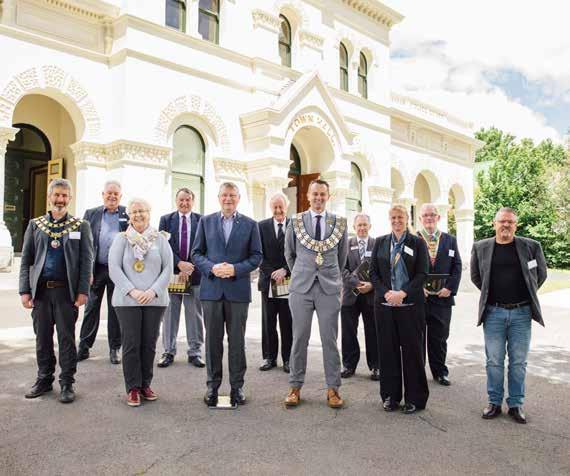 An unprecedented partnership of Central Victorian councils progressed its bid to share the extraordinary story of the goldfields internationally by striving for a World Heritage listing.
An unprecedented partnership of Central Victorian councils progressed its bid to share the extraordinary story of the goldfields internationally by striving for a World Heritage listing.
HIGHLIGHTS and ACHIEVEMENTS
CELEBRATING OUR COMMUNITY
Twenty outstanding residents and groups were nominated for the Golden Plains Shire Council Community Awards 2021.
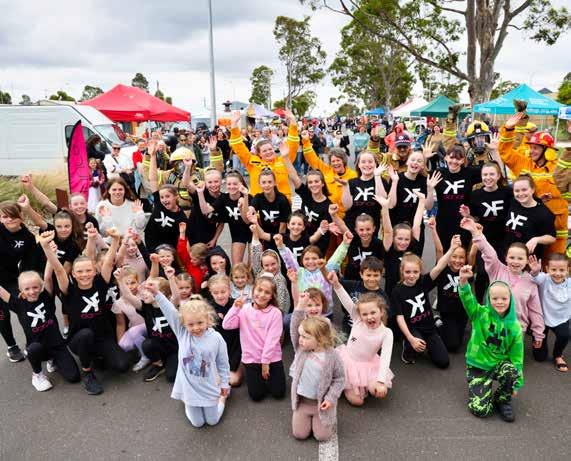
A SAFER ENTRANCE
The Bannockburn Township Entrance Safety Project, featuring a $3.2 million roundabout funded by the Australian Government, was opened.
ENGAGING WITH THE COMMUNITY
The 2022 Councillor Engagement Program featured the return of the popular Coffee with the Councillor initiative with in-person stops at small towns across the Shire.
IMPROVING THE COUNCIL EXPERIENCE
Engagement on Council’s Customer Experience Strategy 2022-2026 was opened, with the plan developed and adopted in April.
A CHANGE FOR RATES
Council adopted its new Rating Strategy 2022-2026, with key changes to the rating system, following extensive in-person and online community engagement.
TACKLING CLIMATE CHANGE
In-person and online community workshops helped shape the development of Council’s ten-year Climate Emergency Plan.
SECURING RECORD INVESTMENT
The new Rokewood Community Hub was announced, with $3.5 million from the Victorian Government – the single largest grant awarded to Golden Plains Shire.
EARLY INPUT ON BUDGET
A new community engagement initiative was launched, seeking early input into the development of the Draft Budget 2022/23.
LEARNING TO LEAD
Aspiring community leaders signed up to strengthen their knowledge and skills with Council’s new Community Leadership program.
MANAGING POPULATION GROWTH
The Golden Plains Settlement Strategy, a longterm plan to manage growth and development across the Shire, was funded by the Victorian Government.
HOWZAT!
The new outdoor cricket training facility featuring three synthetic bays was officially opened at Lethbridge Recreation Reserve.
CELEBRATE AND SKATE!
A free skating party was held to celebrate the Bannockburn Skate Park Upgrade opening, improving community safety at the popular youth location.
BRIDGING MUNICIPALITIES
The $2.8 million Franklin Bridge in Napoleons was opened, a partnership of Council, City of Ballarat and the Australian Government
ALL THE FUN OF THE FAIR
Council partnered with the Victorian and Australian Governments to present the Golden Plains Community Fairs in Smythesdale and Bannockburn.
IMPROVED WEBSITE EXPERIENCE
Improved accessibility, navigation and security was the focus of a significant upgrade and redesign of the Golden Plains Shire Council website.
FEDERAL FUNDING FOR SHIRE
Council welcomed $1.3 million allocated in the Federal Budget under the extension of Phase 3 of the Local Roads and Community Infrastructure Program.
HIGHLIGHTS and ACHIEVEMENTS
BOWLED OVER IN LINTON
The Linton Cricket Club welcomed the new outdoor three-bay synthetic training facility, which opened at Linton Recreation Reserve.
IMPRESSIVE SOCCER UPGRADE
The $1.2 million upgrade of the Bannockburn Soccer Facility, including new female friendly change rooms and lighting, was opened.
HONOURING WOMEN IN SERVICE
A public artwork to honour local war surgeon and Director of Infant and Maternal Health, Dr Vera Scantlebury OBE, will be installed in Linton.
VALUEING VOLUNTEERS
National Volunteers Week was marked with the launch of Volunteers in Action, a photographic exhibition featuring the stories of local volunteers.
INCLUSIVE AND ACTIVE
Get Active Golden Plains, a program to support health and wellbeing with inclusive activities for all skills levels across the Shire, ran in April and May.
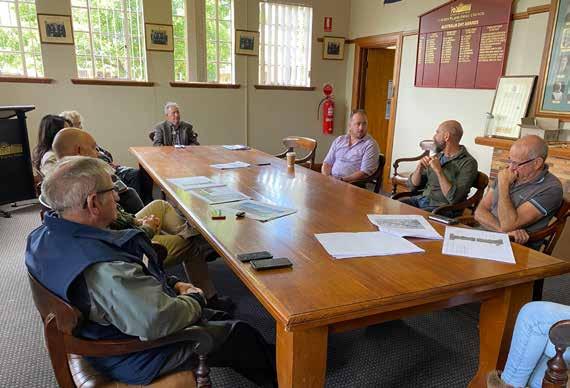
SHIRE MARKS RECONCILIATION WEEK
National Reconciliation Week was celebrated with indigenous storytelling sessions at the libraries and a smoking ceremony at Golden Plains Youth Hub.
CLUB UPGRADE AT INVERLEIGH
The newlyupgraded club rooms of the Inverleigh Football Netball Club at the Inverleigh Sporting Complex were officially opened..
A DEDICATED HUB FOR YOUTH
The Golden Plains Youth Hub, a project that transformed a portable office building into a dedicated youth facility in Bannockburn, was completed and opened.
REPURPOSED FOR THE COMMUNITY
The former Council office at Linton Shire Hall has been opened as a community hub, with three local community groups activating the space.
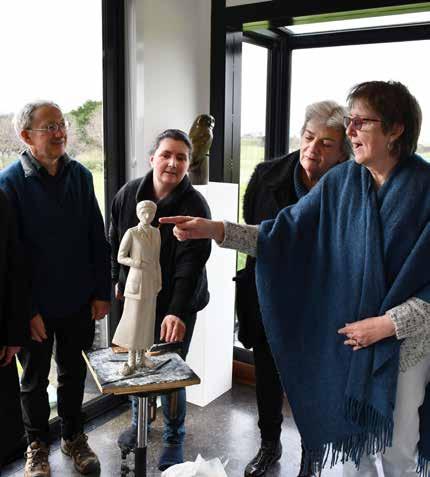
LET’S GET IT SORTED!
A new waste campaign to improve recycling practises and reduce contamination began with the first key message: Keep Recyclables Loose.
BEAUTIFICATION IN THE NORTH
The Northern Streetscapes Framework Plan was adopted, to guide the design and implementation of beautification works in Linton, Scarsdale and Smythesdale.
BUILDING A STRONG ECONOMY
Council welcomed community and stakeholder input to its Economic Development, Tourism & Investment Attraction Strategy 2022-2032.
ELECTION ADVOCACY SUCCESS
Following advocacy during the Federal Election campaign, Golden Plains Shire will receive $3.61 million from the new government to fund 7 community projects.
HIGHLIGHTS and ACHIEVEMENTS
FUNDING FOR NETBALL PAVILION
Funding for the new $1.8 million Bannockburn Netball Pavilion at Victoria Park was secured from the Victorian and Australian Governments.
A CHANGE FOR THE BETTER
The new and upgraded $1.6 million change rooms at Inverleigh Sporting Complex were officially opened.
SUPPORT FOR LOCAL BUSINESS
Following the COVID-19 pandemic, Council’s Business Networking Events returned and a new Northern Business Network was established.
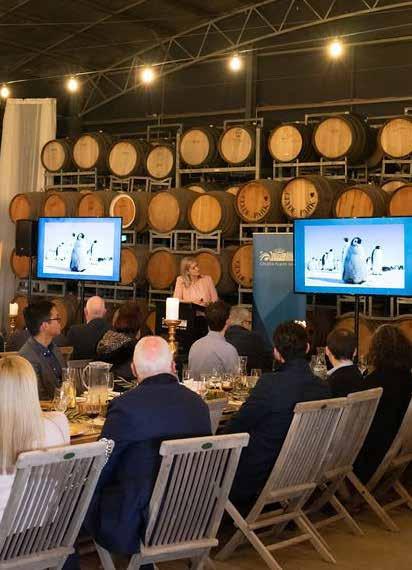
UNDERSTANDING CULTURAL HERITAGE
Cultural heritage talks for community members and Council staff were a popular feature of Council’s NAIDOC Week program.
INVESTING IN CRIME PREVENTION
New funding from the Victorian Government to improve community safety and address the causes of crime was announced at the Golden Plains Youth Hub.
NEW RECREATION PROJECTS FUNDED
The Rokewood Netball and Tennis Court Upgrade and Tracks and Trails Strategy projects received Victorian Government grants.
COUNCIL BUDGET ADOPTED
Following two rounds of community consultation, the Council Budget 2021/22 was adopted.
CARING FOR OUR ASSETS
Under the new Local Government Act 2020, Council adopted its Asset Plan 2022-2032.
In 2021/22, Council completed a significant range of community engagement processes including surveys, in-person and online conversation posts, community reference groups and workshops for the following projects, programs and plans:
• Council Budget 2022/23
• Rating Strategy
• Best Value Review: Aged and Disability Services
• Climate Emergency Plan 20222032
• Long-Term Financial Plan 2021/22-2030/31
• Municipal Public Health and Wellbeing Action Plan 20212025
• Domestic Animal Management Plan
• Customer Experience Strategy 2022-2026
• Economic Development, Tourism & Investment Attraction Strategy 2022-2032
• Asset Plan 2022-2032
• Golden Plains Transport Connections Study
• Arts, Culture & Heritage Strategy 2022-2026
• Northern Streetscapes Framework Plan
• Smythesdale Structure Plan
• Inverleigh Tree Succession Plan
• Mobile Traders Policy
• Governance Rules
• Local Law No. 1
• Road Management Plan 20212025
• Rabbit Management Strategy and Action Plan 2021-2031
• Sebastopol-Smythesdale Road Speed Change
• Woady Yaloak Equestrian Centre Masterplan
• Draft G21 and AFL Barwon Towards 2030: Strategy
• Active Golden Plains Program
• Youth Activation Committee
• FReeZA Youth Events Crew
• Berrybank Wind Farm Community Grants Committee
• Community Leadership Program
• Linton Shire Hall Committee of Management
• Council CCTV Steering Committee
• Golden Plains Youth Hub Community Reference Group
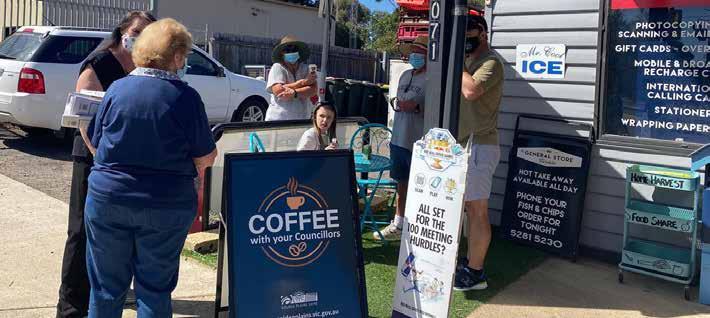
Council is committed to delivering quality community consultation with local residents and businesses on the decisions that affect their lives, under its Community Engagement Policy.
challenges and future outlook
Challenges
• Managing population and housing growth across the Shire - attracting new and supporting existing residents with services, facilities and infrastructure that promote liveability.
• Maintaining the country feel that is highly valued by the Golden Plains community and protecting out natural resources, environment and cultural heritage.
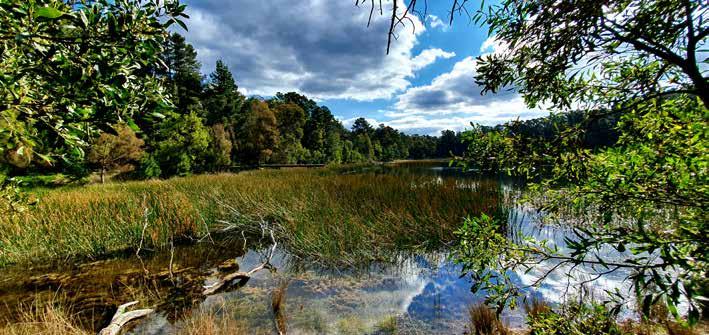
• Attracting key services, investment in road infrastructure and expansion of the public transport network to connect our communities to major regional centres.
Following Council’s declaration of a Climate Emergency, the Golden Plains community engaged in the development of the Climate Emergency Plan 2022-2032, which, following endorsement, will guide Council’s response to climate change.
• Responding to the ongoing health, economic and social challenges posed by the COVID-19 pandemic.
• The impact of an ageing population and ensuring adequate access to health services in local communities across Golden Plains Shire particularly in disability and aged care.
• Meeting increasing access demand for early years services delivered by Council, including family day care, funded kindergarten, and maternal child health services and programs.
• The rising costs of construction materials and labour in the delivery of major infrastructure projects within budget and time constraints.
• Responding to the Climate Emergency and identifying actions and commitments Council and the community can take to mitigate, adapt and respond to climate change.
• Talent attraction for capable staff committed to delivering Council’s Vision and Values and addressing the generational profile of Council’s workforce.
With continued population growth as Golden Plains emerges from the COVID-19 pandemic, there are a number of challenges facing our Shire 2021/22 and beyond, including:
THE FUTURE
• Strategic Land Use Planning that maintains rural and township character while catering for the growth, infrastructure and a variety of affordable housing including with the Bannockburn Growth Plan and Township Structure Plans.
• Planning, providing and funding community infrastructure and services to meet increased demand and growth including in early years services and recreation.
• Fostering and promoting the potential of young Golden Plains Shire residents through the Municipal Early Years Plan, Youth Development Action Plan, and initiatives and programming at the Golden Plains Youth Hub.
• Supporting the preparation, prevention, resilience and recovery capacity of communities, including from natural disasters and the COVID-19 pandemic.
• Ongoing delivery of the Municipal Public Health & Wellbeing four-year action plan – bringing together partners, service providers, funding bodies and stakeholders to raise awareness, advocate and address the identified health and wellbeing priorities.
• Advocacy to State and Federal Government Departments for further investment in roads, community infrastructure, economic development and investment, public transport,
Council celebrated Reconciliation Week with a public event at the Golden Plains Youth Hub, alongside internal activities for staff, as the organisation takes important steps on its journey of reconciliation under the Reflect Reconciliation Action Plan.

health services and youth support across the Shire.
• Endorsement and implementation of Council’s Climate Emergency Plan to develop and progress local approaches to mitigate and adapt to climate change and its impact on health.
• Delivery of the recentlyaccredited Reflect Reconciliation Action Plan and continuing to promote positive working relationships, understanding and connection to indigenous culture.
• Implementation and monitoring of the adopted 10-year Financial Plan and Revenue and Rating Plan to deliver long-term financial sustainability.
Under the direction of the Golden Plains Community Vision 2040, Council is committed to delivering its Council Plan 2021-2025 and partnering with community, government and key stakeholders, now and into the future, including:
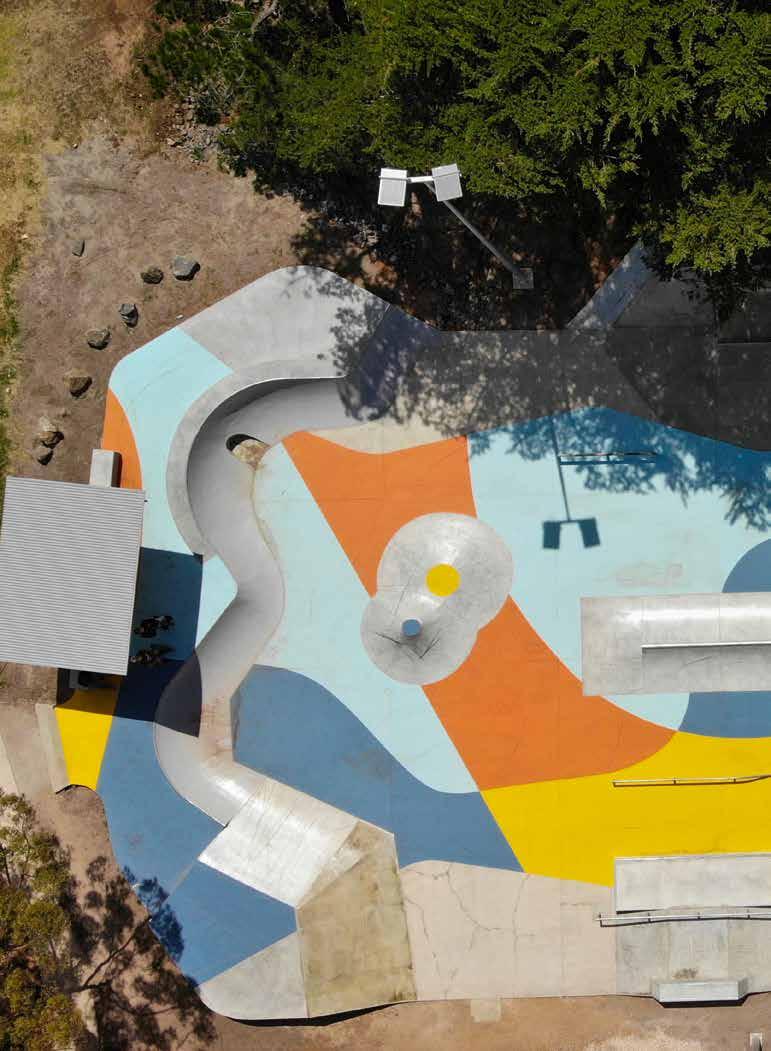
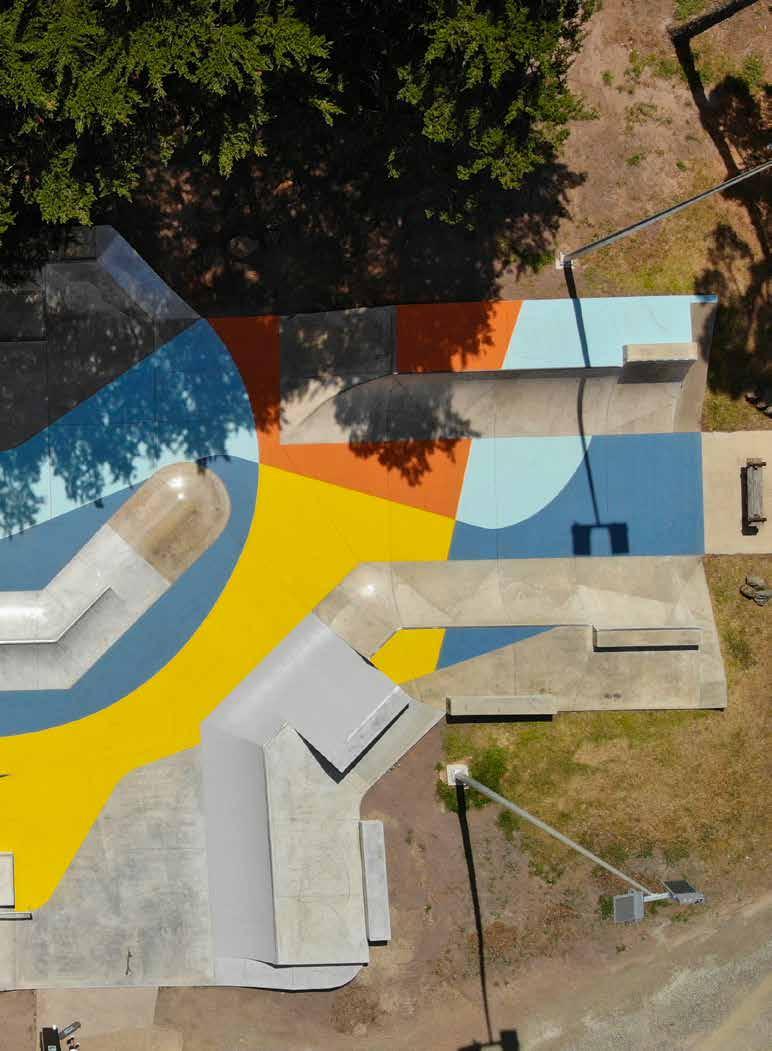 The upgrade of the Bannockbutn Skate Park was completed in 2021/22, providing a first-class skate and scoot facility for young people in the south of Golden Plains Shire
The upgrade of the Bannockbutn Skate Park was completed in 2021/22, providing a first-class skate and scoot facility for young people in the south of Golden Plains Shire
The Annual Reports of the past two years are coloured with the stories and experiences of the COVID-19 pandemic. As Golden Plains Shire emerges from the crisis to a changed world, I would like to acknowledge the resilience and compassion of our local people and communities, as well as the support and care of Council staff that saw us through this challenging period. With confidence and optimism, we look to a positive future for our local residents, businesses and communities in Golden Plains.
POSITIVE CHANGE FOR THE COMMUNITY
While the initial eight months of the Council term involved significant induction and training as well as the strategic work to develop the Council Plan 20212025, the 2021/22 year provided the opportunity for Council to make meaningful change to improve the lives of local residents and businesses.
In the first full year of the Council term, our Councillor group continued its commitment to genuine and authentic community consultation with a broad range of in-person and online options under the Councillor Engagement Program. In February 2022,
As Mayor of Golden Plains Shire and on behalf of my fellow Councillors, I’m proud to introduce the Annual Report 2021/22, detailing Council’s achievement of the strategic objectives in the first year of the Council Plan 2021-2025.

Council launched a campaign for early engagement to inform the development of the Draft Budget – a change from the traditional process of creating the Draft Budget internally and endorsing it for public exhibition. This more holistic approach to the budget conversation, with the voice of the community front and centre, was a great success and we look forward to continued open and productive discussion on Council’s annual financial plan over the course of the Council term.
In February 2022, Council adopted the new Rating Strategy 2022-2026, following an extensive review of the rating system and consultation with community members. The new Strategy included changes to the differentials on vacant land, businesses in Bannockburn, and broadacre and intensive farm land; as well as a decrease in the Municipal Charge for all properties.
It was the decision of Council that this new system is a fairer, more equitable way to calculate rates in Golden Plains and will make a positive difference in our Shire.
DELIVERING FOR GOLDEN PLAINS
As a growing peri urban council, advocacy is a key commitment of Council. In our rates-capped
environment, it is a continuing challenge to balance the needs and expectations of our residents with a limited budget.
This year, Council was successful in securing record investment in Golden Plains Shire. It was a busy campaign for the Federal Election in May, with the new Federal Electorate boundaries placing a smaller area of the Shire in Corangamite and the majority of Golden Plains moving to the Ballarat electorate. Council actively lobbied candidates for both electorates and was pleased to secure $3.61 million in funding for seven valuable community projects in the Shire. With the State Election in November 2022, our Council will continue to advocate for greater government funding in the communities of Golden Plains Shire.
As Council marked significant achievements in attracting investment to our communities, so too, we celebrated many openings of wonderful new infrastructure that will play an important and positive part in the lives of our residents and communities. This list includes the Golden Plains Youth Hub, Bannockburn Soccer Facility Upgrade, Inverleigh Sporting Complex Change and Club Rooms, Teesdale Turtle Bend
Upgrade, Bannockburn Skate Park Upgrade, Lethbridge Lighting and Irrigation and Bannockburn Bowls Upgrade. It was great to see new bridges opened in Napoleons, Meredith and Rokewood Junction, as well as road upgrades in Meredith and the longawaited Bannockburn entrance roundabout.
MAKING A DIFFERENCE IN GOLDEN PLAINS
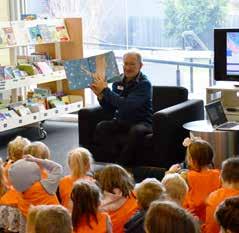
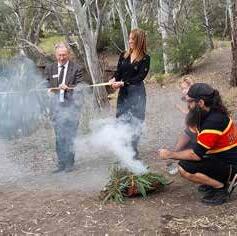
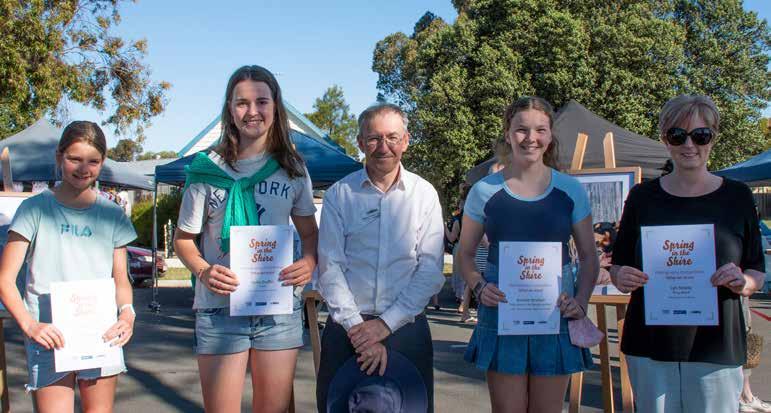
In July 2022, Council declared a Climate Emergency and committed to preparing a Climate Emergency Plan to put the declaration’s words into action. It’s an exciting development in Council’s commitment to play an important role in the sustainability and preservation of our local environment and more broadly, the climate crisis that faces Australia and the world.
From the installation of solar panels on the Golden Plains Civic Centre and seven community buildings to new solar compacting bins at local playgrounds, Council
is taking small and large steps toward a greener, more sustainable Shire. Council signed a new waste contract this year and in partnership with Barwon Water and the G21 councils, Golden Plains Shire is supporting the development of the Regional Renewable Organics Network. The first stage of the Berrybank Wind Farm is completed and operational, as the Golden Plains Wind Farm begins construction.
Developed in partnership with community members and local environmental groups, the Climate Emergency Plan 2022-2032 will be finalised in 2022/23 and we look forward to working with our communities to answer the climate change call to action.
As we mark another successful year, I would like to extend my appreciation to my fellow Golden Plains Shire Councillors, Council staff and local community members and business for their valuable contributions to Golden Plains Shire.
 Cr Gavin Gamble
Mayor of Golden Plains Shire
Mayor Cr. Gavin Gamble at the Golden Plains Twilight Market with the winners of the Spring in the Shire photography competition; cutting the ribbon at the handover of the Moorabool River Reserve in Batesford (below); reading at Bannockburn Library for National Simultaneous Story Time (bottom right).
Cr Gavin Gamble
Mayor of Golden Plains Shire
Mayor Cr. Gavin Gamble at the Golden Plains Twilight Market with the winners of the Spring in the Shire photography competition; cutting the ribbon at the handover of the Moorabool River Reserve in Batesford (below); reading at Bannockburn Library for National Simultaneous Story Time (bottom right).
message
Pride. Respect. Integrity. Collaboration. Excellence.
These important words are our organisational Values at Golden Plains Shire Council, and in 2021/22, they are the perfect description of our staff and leadership in their commitment to the people and communities of our Shire. It was another 12 months that was impacted by the COVID-19 pandemic, navigating lockdowns, restrictions and return to work, and through it all, the staff of Council continued to deliver quality services, programs and projects across Golden Plains.
Highlights of 2021/22
With this significant investment in the Shire, it is incumbent upon the many teams of Council to collaborate for quality outcomes on these important projects. This year was a key year of delivery for Council – and the impressive list of completed works and official openings is a credit to our dedicated staff and management.
In 2021/22, an internal process to develop a new Project Management Framework was undertaken to ensure that every project is delivered to the highest standard for our communities – from concept through strategic planning to the final construction. With community and stakeholder consultation at the centre of this framework, it’s an exciting new way of working that matches the project management of large metropolitian municipalities while focusing on the very best local outcomes for the people and communities of Golden Plains Shire.
The COVID-19 pandemic has had a wide-reaching impact of many aspects of our lives, including the escalation of relocation from cities to regional areas. Bordering Ballarat and Geelong, Golden Plains Shire has long been an attractive place to live and our communities
continue to welcome new residents. Council’s planning for growth is an important part of all our work, as we understand and appreciate the important role that local government plays in preserving the liveability and community of our beautiful Shire – two of the key pillars of the Golden Plains Community Vision 2040.
Following the Council Election in 2020, the organisation worked with the new group of Councillors and the community to develop the Council Plan 2021-2025, which was adopted in June 2021. With the new plan in hand, this was the first year of implementation and delivery, and staff teams in Council took up this commitment in earnest, marking a strong list of achievements across the 21 strategic objectives and 83 key actions. Many more actions and projects are underway and Council will continue to deliver the commitment of the Council Plan, under the direction of the community-led Golden Plains Shire Community Vision 2040.
In 2021/22, the organisation also completed a significant suite of strategic planning work to satisfy the requirements of the Victorian Government’s Local Government

On behalf of Golden Plains Shire Council, it’s a great pleasure to present Council’s Annual Report for the year 2021/22.
Act 2020. This work began in 2020/21 with the Councillor Code of Conduct, Community Engagement Policy, Community Vision, Council Plan, Annual Budget and Revenue and Ratings Plan. This year, Council finalised this project with the completion of the the Long-Term Financial Plan 2021/22-2030/31, Workforce Plan and Asset Plan 20222032. In addition, there was a diverse range of other strategic plans and strategies to guide Council’s delivery, all developed in consultation with our residents and communities.
Organisational Performance
To best serve the people of Golden Plains Shire, it is imperative that Council has productive, engaged and committed staff teams. There are diverse range of professionals that work at Council in a variety of different locations – from our outdoor workers grading roads to our Customer Experience officers who greet our residents at our customer hubs to our Maternal and
Child Health nurses, kindergarten teachers and family day carers to our office teams of planners, engineers and information technology.
Together, we work under the banner of our Vision – Where people matter, communities are connected and the future is bright – and our Values of pride, respect, integrity, collaboration and excellence.
In 2021/22, the staff team of volunteer Values Champions led the implementation of this commitment across the organisation, embedding it in our recruitment and performance assessment processes, launching a new staff recognition program and strengthening our learning and development.
At Council, we aspire to be a community leader and an employer of choice. In 2021/22, we furthered our advocacy for diversity and inclusion, with a program of internal education and external support for significant days for our First Nations and LGBTIQA+ communities. Council
completed its first Reconciliation Action Plan and its Gender Equity Action Plan, with more positive work on this important journey of understanding and recognition to take place in this space in the coming year.

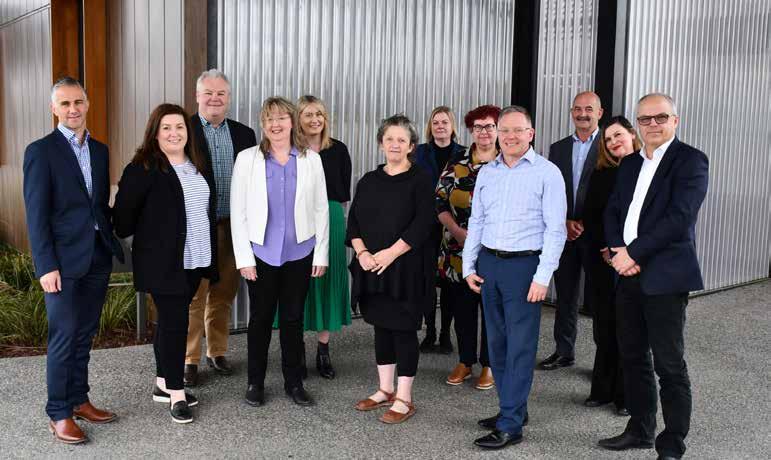
As I look back on another busy and exciting year at the organisation, I’d like to acknowledge Council and all staff of Golden Plains Shire Council for their hard-work and commitment to serving the people and communities of Golden Plains. We look forward to another productive and successful year delivering the Council Plan 20212025 and progressing the Golden Plains Community Vision 2040.
Eric Braslis Chief Executive Officer CEO Eric Braslis with the Management Team of Golden Plains Shire Council at the Golden Plains Civic Centre. 01 report of operations the year in reviewfinancial summary
The Annual Report conveys the performance of Council for the 2021/22 financial year and is considered in conjunction with the Council Plan 2021-2025, incorporating Council’s Strategic Resource Plan, focusing on the long-term objectives of Council.
Council’s financial position continues to remain sound. A summary of our performance is outlined below. Detailed information relating to council’s financial performance is included within the financial statements and performance statement sections of this report.
OPERATING POSITION
Council achieved a surplus of $6.0 million in 2021/22, compared to the prior year surplus of $9.1 million. As per the Comprehensive Income Statement in the Financial Report, this variance is mainly grants recognised as payments in advance due to performance obligations resulting in a reduction in income. The adjusted underlying surplus, after removing nonrecurrent capital grants, cash capital contributions and nonmonetary capital contributions, is a surplus of $0.53 million which compares favourably to the expected underlying deficit of $0.35 million. Sustaining an adjusted underlying surplus is a critical financial strategy that provides capacity to renew the $516.8 million of community assets under council’s control.
LIQUIDITY
Cash has increased by $1.3 million from the prior year mainly due to holding funds for capital works projects to be funded in the 2022/23 year. The working capital ratio which assesses council’s ability to meet current commitments is calculated by measuring council’s current assets as a percentage of current liabilities. Council’s result of 182% is an indicator of satisfactory financial position and well above the target of > 125%.
OBLIGATIONS
Council aims to ensure that it is able to maintain its infrastructure assets at the expected levels, while at the same time continuing to deliver the services needed by the community. To bridge the infrastructure gap, council invested $6.6 million in renewal works during the 2021/22 year. This was funded from operations. At the end of the 2021/22 year council’s debt ratio which is measured by comparing interest bearing loans
and borrowings to rate revenue was 53.6% which was within the expected target band of > 60%. Council’s asset renewal ratio which is measured by comparing asset renewal expenditure to depreciation was 75.9% which was in excess of the expected target band of 60%.
STABILITY AND EFFICIENCY
Council raises a wide range of revenues including rates, user fees, fines, grants and contributions. Despite this, council’s rates concentration which compares rate revenue to adjusted underlying revenue was 55.8% for the 2021/22 year which is mid-range of the expected target band of 40%-80%. Council has focussed on broadening its revenue base and for the 2021/22 year the rate increase was within the rate cap increase of 1.5%. This resulted in an average rate assessment of $1,886 which compares favourably to similar sized rural councils.

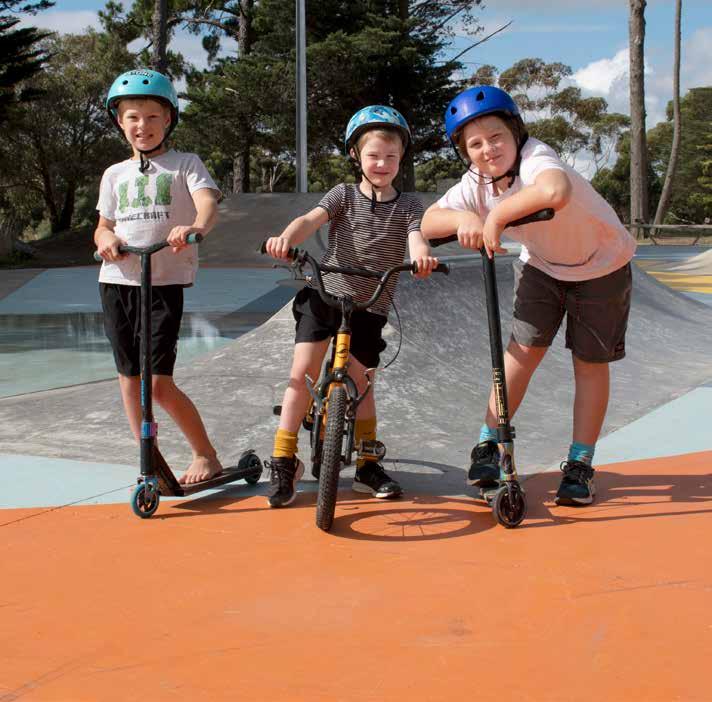
INTRODUCTION and economic factors
This broad range of community services and infrastructure for residents supports the wellbeing and prosperity of the Golden Plains Shire community. Council’s Vision, Strategic Objectives and strategies to further improve services and facilities are detailed in the Council Plan 2021-2025 and the Council Budget 2021/22 and reported upon in the Annual Report 2021/22.
The delivery of services, facilities, support and advocacy to achieve the Strategic Objectives is measured by a set of service performance indicators and measures. Council also has a wide range of responsibilities under Victorian and Australian legislations.
For more information on Council services, refer to the Our Performance section of the Annual Report 2021/22.
Economic Factors
Like municipalities across Australia during 2021/2022, Golden Plains Shire residents and business owners continue to experience one of the most challenging economic periods in our history.
While Council still awaits the statistical economic modelling by the various reporting agencies, the results are very likely to portray a considerable downturn in the economy of the Shire.
• The Gross Regional Product of Golden Plains Shire was $703,266 million in 2021, marginally up on the 2020 period. The three highest industry sectors were Agriculture (20.8%), Construction (18.0%), and Rental, Hiring & Real Estate Services (17.3%).
• In the March 2022 quarter, the unemployment rate in Golden Plains Shire was 1.9%. This is down from the 2020 average unemployment rate of 3.5%,
• The business community in Golden Plains Shire grew with 593 new businesses established in 2021/22 . This figure is up on 2020/21, when a total of 393 new businesses were established.
• The population of Golden Plains Shire in 2022 is 24,879, an increase of 587 people since 2021. At a rate of 2.4% in 2022, the growth rate is the same as the 2021 figure of 2.4%.
• Renewable energy in Golden Plains Shire continues to be prominent with the Mt Mercer Wind Farm commissioned in 2013, the completion of Berrybank 1 Wind Farm and comencement of construction of the Berrybank 2 Wind Farm in 2021/22, alongside the imminent commencement of construction on the Golden Plains Wind Farm. The combined total of 361 turbines will generate a total of approximately 1,281,000 KWh, producing enough energy to power approximately 240,000 homes. Council assists in administering grant funding from windfarm operators to support a wide range of social, community and economic benefits for business owners and residents throughout Golden Plains Shire.
Source: REMPLANCouncil delivers more than 70 services for the people of Golden Plains Shire including waste management, planning, family and children’s services, youth programs, active ageing and inclusion services, economic and business development, and community and social infrastructure.
MAJOR CAPITAL WORKS
GOLDEN PLAINS YOUTH HUB
The Golden Plains Youth Hub in Bannockburn officially opened its doors on 12 April 2022.
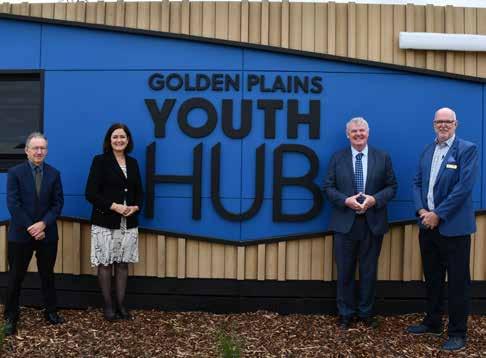
The Youth Hub project transformed a portable office building into a dedicated youth facility located opposite the Shire’s only high school, Bannockburn P-12 College. The building underwent a significant exterior and interior renovation to create a purposebuilt, accessible and inclusive Youth Hub.
The $562,000 project was delivered with $271,032 from the Victorian Government’s Growing Suburbs Fund, $100,000 for the Australian Government’s Local Roads and Community Infrastructure (LRCI) Program, $100,000 from Bannockburn & District Grants, and Council’s $90,720 in-kind contribution of the portable building. In addition,
a further $77,000 from Round 3 of the Australian Government’s LRCI Program was allocated to the interior fit out of the Youth Hub, including furniture and technology.
The Youth Hub hosts interactive programs related to music, film, art, entrepreneurship and employment pathways several days a week after school and during the school holidays. In June 2022, Council secured Victorian Government funding to partner on a new crime prevention program at the Youth Hub, featuring workshops and positive interventions that disrupt risk factors for young people, including building resilience, education, employment and training pathways.
BANNOCKBURN SOCCER FACILITY
The Bannockburn Soccer Facility Upgrade was officially opened on Sunday 15 May, delivered to support increased recreational and community options in the south of Golden Plains Shire.
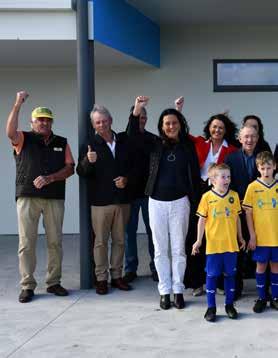
The upgrade included the construction of two new female friendly change rooms, a referee change room, first aid room and storage to service the recently constructed second soccer pitch and support current and future participation in junior and senior soccer in the growing south of Golden Plains Shire. The project also included the installation of sports pitch lighting and perimeter fencing.
The Bannockburn Soccer Facility Upgrade was a partnership project with funding from the Victorian and Australian Governments. The $1.2 million project was
funded by $832,000 from the Australian Government’s Community Grants Program and $464,535 from the Victorian Government’s 2019-20 World Game Facilities Fund.
INVERLEIGH SPORTING COMPLEX –CHANGE AND CLUB ROOMS
Two significant upgrades were completed and opened at the Inverleigh Sporting Complex in 2022.
The Inverleigh Change Rooms Project delivered the construction of two new female friendly/unisex change rooms, the refurbishment of two existing player change rooms, new umpire change rooms with supporting amenities including first aid, massage and storage spaces; and the installation of a new septic system at Inverleigh Sporting Complex.
The $1.6 million project was majority funded by $1,527,300 from the Victorian Government’s 2020 Community Sports Infrastructure program, with contributions of $42,000 from the Inverleigh Sporting Complex and $30,000 from the Inverleigh Football Netball Club.
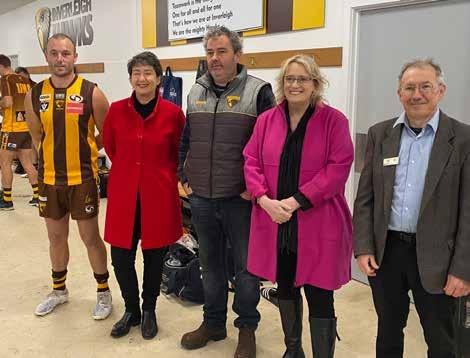
In addition, the existing club rooms at the Inverleigh Sporting Complex have been upgraded for the Inverleigh Football Netball Club and the Inverleigh community. The project has delivered a new social space, upgraded kitchen and canteen, bar and amenities. The $500,000 upgrade project was fully funded by the Australian Government.
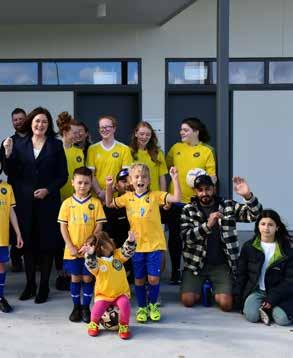
TEESDALE TURTLE BEND UPGRADE
The Teesdale Turtle Bend Reserve Upgrade project delivered a suite of new and improved facilities at the popular recreation and events precinct.

Over two years, the $480,400 upgrade has included the installation of a wider pedestrian bridge connecting the reserve’s two playgrounds, a new public toilet block with a disabled toilet and baby change facilities, additional play space elements and seating, and a new multi-sport space with a half court for netball and basketball. The project also featured a power upgrade for the site, the installation of a new septic system, and improved fencing to better support large community events.
The reserve is a valuable social meeting space for the Teesdale community and surrounding towns, attracting people to the open recreation area and outdoor events, including the Teesdale Christmas Carols, Live @ Turtle Bend Music Festival, Teesdale Community Harvest Markets and Teesdale Roots Culture Festival.
The Teesdale Turtle Bend Reserve Upgrade was a partnership project, funded by $222,000 from the Australian Government’s Building Better Regions Round 3 program; $202,000 from Global Power Generation, the proponents of the Berrybank Wind Farm; and $56,411 from Council.
BANNOCKBURN SKATE PARK

UPGRADE
A community celebration was held to mark the official opening of the Bannockburn Skate Park Upgrade on 19 March 2022.
The project delivered an upgrade to address public safety and security issues at the site and wider precinct. New skate elements include quarter pipes, ramps, boxes and rails, as well as a new shade shelter, drinking fountain, bike racks, lockers, lighting, safety signage, seating and electrical works. Repairs to the existing concrete slab and landscaping works were also completed.
The $449,900 upgrade was a partnership project, funded by a $250,000 Community Safety Infrastructure grant from the Victorian Government’s Community Crime Prevention Program, and $199,900 from the Australian Government’s Local Roads and Community Infrastructure Program.
LETHBRIDGE LIGHTING AND IRRIGATION UPGRADE
The completion of the Lethbridge Lighting and Irrigation project was marked on 8 July 2022, with representatives from the Victorian Government, Australian Government, Golden Plains Shire Council and the Lethbridge Reserve Committee of Management.
The Lethbridge Lighting and Irrigation project involved the installation of four new lighting towers at Lethbridge Recreation Reserve and a subsurface irrigation system. Works delivered a quality community sport facility catering for junior sport in Lethbridge, with the new lighting to AFL training standards (50 lux) enabling the increased use of the facility, as well as providing further opportunities for quality physical activity for the township’s children. The subsurface irrigation works addressed safety issues for users, through improving the surface condition of the oval. Works included the installation of an automatic irrigation system, tanks and pumps.
The $450,000 project was a partnership project between all three tiers of government, with $250,000 from the Victorian Government’s Local Sport Infrastructure Fund, $100,000 from the Australian Government’s Community Development Grants Program, and $100,000 from Council.

BANNOCKBURN BOWLS UPGRADE
The Bannockburn & District Bowls Club Greens Upgrade Project was completed in 2022, delivering the installation of a new bowling green, high-quality lighting, landscaping, paths, seating and shelters at the Bannockburn & District Bowls Club.
The $760,270 partnership project was funded by $370,670 from Golden Plains Shire Council, $250,000 from Sport and Recreation Victoria and $140,000 from the Bannockburn & District Bowls Club. The upgrade was officially opened on 19 July 2022.
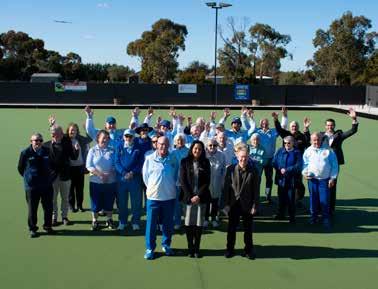
FUNDING GRANTS 2021/22
In 2021/22, Council secured a valuable collection of grants to deliver important capital works, community programs and road projects for Golden Plains Shire.
The following funding commitments were confirmed from the Australian Government:
Program Name Grant Award
Risk and Resilience Grants ProgramTeesdale Flood Study $70,000
Regional Arts Fund Round 1, 2021 Project Grants - Living Sculpture Project
$30,000
Be Connected Network - Get On-Line Week $1,000
The following funding commitments were confirmed from the Victorian Government:
Program Name Grant Award
Growing Suburbs Fund - Rokewood Community Pavilion $3,500,000
Smart Shires Network - Rural Councils Transformation Program $750,000
Safer Roads Program - Federal Blackspot Program for Meredith–Steiglitz Road, Meredith ($274,512) and Craddocks Road, Smythesdale ($328,320)
2021-22 Local Sports Infrastructure Fund - Rokewood Recreation Reserve Netball & Tennis Court Upgrade
$602,832
Risk and Resilience Grants ProgramTeesdale Flood Study
Integrated Water Management (IWM) grant program - Bannockburn Integrated Water Management Plan
$92,700
$70,000
Building Blocks Planning Grant $60,747
Waterways of the West and Rivers of the Barwon (Barre Warre Yulluk) Action Plans - Moorabool River Reserve Master Plan
COVID-19 Vaccination Program Community Engagement Grants
$60,000
$40,000
Connected and Supported Communities $39,500
2021-22 Local Sports Infrastructure Fund – Golden Plains Tracks and Trails Strategy
Municipal Emergency Resourcing Program 2021-2022 – Extension to existing program
Early Childhood Education and Care Ventilation Support Funding
Local History Grants Program Round 19, 2020-2021 -Golden Plains Stories: Community History Interactive Web Exhibition Project
Victorian Youth Fest 2022 Grant - Youth Fest: Connect, Explore, Express!
$30,000
$26,400
$18,000
$14,822
$2,000
2021 Children’s Week $700
$433,666
2021-22 Strategic Projects - Meredith BMX Facility $420,000
Free From Violence Local Government Grant Program 20222025
$384,377
Streamlining for Growth 2021-22Golden Plains Settlement Strategy $310,000
COVID Safe Outdoor Activation Fund 2021 $200,000
Engage! 2022 – 2024 program - to deliver the Learn and Lead project during 1 January 2022 – 31 December 2024.
Safer Together Program - Golden Plains and Pyrenees Shire Bushfire Resilience Grant
$150,000
$132,000
FReeZA 2022-2024 Grants Program $106,500
MAJOR ROAD PROJECTS
Bannockburn Township Entrance Safety Project
The Bannockburn Township Entrance Safety project was completed in January 2022, delivering a major roundabout to improve public safety at a problematic intersection at the entrance to the business centre of Golden Plains Shire’s largest town.
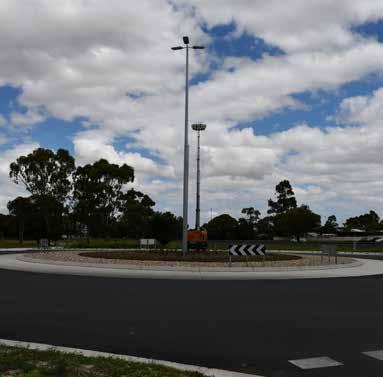
The $3.2 million project was fully funded by the Australian Government, an election commitment of the 2019 Federal Election. Council and local community groups and members had long advocated for this much-needed safety infrastructure.

The new roundabout safely controls the five entry and departure roads that meet at the intersection: Clyde Road (the main entry to Bannockburn from Ballarat); Shelford-Bannockburn Road (the main entry from Geelong
and Batesford); the Bannockburn railway line intersection with Kelly Road; and a private access driveway to the Bannockburn Station Café. The project also included concrete splitter islands at each entry to the roundabout and street lighting to VicRoads’ standards.
Franklin Bridge, Napoleons
The Franklin Bridge spans the Yarrowee River between Buninyong and Napoleons on the boundary between the City of Ballarat and Golden Plains Shire municipalities and the new $2.8 million concrete structure replaced the former one-lane bridge, estimated to be built in 1914.
Construction of the 40m bridge began in June 2020 and was completed in late 2020, when it opened to traffic. The official opening was held in March 2022,
following postponements due to COVID-19 restrictions.
The new bridge was a three-way partnership between the Federal Government, the City of Ballarat, and the Golden Plains Shire.
The Federal Government’s Department of Infrastructure Bridge Renewal Program provided $1,425,132 in funding, the City of Ballarat contributed $912,490 and the Golden Plains Shire provided $512,642.
The new bridge is wider than the previous bridge – providing two lanes for traffic which improves road safety. Previously some emergency services were forced to detour around the bridge due to its limited 10-tonne load limit, which increased their response times. The new bridge caters to a 150-tonne load allowing emergency services to take a more direct route.
Bannockburn Entrance Roundabout Franklin BridgeSlate Quarry Road Bridge, Meredith
The new Slate Quarry Road Bridge provides safer, smoother travel in Meredith.
Final construction works were completed on the $2.3 million bridge replacement project in December 2021, replacing the old load-limited bridge with a new wider bridge without load restrictions. Works also included new guardrails and improvements to the road approaches and drainage.
The new bridge eliminated a 20km detour for the estimated 25 heavy vehicles per day that travel through the local road network and has also provided emergency services better access for response vehicles to the bushland to the northeast of Meredith in the event of an emergency.
The bridge replacement project was jointly funded by $1,150,000 from Golden Plains Shire Council, and $1,150,000 from the Australian Government’s Bridges Renewal Program.

Paddys Gully Road Bridge, Rokewood Junction
The new two-lane reinforced concrete bridge crossing Mount Misery Creek on Paddys Gully Road in Rokewood Junction was reopened for traffic in December 2022. The ageing timber bridge was limited to 10 tonnes and was in poor condition, necessitating the upgrade which will now allow light and heavy vehicles full access to the crossing.
The new Paddys Gully Road Bridge was a partnership project with $261,856 from Council and $318,680 from the Australian Government’s Local Roads and Community Infrastructure Program. The project was built by Golden Plains-based Begbies Contracting following a competitive tender process.
 Paddys Gully Road Bridge
Slate Quarry Road Bridge
Paddys Gully Road Bridge
Slate Quarry Road Bridge
Meredith-Shelford Road, Meredith
The Meredith-Shelford Road Widening Project commenced in 2020, with funding from the Australian Government’s Roads to Recovery Program. Since 2020, three stages of works have been undertaken to widen and resurface approximately six kilometres of Meredith-Shelford Road, with Stage 3 of the project completed in January 2022.

The widening of Meredith-Shelford Road supports a safer and more efficient transportation network for Golden Plains Shire and establish better access the nearby Golden Plains Food Production Precinct. At a total of $4.38 million, the road widening project has been supported by the Australian Government, with $1.95 million from the Roads to Recovery program and $1.65 million in LRCI phase 3 funding, alongside
$783,333 from the Victorian Government’s AgriLinks Upgrade Program.
Stage 4 and 5 will include the widening of approximately 4.65 kilometres of Meredith-Shelford Road south of Meredith, alongside major culvert upgrade works and the installation of guard fencing, completing the staged 10.5-kilometre upgrade of the road. The final two stages of the project are funded by phase three of the Australian Government’s Local Roads and Community Infrastructure (LRCI) Program.
Guardrails across Golden Plains
Throughout 2021, new guardrails were installed across the Shire to help keep drivers safe on Golden Plains roads.
Council received $200,000 from Round Two of the Australian Government’s Local Roads and Community Infrastructure Fund to

complete the works in 13 locations, which saw the installation of new guardrails alongside the repair and replacement of damaged and non-compliant guardrails.
New guardrails were installed on Ross Creek-Haddon Road in Haddon, State Forest Road in Ross Creek, Linton-Piggoreet Road in Piggoreet, Denison Street in Linton, and at two locations on MeredithMt Mercer Road in Meredith. Non-compliant guardrails were replaced in Rokewood at three locations on Wurrook Road and one location on Gilletts Road; while repair works were completed on damaged guardrails on Racecourse Road in Haddon and in two locations on Teesdale-Inverleigh Road in Inverleigh.
major changes
The COVID-19 Pandemic
For the third year, the COVID-19 Pandemic continued to play a prominent role in the lives of the people of Golden Plains Shire, as it did around the world. Council promoted and supported the state-wide vaccination and booster programs, including assisting local residents obtain vaccination certification and community transport to vaccination appointments.
With the emergence of new COVID-19 variants, Council adapted to accommodate lockdowns and work from home arrangements, while continuing to deliver its many services and programs for the Golden Plains Shire community.
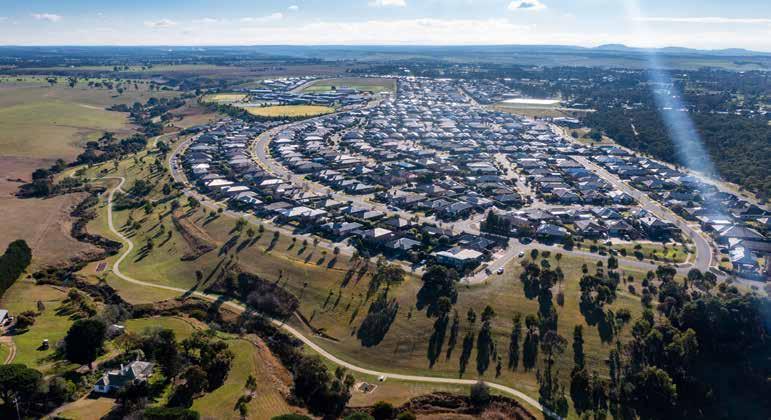
When restrictions allowed working on-site, the Golden Plains Civic Centre and the newly-renovated offices at The Well in Smythesdale provided COVIDSafe, sociallydistanced work environments.
Council Plan 2021-2025
With the Council Plan 2021-2025 adopted in June 2021, it was a busy first 12 months for Council, shifting focus to deliver the priority initiatives and actions for Council services, infrastructure and advocacy under the new strategic plan.
Developed in accordance with the Strategic Planning Principles of the Local Government Act 2020, the Council Plan 2021-2025 details 21 Strategic Objectives, with 83 key actions for delivery during the four-year Council term.
The Council Plan 2021-2025 directly addresses and aligns with the Themes of the Golden Plains Community Vision 2040: Community, Liveability, Sustainability and Prosperity; with the additional theme of Leadership added to represent the Council-specific regulatory, governance, leadership and advocacy activities required to achieve outcomes for the community.
The achievements of the first year of the Council Plan 2021-2025 are detailed in the Our Performance section of the Annual Report 2021/22.
State Electoral Boundaries
Council welcomed the changes to the State Electorate boundaries, announced in October 2021.
The new boundaries confirmed by the Electoral Boundaries Commission will see Golden Plains Shire represented in the Ripon, Geelong and Eureka electorates; a change from the former split between the Districts of Buninyong and Polwarth.
Communities in the Shire’s north including Linton, Scarsdale, Smythesdale, Haddon, Ross Creek and Napoleons will move out of the abolished seat of Buninyong into the District of Ripon.
The south-eastern growth area around Bannockburn, Russells Bridge and Gheringhap will sit in the District of Geelong after shifting out of the District of Polwarth.
The remainder of the Shire which is currently split between the seats of Buninyong and Polwarth will now be joined together in the new District of Eureka. This includes Wallinduc, Rokewood, Shelford, Teesdale, Inverleigh, Dereel, Enfield, Meredith and Lethbridge.
The Rating Strategy
In February 2022, Council adopted the Rating Strategy 2022-2026, following a comprehensive review of its rating system.
The new Rating Strategy was informed by community consultation at a special series of Councillor Conversation Posts across the Shire in December 2021 and feedback on Council’s Rating Strategy Propositions Paper. Changes were actioned to differentials on vacant land, businesses in Bannockburn, and broadacre and intensive farm
land; as well as a decrease in the Municipal Charge for all properties. The new rating system came into effect in the 2022/23 budget year.
Planning for Growth
In 2021/22, population growth continued to be a significant change for Golden Plains Shire communities, with the Shire’s population reaching 24,985, as it moves steadily towards the projected population of 42,193 people in 2041. Council is committed to quality strategic planning, in consultation with community members, to ensure positive growth for new and existing residents.
In October 2021, the Bannockburn Growth Plan was incorporated into the Golden Plains Planning Scheme (the Scheme), following approval by the Minister for Planning. The Growth Plan guides the sustainable growth of Bannockburn to the year 2050, catering for 18,000 new residents, and was prepared by the Victorian Planning Authority (VPA) in consultation with Council, government agencies and the community.
In February 2022, Council secured significant funding from the Victorian Government to undertake the Golden Plains Settlement Strategy (GPSS). Responding to an identified need for an integrated long-term plan to manage growth and development across the municipality, the GPSS has three main objectives: to identify settlement areas suitable for development, to determine the appropriate level of growth across the Shire, and the density of growth in those locations where it is supported. Work on the GPSS including community consultation will continue in 2022/23.
Organisational and Operational changes
Aged and Disability Services
On 30 June 2022, Council exited the delivery of aged and disability care services in Golden Plains Shire.
This decision was prompted by significant Commonwealth Government reforms to the aged care system and followed more than six months of analysis and consideration by Council including the preparation of a Best Value Review, inclusive of staff and community consultation.
The impacted services were home and community care services to assist older people, those recovering from acute care and people with disabilities to continue to live independently in the community, including the Commonwealth Home Support Programme (CHSP) and Home and Community Care for Younger People (HACCPYP).
Service clients and their families were supported through the transition by Council management and the Active Ageing & Inclusion team, with new dedicated providers, Silverchain and mecwacare, starting delivery of services on 1 July 2022.
Council continues to maintain an Active Ageing & Inclusion team, that reflects a strong objective of Council to enhance the range of programs and support it offers to older people in Golden Plains Shire.
Restructure of Directorates
In October 2021, Council implemented a restructure of the Community Services directorate, following a review and consultation with all staff.
A new Community Development team was created in the Recreation & Community Development Department, bringing together positions dedicated to arts and culture, community partnerships, corporate strategic planning, and the Golden Plains Farmers’ Market. The Youth Development and Health & Wellbeing teams were integrated into one unit named the Health, Wellbeing & Youth team and moved into the Community Wellbeing Department. The Child & Family Services team was relocated to report directly to the Director Community Services, before a realignment as an independent team under the newly-created Manager Child & Family Services position.
In December 2021, Council undertook an organisational review of the Corporate Services functions to support and respond to the findings from the recent employee survey and the workplace culture and wellbeing review, and to deliver on the changing needs of the organisation and the Shire.
The Organisational Capability and Performance unit was established to include the People & Culture, Occupational Health and Safety, and Governance and Risk teams, as well as the functions of Business Improvement. The Customer Service team (later renamed the Customer Experience team) was relocated to report directly to the Director Corporate Services.
Changes in Leadership
In 2021/22, two valued members of the Senior Management Team departed Council, following three years of dedicated service to the organisation and the community.
Director of Community Services Lisa Letic departed Golden Plains Shire Council for a directorial position at a large Melbourne council in August 2021, and Director of Corporate Services Philippa O’Sullivan departed Council in January 2022 to return to a leadership position in the water authority sector.
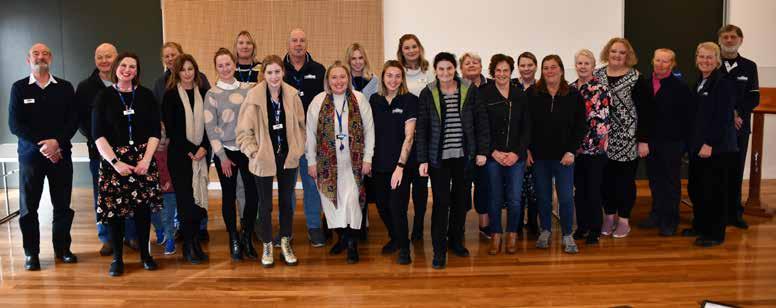
Council welcomed Steven Sagona as its new Director of Community Services and Simon Rennie as its new Director of Corporate Services, who joined CEO Eric Braslis and Director of Infrastructure and Development Phil Josipovic to
lead the organisation as the Senior Management Team.
Council Connections
In May 2022, Smythesdale was host to a meeting of Council for the first time. Held at The Well, Council’s office and community meeting hub, the meeting was livestreamed and open to the public. In 2021/22, Council meetings were also held at the Linton Shire Hall, the Golden Plains Civic Centre in Bannockburn, and online, with residents welcome to virtually participate in Public Question Time.
Like many businesses and organisations, Council has developed its online and virtual engagement opportunities this year to ensure residents continue to be able to participate and have their say despite COVID restrictions, as well as bridging the physical distance across the Shire. Councillor Conversation Posts were held online, as well as virtual workshops and engagements as part of key community consultation on important projects, plans and strategies this year.
major achievements
In 2021/22, Golden Plains Shire Council and the people and communities it serves continued to grow, strengthen and celebrate great achievements. In addition to the many projects and milestones detailed in the Major Capital Works, Major Road Projects and Major Changes sections of the Annual Report, Council marked significant success in advocacy, strategic and future planning, and delivery of community infrastructure.
Advocating for Golden Plains Shire
Lobbying and advocacy for the people and communities of Golden Plains is a key focus of Council and significant funding for several pivotal Priority Projects were secured in 2021/22.
The Federal Election was held in May 2022, with the Federal Electorate boundary changes placing part of Golden Plains in the Ballarat electorate and a smaller portion of the south-east of the Shire in the Corangamite electorate. The Australian Labor Party was elected to government and following Council’s extensive lobbying to major party candidates,
communities in Golden Plains Shire will receive funding for seven community projects totaling $3.61 million. The projects that received Federal Election commitments were: Linton Recreation Reserve Oval Reconstruction, Woady Yaloak Recreation Reserve Oval and Netball Court Lighting in Smythesdale, Maude Community Hub, Inverleigh Active Youth Space, Victoria Park Netball Pavilion in Bannockburn, Bannockburn Family Services Centre and Inverleigh Primary School Indoor Basketball Court.

In addition to these election commitments, Council secured funding for a diverse collection of projects including the Rokewood Community Hub, Rokewood Recreation Reserve Netball and Tennis Court Upgrade, Golden Plains Shire Tracks and Trails Strategy, Teesdale Flood Study, Golden Plains Transport Connection Study, a public artwork in Linton, a community safety program at the Golden Plains Youth Hub, Black Sport funding for road safety projects in Meredith and Smythesdale, Leighdale Equestrian Centre Upgrade, goal netting at Victoria Park in Bannockburn and Lethbridge Cricket Net Upgrade.
In March 2022, Council welcomed the allocation of $1.3 million to the Shire in the Federal Budget. The funding comes with the extension of Phase 3 of the Australian Government’s Local Roads and Community Infrastructure (LRCI) Program and Council will be able to access the extension funding from July 2023. The latest allocation adds to the $5.5 million that Council has received over the past two years under the first three phases of the LRCI program.
The Peri Urban Group of Rural Councils (PUGRC) is an alliance of six councils with fast-growing populations that are located bordering major cities, committed to advocating for support and solutions for the Victorian peri urban region, at the local, state and national level. From December 2020 to November 2021, Mayor Cr Helena Kirby served as Co-Deputy Chair of the Peri-Urban Group of Rural Councils.
In 2020, the councils of the PUGRC were accepted for eligibility funding under the Victorian Government’s Growing Suburbs Fund. In 2021/22, Council secured its third commitment from this program
– and its largest ever single grant – $3.5 million for the Rokewood Community Hub. The Golden Plains Youth Hub, officially opened in April 2022, was the first project funded in the Shire under the Growing Suburbs Fund.
Delivering for the Shire
This year was a busy and successful year of delivery for Golden Plains Shire Council, with an impressive list of infrastructure projects and upgrades completed and opened in 2021/22. Completed projects delivered for the community include: Golden Plains Youth Hub, Bannockburn Soccer Facility Upgrade, Inverleigh Sporting Complex Change and Club Rooms, Teesdale Turtle Bend Upgrade, Bannockburn Skate Park Upgrade, Bannockburn Bowls Upgrade, Lethbridge Lighting and Irrigation, Lethbridge and Linton cricket net facilities and Enfield and Garibaldi playgrounds.
Council’s commitment to deliver road infrastructure projects continued with new bridges opened in Napoleons, Meredith and Rokewood Junction, and the Meredith-Shelford Road upgrade and guardrail installation program. The Federal Government delivered on its election promise of 2019 with the installation of the new $3.2 million roundabout at the entrance of Bannockburn and Council looks forward to the start of construction of the roundabout at the Midland Highway and Clyde Road intersection in Bannockburn, which was promised by the Federal and Victorian Governments in July 2020.
Planning for the Future
In 2021/22, Council completed an extensive suite of strategic plans to meet the requirements of the Local Government Act 2020 and the Council term.
Building upon the Council Plan 2021-2025 which was adopted in June 2021, the following plans were developed and adopted for the new Council term: Domestic Animal Management Plan 20222025, Road Management Plan 2021-2025, and Municipal Public Health and Wellbeing Action Plan 2021-2025.
The Local Government Act 2020 detailed a list of required plans and policies for councils. Golden Plains Shire Council actioned a number of these requirement in 2020/21 including the Golden Plains Community Vision 2020, Community Engagement Policy and Revenue and Rating Plan. In 2021/22, this program of work was completed including the Long-Term Financial Plan 2021/222030/31, Workforce Plan and Asset Plan 2022-2032.
In addition, Council collaborated with the community to develop and adopt a number of important strategic plans in 2021/22.
The plans and policies included: Customer Experience Strategy 2022-2026, Council Budget 2022/23, Northern Streetscapes Framework Plan 2022, Arts, Culture & Heritage Strategy 2022-2026, Mobile Traders Policy, Rabbit Management Strategy and Action Plan 2021-2031, Woady Yaloak Equestrian Centre Master Plan 2022-2032, Golden Plains
Transport Connections Study, Teesdale Flood Study, Smythesdale Structure Plan, Inverleigh Tree Succession Plan and Governance Rules.
In July 2022, Council declared a Climate Emergency and committed to preparing a Climate Emergency Plan to put the declaration’s words into action. The Climate Emergency Plan will develop a comprehensive list of actions and address the resources required to implement these recommendations.
Extensive community consultation in March and April 2022 has informed the development of the Draft Climate Emergency Plan 2022-2032. The final plan will return to Council for adoption in late 2022.
VISION&VALUES
Where people ma�er
Communi�es are connected And the future is bright
PRIDE RESPECT
We know that our work is important, and we take pride in doing the best job we can.
We treat each other with courtesy and respect, and are commi�ed to keeping our environment safe, and free from judgement.
INTEGRITY
We are commi�ed to being authen�c, honest and ethical in our work.
COLLABORATION EXCELLENCE
We partner together to achieve shared goals and deliver community focussed outcomes.
We are commi�ed to delivering the best community experience and outcome that we are capable of providing.
• We take accountability for ac�ons and results.
• We recognise and celebrate our achievements.
• We lead our staff with trust and empowerment.
• We approach our work with energy and enthusiasm.
• We are inclusive and appreciate our diversity.
• We show compassion and kindness to one another.
• We bring a posi�ve mindset to work, and contribute to a posi�ve culture.
• We do what we say, and honour our commitments.
• We use open and transparent communica�on.
• We speak up when we see behaviours that compromise our values.
• We build and maintain produc�ve rela�onships.
• We work resourcefully and united by shared goals.
• We work as a team to bring out the best in each other.
• We conduct our work with professionalism.
• We seek opportuni�es to innovate and con�nuously improve.
• We effec�vely respond to the changing needs of the community.
our
Golden Plains Shire is situated between Victoria’s two largest regional cities, Geelong and Ballarat, with a population of 24,985 people across 56 vibrant rural communities.
Renowned for its award-winning food and wine, iconic music festivals, goldfield heritage and friendly communities, Golden Plains Shire is an attractive destination both to visit and to call home.
New residents, particularly young families, are attracted to the area’s rural lifestyle, affordable housing and proximity to the services and jobs available in the Shire, as well as those in Melbourne, Geelong, Ballarat and the Surf Coast.
Residents value the character of Golden Plains’ small townships and communities, local facilities and services, and natural environment.
As one of the fastest growing regions in rural Victoria, boasting rich biodiversity and a broad range of flora and fauna, Golden Plains Shire has much to offer.
Golden Plains also offers many opportunities for businesses, investment, sustainable development and employment, with more than 4,649 businesses including farming, construction, retail and home-based businesses.
The Shire has a strong agricultural sector, with a history of wool, sheep and grain production. Now-a-days the Shire is seeing strong growth in intensive agriculture, including poultry, pigs, beef and goat dairy, as
well as the expansion of viticulture in the Moorabool Valley. This in turn has driven an increase in the regions tourism offering, with visitors attracted to the region’s picturesque wineries, gourmet food producers, agri-tourism and the monthly Golden Plains Farmers’ Market.
Golden Plains Shire is one of the leading producers of eggs and chicken meat in Victoria, producing nearly a quarter of Victoria’s eggs. Council is encouraging continued growth and investment in intensive agriculture, by establishing the Golden Plains Food Production Precinct, near Lethbridge, which is on track to become one of Victoria’s premier areas for intensive agriculture development and expansion.
Council is recognised for engaging with its communities to build community spirit and plan for growth and future facilities and services. Residents continue to support their townships, with high levels of participation in clubs, activities and volunteering.
Looking to the future, Golden Plains Shire residents have shared their vision and priorities for the next 20 years through the Community Vision process. They identified the need to plan and manage the competing interests of a growing
population whilst maintaining the Shire’s highly valued rural character, meet community service and infrastructure needs, and maintain and improve the Shire’s extensive road network.
Golden Plains Shire Council
Bannockburn Customer Hub 2 Pope Street, Bannockburn Victoria 3331
Local call: 1300 36 30 36
Phone: (03) 5220 7111 Fax: (03) 5220 7100
Smythesdale Customer Hub - The Well
19 Heales Street, Smythesdale, Victoria 3351
Local call: 1300 36 30 36 Phone: (03) 5321 1500 Fax: (03) 5220 7100
Postal Address
Golden Plains Shire Council, PO Box 111, Bannockburn, Victoria 3331 Email enquiries@gplains.vic.gov.au
After Hours
To contact Council outside normal business hours, call (03) 5220 7111
Councillors
Mayor cr gavin gamble
As a Teesdale local of 18 years, Cr Gavin Gamble has a long history of active community involvement in the Shire, including as a Community Coordinator and Cub Scout leader,
cr les rowe
Cr Les Rowe is a life-long resident of Sutherlands Creek, where he and his family farm properties in the Moorabool Valley, near the land his ancestors settled more than 160 years ago.
Cr Rowe is a strong advocate for the local agricultural industry and rural communities. Serving his second term as a Councillor, he is dedicated to improving the local road and bridge network, community consultation, supporting local businesses and job creation, and Council delivering on the Community Vision 2040.
Cr Rowe is a Corporate Services Portfolio Councillor and Council’s representative on the Geelong Heritage Centre Collection Advisory Committee, Golden Plains Municipal Fire Management Planning Committee and the G21 Education & Training and Arts, Heritage & Culture Pillars.
on Friends groups and the Turtle Bend Committee of Management, and with sporting clubs. He has professional experience as a school teacher, brewer and now operates his own gardening business across Golden Plains Shire.
Serving his first term as a Councillor, Cr Gamble was elected Mayor for 2021/22.
Cr Gamble is a member of the Australian Greens and is passionate about pursuing action to address climate change, protecting
cr owen sharkey
Cr Owen Sharkey is a resident of Batesford who brings career experience from the construction and housing industry to his role in Council. Elected to serve his second term as a Councillor, Cr Sharkey was Mayor of Golden Plains Shire in 2018/19 and 2019/20.
Cr Sharkey is dedicated to supporting local youth, cultural diversity and business development, with a focus on recovery from the COVID-19 pandemic. His priorities for Council include maintaining strong regional partnerships, highlighting the challenges for peri urban municipalities and advocating for an improved rating structure.
Cr Sharkey is a Community Services Portfolio Councillor and Council’s representative on to the Municipal Association of Victoria and its Human Service Committee, as well as the Geelong Regional Library Corporation Board.
the Shire’s unique biodiversity, responsible development and township enhancements, provision of greater transport and recreational options, and support for cultural and wellbeing initiatives.
Cr Gamble is an Infrastructure and Development Portfolio Councillor and Council’s representative on the Grampians Central West Waste and Resource Recovery Group, the G21 Environment Pillar and the Municipal Association of Victoria’s Transport and Infrastructure Committee and Environment
cr clayton whitfield
Cr Clayton Whitfield has lived in Inverleigh for the past 14 years and brings managerial skills and statutory knowledge from his experience in the domestic building sector, as a Trade Section Commander in the Army, a vocational educator at The Gordon, and a building consultant.
Cr Whitfield is passionate about improving Council’s asset maintenance and budget efficiency, supporting youth in rural areas and community consultation. He sees balancing the Shire’s population growth while maintaining rural appeal as a focus for council.
Cr Whitfield is s Corporate Services Portfolio Councillor and Council’s representative on the Municipal Association of Victoria’s Emergency Management Committee and the G21 Education Pillar.

Cr Ian Getsom
Cr Ian Getsom is a long-term Piggoreet resident, living on a rural property farmed by his sons. He has volunteered for almost 40 years with the CFA and is the President of the Happy Valley community hall. With a career in transport, he worked as a train controller during his 15 years on Victorian railways and now drives school and charter bus runs in the north of the Shire.
Cr Getsom prides himself on being an approachable Councillor and looks forward to building strong working relationships with the Council staff. He is passionate about boosting services across the many townships of the Shire and improving the vitality of its villages.
Cr Getsom is a Community Services Portfolio Councillor. He is also Council’s representative on Timber Towns, Ballarat Regional Landfill Monitoring Committee and the G21 Transport Pillar.
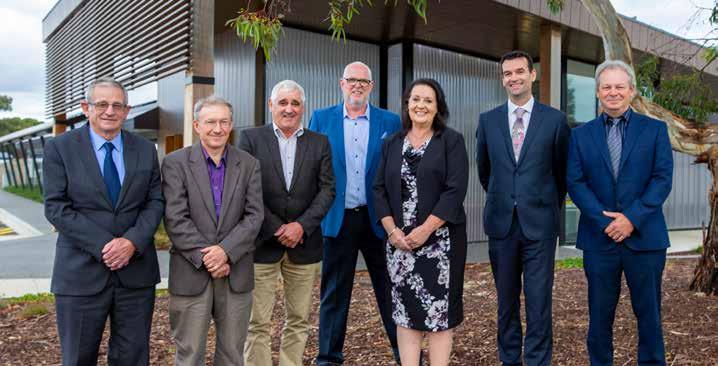
Deputy MAYOR CR Helena Kirby
Deputy Mayor Cr Helena Kirby has lived in Rokewood for 30 years and with her family, she owns and operates the Rokewood Take Away store. Serving her fourth consecutive term as a Councillor, she was elected Deputy Mayor for 2021/22, having previously served as Maoyr 2020/2021 and 2017/18.
Cr Kirby is passionate about ensuring equity of services in the Shire’s small towns, community consultation and engagement, and community planning. During the Council term, she is focused on economic development, activating community spaces including local halls and playgrounds, and protecting the rural lifestyle of Golden Plains Shire.
Cr Kirby is a Community Planning and Growth Portfolio Councillor. She is Council’s representative on the Peri Urban Group of Rural Councils, Golden Plains Disability Access & Inclusion Committee and Rural Financial Counselling Service – Colac Local Reference Group.
cr brett cunningham
A resident of Bannockburn of 8 years, Cr Brett Cunningham previously called Teesdale home for 30 years. He has professional experience in marketing, corporate services and stakeholder relations roles. Cr Cunninghams is a former chairperson and current board member of Bannockburn & District Grants Inc. and chairperson of the Bannockburn and Surrounds Neighbourhood Watch.
Cr Cunningham is dedicated to strengthening confidence in Council, building community support through transparency, implementing a positive culture and has been an active participant in the increase of community engagement in this Council term.
He is focused on developing youth and mental health services, greater road funding and improved facility maintenance.
Cr Cunningham is a Community Planning & Growth Portfolio Councillor. He is Council’s representative on the Tourism Greater Geelong and Bellarine Board and serves on the G21 Economic Development and Health and Wellbeing Pillars.
Left to right: Cr Ian Getsom, Mayor Cr Gavin Gamble, Cr Les Rowe, Cr Brett Cunningham, Deputy Mayor Cr Helena Kirby, Cr Owen Sharkey, Cr Clayton Whitfield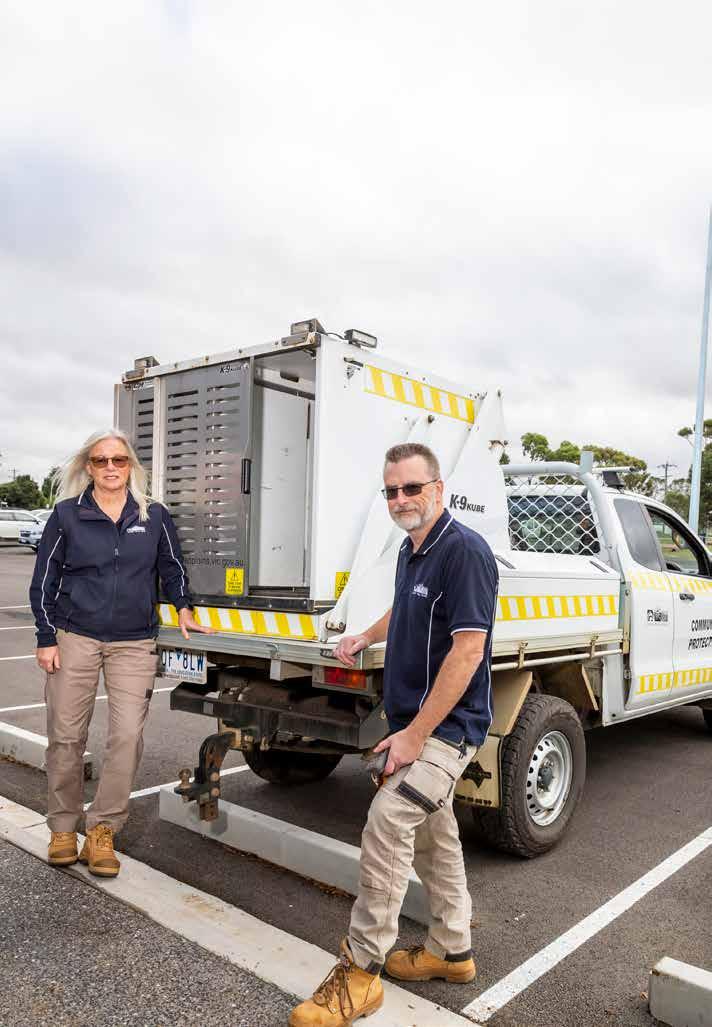
senior management team
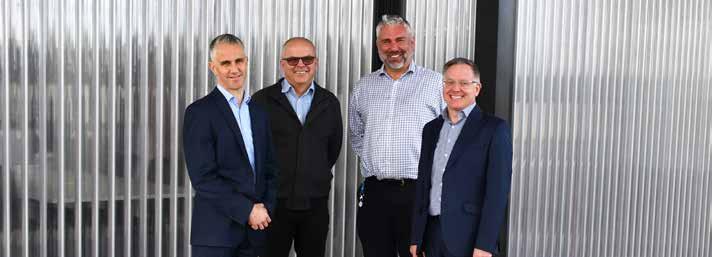
Council is the governing body that appoints a Chief Executive Officer (CEO). The CEO has responsibility for the day-to-day management of operations in accordance with the strategic directions of the Council Plan.



The areas of responsibility held by members of SMT are listed under the CEO and the Directors.

VISION&VALUES
Where people ma�er
Communi�es are connected And the future is bright
PRIDE RESPECT
We know that our work is important, and we take pride in doing the best job we can.
We treat each other with courtesy and respect, and are commi�ed to keeping our environment safe, and free from judgement.
INTEGRITY
We are commi�ed to being authen�c, honest and ethical in our work.
COLLABORATION EXCELLENCE
We partner together to achieve shared goals and deliver community focussed outcomes.
We are commi�ed to delivering the best community experience and outcome that we are capable of providing.
• We take accountability for ac�ons and results.
• We recognise and celebrate our achievements.
• We lead our staff with trust and empowerment.
• We approach our work with energy and enthusiasm.
• We are inclusive and appreciate our diversity.
• We show compassion and kindness to one another.
• We bring a posi�ve mindset to work, and contribute to a posi�ve culture.
• We do what we say, and honour our commitments.
• We use open and transparent communica�on.
• We speak up when we see behaviours that compromise our values.
• We build and maintain produc�ve rela�onships.
• We work resourcefully and united by shared goals.
• We work as a team to bring out the best in each other.
• We conduct our work with professionalism.
• We seek opportuni�es to innovate and con�nuously improve.
• We effec�vely respond to the changing needs of the community.
council staff
Workforce
At 30 June 2022, Golden Plains Shire Council employed 222 people (in full-time, part-time and casual employment) in a diverse range of positions, including Engineering, ICT, Customer Experience, Maternal and Child Health, Finance, Active Ageing & Inclusion, Youth Development, Sports and Recreation, Community Development, Roads and Drainage, Town Maintenance, Planning, Communications and Engagement, and Management.
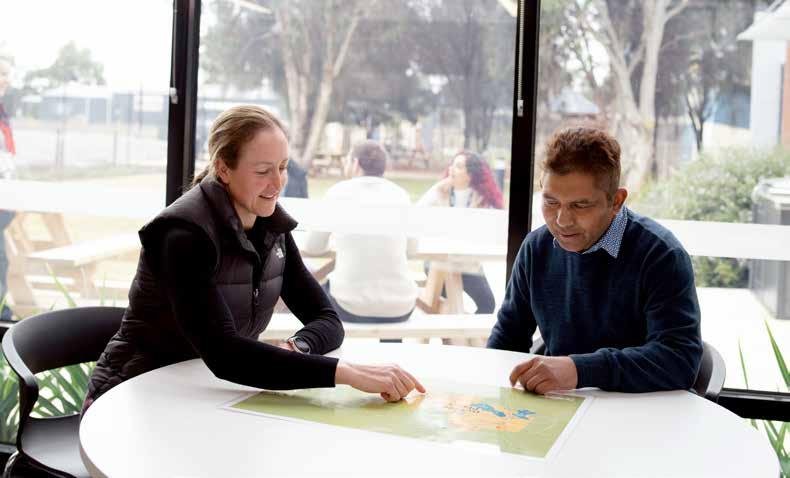
At 30 June 2022, Council’s workforce consisted of 132 full-time (126 permanent and 6 temporary), 77 part-time (73 permanent and 4 temporary)
and 13 casual employees, which equates to 178.64 FTE.
The FTE budgeted for 2021/2022 was 183 FTE. The actual FTE was less due to the exit of Aged Care Services (30 June 2022) and vacant roles. The budgeted FTE for 2022/2023 is 188.02 FTE.
See tables 1 and 2 on page 62 for a detailed breakdown of employees by division and employment classification.
Unfilled positions have not been included in the FTE figures in Table 1.
The average age of Council’s workforce is 46.8 years. More than half the workforce is between the ages of 35 and 54 years, with
31.5% of staff members aged 45 to 54 years, and 29.3% aged 35 to 44 years. This is followed by 18.9% of staff aged 55 to 64 years; with only 1.8% of Council’s workforce aged 20 to 24 years.
The generational profile of Council’s workforce has remained consistent over the past few years with relatively small changes to the age demographic of the workforce, which is in line with nation-wide trends of ageing populations and workforces. Council’s Workforce Plan includes measures to address Council’s generational profile.
Employment type by gender is represented as female and male, with no staff identifying as nonbinary. The permanent full-time
workforce is made up of 59% males (consistent with 2021/2022). Council’s part-time workforce is predominantly female at 94% (up from 91% in 2021/2022), with 64% of women employed part-time by Council engaged in the Community Services directorate. The casual workforce is predominantly female at 84.6%
Voluntary permanent staff turnover was 17.81%, including two retirements. Allowing for the redundancies associated with the exit of Aged Care Services, this figure is adjusted to 22.90%.
Aged and Disability Care Services
On 30 June 2022, Council withdrew as a direct service provider of Commonwealth- and State-funded in-home community aged and disability care services. This decision was prompted by significant Commonwealth Government reforms to the aged care system and followed more than six months of analysis and consideration by Council including the preparation of a ‘Best Value Review’ inclusive of staff and community consultation. Council continues to maintain an Active Ageing & Inclusion team, that reflects a strong objective of Council to enhance the range of programs and support it offers to older people in Golden Plains Shire.
Recruitment
Council advertised 137 positions during 2021/2022, attracting a total of 1,084 applications. Compared to 2020/2021, vacancies were higher and applicant numbers were lower. Both of these findings are consistent with the national trends regarding recruitment and is linked to postCOVID-19 workforce movements.
Vacancies across the Directorates are detailed below and included 2 Director, 5 Manager, and 11 Coordinator positions:
• Community Services – 56
• Corporate Services – 28
• Infrastructure & Development – 42
• Office of Chief Executive Officer – 11 Council received an average of 8 applications per vacancy, with 84 applications received for a Graduate Engineer position, and a total of 41 applications for the Customer Experience Officer vacancies advertised throughout the year.
There has been a noticeable reduction in the number of applicants for many positions, noting that it is particularly challenging to fill roles in the Statutory Planning, Engineering, and Maternal and Child Health teams. Council’s Workforce Plan includes initiatives aimed to address Council’s talent attraction and will be implemented across 2022/2023.
Thirty-four positions were filled by internal applicants who applied for career advancement or to gain additional opportunities, a number that is anticipated to increase as Council builds programs around internal development and succession planning.
At 30 June 2022, Council had 10 active vacancies in various stages of the recruitment process, with 4 new employees appointed prior to 30 June who commencing in July and August 2022.
0.56 2.25 0.40 49.39
1.98
79.45
11.44
1.81 0.49 2.30
0
1.34 21.56 22.90
4 18.21 8.89 27.10
5 26.87 9.00 35.87
6 16.04 16.00 32.04
7 13.74 14.00 27.74
3.90 0 3.90
4.95 0 4.95 Maternal and Child Health
3.84 0 3.84
7.00 11.00 18.00
97.70 80.94 178.64
equal employment opportunity program
Council supports removing barriers to participation and making reasonable adjustments to ensuring that no existing staff member or potential employee receives less favourable treatment on the grounds of their race, gender identity, lawful sexuality/ sexual orientation, marital or relationship status or family responsibilities, body, ability, age, belief, spirituality, employment, industrial or political activity cultural background or identity, or any other attribute and association with these definitions.
Valuing the experience and contribution every individual can bring to help us deliver its services to the community, Council acknowledges the need to review its policies, procedures and practices on a continuous basis to maintain its efforts to remove any direct and indirect discrimination. Council and has made these policies and procedures accessible digitally to all staff via the Intranet and in other forms, as and when required.
As part of its commitment to equal opportunity, over the last year Council has undertaken the following actions:
• All staff undertake EEO education as part of the onboarding and induction process with Council, delivered as an online module via Council’s Learning Management System, re-completed by staff every two years.
• Implementation of the action plan developed to implement the VAGO report into Sexual Harassment in Local Government has occurred, including online training module for new employees as part of the onboarding and induction process, supported by a faceto-face training program to be undertaken every two years.
In the event a complaint arises, Council ensures that such matters are dealt with promptly and confidentially through a formal investigation process.
Victorian Auditor-General’s Office on Sexual Harassment in Local Government
In June 2020, Golden Plains Shire Council staff and Councillors were invited to participate in a survey conducted by the Victorian Auditor General’s Office (VAGO) on Sexual Harassment in Local Government. In the findings, VAGO
concluded that Councils were not providing workplaces which are free from sexual harassment and that more than one in four survey respondents had experienced sexual harassment in the last 12 months.
The report provided 11 recommendations to Victorian local councils and 1 to the Department of Jobs, Precincts and Regions, in relation to identifying and acting on risk factors, regularly collecting data on the prevalence of sexual harassment and the development of regular data collection methodology. All recommendations VAGO made were accepted by Golden Plains Shire Council and an action plan has been developed by Council to incorporate these recommendations and also the requirements of the Gender Equality Act 2020 due to the close alignment. Progress against the action plan will be reported on a quarterly basis to Council’s Audit and Risk Committee.
Golden Plains Shire Council is an Equal Opportunity and Child Safe Employer. As such, the organisation is committed to providing and promoting a work environment which embraces diversity and inclusion by embedding the principles of Equal Employment Opportunity (EEO) into every work practice.
other staff matters
Enterprise Bargaining Agreement
Negotiation for the Enterprise Agreement began in earnest in February 2022. The bargaining committee have been meeting regularly, with a focus on consolidating the Enterprise Agreement for 2022 and beyond which has required time to achieve the right outcome. The bargaining committee is focused on additions and changes to the Enterprise Agreement that will support excellent outcomes for the employees of Golden Plains Shire, whilst ensuring the Council is committed and able to achieve it vision and objectives.
It’s anticipated that the Enterprise Agreement will be resolved in the first quarter of 2022/2023.
WORKFORCE PLAN
The new Local Government Act 2020 required all Councils to develop a four-year Workforce Plan that identifies the people and workforce required to deliver our Council Plan commitments and daily operations.
Council developed a Workforce Plan in December 2021 through the identification, analysis and planning for the organisation’s needs, to ensure the organisation has the right people, in the right place, with the right capabilities, at the right time.

The Workforce Plan is aligned to the Council Plan 2021-2025 and will ensure Council’s workforce is enabled to achieve these objectives, as well as progressing the objectives of the Golden Plains Community Vision 2040.
DIVERSITY AND INCLUSION
Council plays a pivotal leadership role to advance diversity and inclusion within the organisation and in the design and delivery of Council’s services and programs.
Council recognises that improving diversity and inclusion is an important issue and has undertaken a number of projects in 2021/2022 to advance its commitment and approach, to ensure that Golden Plains Shire has a strong culture of belonging that is integrated into who we are and all that we do, allowing staff
to bring their whole selves to work and benefit from equal support for growth and opportunity.
GENDER EQUALITY
Council is a defined entity under the Gender Equality Act 2020 and as such, has an obligation to promote gender equality in the workplace. This has included:
• Gender Equality Champions a ‘champion’ approach to embedding the Gender Impact Assessment (GIA) process across the whole of organisation and to help to build the organisation’s awareness and commitment to gender equality. This group has been represented by staff from all departments who were provided training and guidance to build the organisation’s approach to gender equal activities and outcomes.
• Gender Impact Assessments (GIA’s) - designed to ensure Council thinks critically about how policies, programs and services will meet the different needs of women, men and gender diverse people, to create better and fairer outcomes, and
make sure all people have equal access to opportunities and resources.
• Gender Equality Action Plan (GEAP) - a whole-of-Council approach to plan, implement and measure change in order to increase gender equality within Council. The GEAP was developed through staff consultation and will result in reduced gender inequality over time, measured through workplace gender audit results. Council’s GEAP has been endorsed by the Commission for Gender Equality.
RECONCILIATION ACTION PLAN
Based around the core pillars of relationships, respect and opportunities, Reconciliation Action Plans (RAPs) provide tangible and substantive benefits for Aboriginal and Torres Strait Islander peoples and enable organisations to sustainably and strategically take meaningful action to advance reconciliation.
Council committed to the development of a Reflect RAP, in line with Reconciliation Australia’s framework and process. A Reflect RAP allows Council time to scope and further develop relationships with Aboriginal and Torres Strait Islander stakeholders, to set a vision for reconciliation and to explore our sphere of influence, before committing to more specific actions or initiatives. It also provides a cohesive direction for reconciliation activities as an organisation including reviewing, improving and embedding cultural safety and competency into organisational policy and procedure.
LGBTIQA+ INCLUSION
LGBTIQA+ inclusion is about building a safe and productive environment for all individuals regardless of their sexuality, gender identity or bodily diversity. Inclusion is not just for employees, but extends to the communities, customers and clients they serve. Workplaces that are inclusive of LGBTIQA+ diversity have been shown to outperform those that aren’t.
Across the year, Golden Plains Shire Council staff have supported and celebrated several significant days that recognise the importance of diversity and inclusion including 16 days of Activism, International Women’s Day, Harmony Week, IDAHOBIT, National Reconciliation week, and NAIDOC.
Building awareness and understanding of the importance of diversity and inclusion will continue to be a focus in 2022/2023 including further programs focusing on Age and Disability.
VISION AND VALUES CHAMPIONS
In 2020, the Senior Management Team worked with the organisation to develop and communicate our agreed vision. From this work, our organisational values were developed, and the Vision and Values Champions formed.
Council’s Vision and Values Champions are a passionate and dedicated group of staff that represent the staff voice to help shape and guide our internal programs, frameworks and polies, and influence how staff experience the workplace.
In 2021/2022, a number of projects the team have been developing and supporting have
been delivered, including the GPSC Capability Framework and the ‘Take a Bow’ reward and recognition program. This group will play a large role in driving employee engagement and connection through planned programs across 2022/2023.
LEARNING & CAPABILITY
Focused on organisational learning aligned to the technical requirements of our varied staff teams and our Vision and Values, Council is dedicated to ensuring our workforce is capable and competent to achieve the objectives of the Council Plan 2021-2025 and the organisational objectives, now and into the future.
Learning and Development Council aims for learning and development to be flexible and accessible so that all staff can undertake learning opportunities in a way that suits both themselves and their role.
The GPSC Learning & Development Framework focuses on a performance orientation aligned to three pillars: learning by working; learning from and with others; and learning formally. These three pillars align to the 70-20-10 model of learning.
At Council, staff learning and development is a constant process where working and learning are integrated to ensure we are building effectiveness and delivering great outcomes for the community. Structuring learning and development across the three pillars will support staff at GPSC to maximise learning and development outcomes through multiple activities and experiences in the most practical and effective way possible.
In 2021, formal learning delivery was impacted by the ongoing COVID-19 restrictions, with majority of learning occurring via virtual delivery or online modules. In 2022, the opportunity for faceto-face learning has been easier to access, with several programs including manual handling, first aid, and emergency management being delivered, along with a return to Shire Bus Tours as part of a new employee induction program. Council is excited about the program designed for 2022/2023 and the positive impact of the new Learning & Development Framework.
GPSC Capability Framework
The Golden Plains Shire Council (GPSC) Capability Framework sets out and defines the capabilities (knowledge, skills, and abilities) and associated behaviours required by individuals across our workforce to achieve our objectives now and into the future.
The Golden Plains Shire Council values of pride, respect, integrity, collaboration and excellence underpin the GPSC Capability Framework. The values are reflected in the capabilities, the language used in the descriptors and the behaviours expected.
The GPSC Capability Framework will be used to underpin consistent practices in all areas of the workforce including:
• Standardised job design and position descriptions, where capability requirements align with the purpose, accountabilities and challenges of a role.
• Recruitment practices that focus on assessing a person’s capabilities at the level needed for a role.
• Performance development practices that help managers and staff to have a clear and common understanding of role expectations and areas for development
• Mobility, where common descriptions of role requirements and capabilities help staff move between roles.
• Learning and development activities aligned to specific capabilities.
• Career planning conversations and activities that focus on developing capabilities to help staff progress to new roles.
• Workforce planning by identifying current and future workforce capability needs and gaps.
SAFETY & WELLBEING
Council maintains a strong commitment to ensuring its workplaces are safe and that the organisation has a proactive safety culture. Council’s response and management of safety and wellbeing is an evolution, and the organisation continues to support and develop ways of working that ensure everyone goes home safe and well every day.
Council’s OHS Committee meets every two months to identify and discuss issues, compliance and training and awareness opportunities.
During the pandemic, Council established a COVID-19 Working Group to help navigate and develop clear communication and accessible tools to meet the internal and external requirements of the pandemic.
SUPPORTING AND INFORMING STAFF
Council employees also have access to a range of programs and services designed to support them in their employment and personal life. In 2021/2022, these included:
• an Employee Assistance Program, including counselling and wellbeing support to employees and family members to manage issues impacting their lives
• Free flu immunisations
• Vision Super financial seminars and planning sessions
• Online seminars to provide additional wellbeing and support during COVID-19
Council also fosters various channels of interaction to inform and engage its staff. Council publishes the weekly ‘In the Loop’ newsletter which is emailed directly to staff and Councillors, to share organisational and community news, recruitment opportunities and encourages active contribution and consultation feedback. In addition, Council produces a quarterly staff newsletter called ‘Plain Talking’ which focuses on sharing employee and team success stories.
In May 2022, staff participated in a Mini Engagement Survey, a follow up to measure the organisational culture by providing staff with the opportunity to voice their experiences of Council’s vision, values, behaviours and performance. The survey allows Council to identify and understand key actions and initiatives that will increase employee engagement and help quantify the impact of projects and initiatives implemented since the full Staff Engagement Survey in 2021/2022.
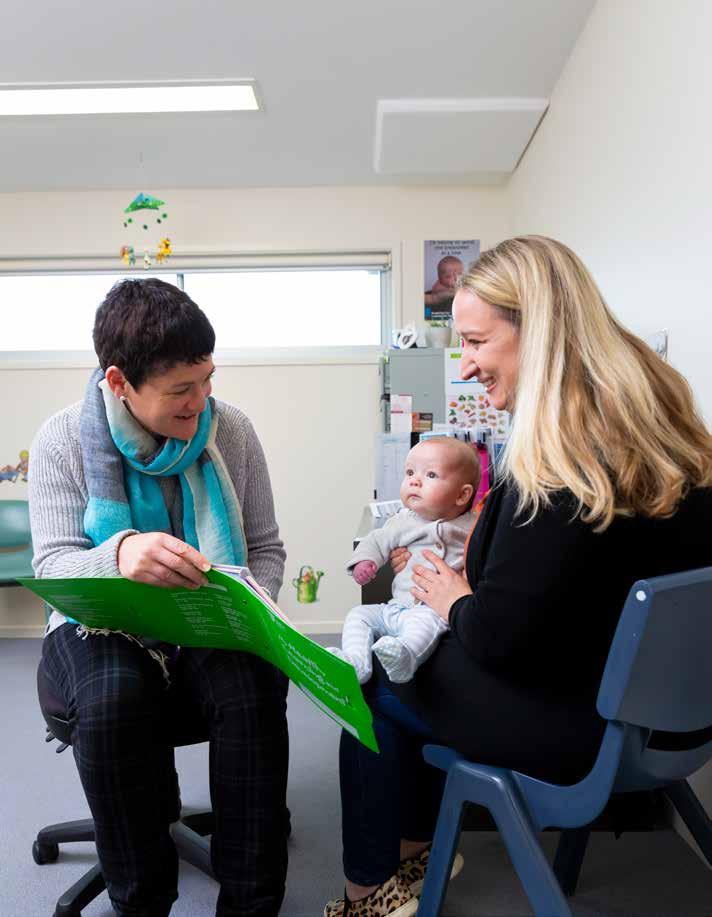
Integrated Strategic Planning and Reporting Framework
Part 4 of the Local Government Act 2020 requires councils to prepare the following:
• A Community Vision (for at least the next 10 financial years);
• A Council Plan (for at least the next 4 financial years);
• A Financial Plan (for at least the next 10 financial years);
• An Asset Plan (for at least the next 10 financial years);
• A Revenue and Rating Plan (for at least the next 4 financial years);
• An Annual Budget (for the next 4 financial years);
• A Quarterly Budget Report;
• An Annual Report (for each financial year); and
• Financial Policies.
The Act also requires councils to prepare:
• A Workforce Plan (including projected staffing requirements for at least 4 years).
The following diagram shows the relationships between the key planning and reporting documents that make up the integrated strategic planning and reporting framework for local government. It also shows that there are opportunities for community and stakeholder input and feedback.
PERFORMANCE
performance for the
year has been reported against each strategic objective to demonstrate how Council is performing in achieving the Council Plan 2021-2025.

Performance has been measured
Results achieved in relation to
Indicators in the Council Plan.
Council’s Budget 2021/22.
• Services funded in the Budget and the persons or sections of the community who are provided those services.
•
relation to the
in
• Results against the prescribed Service Performance Indicators and Measures.
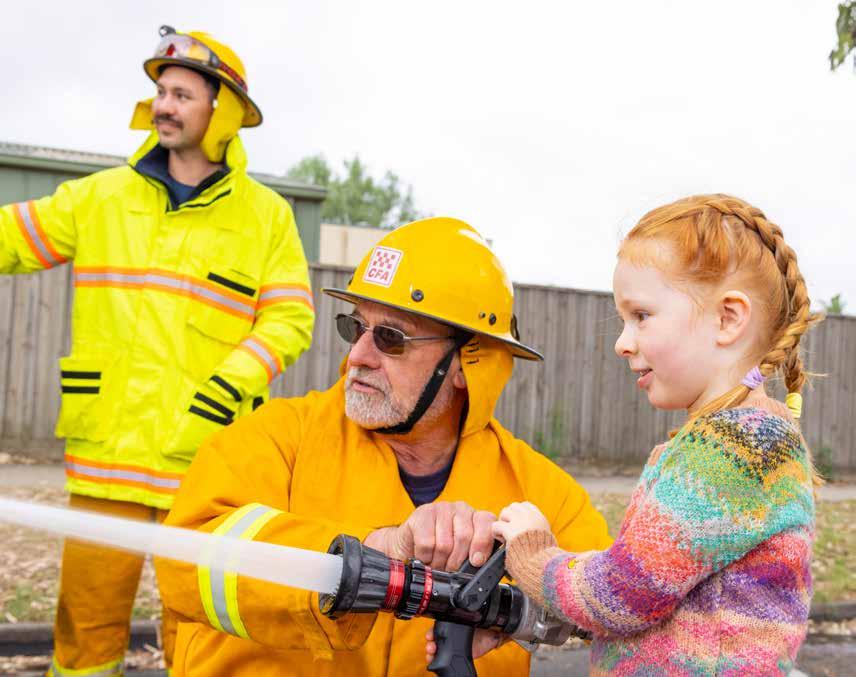
HIGHLIGHTS OF 2021/22
The following statement reviews the performance of Council against the strategic indicators included in the Council Plan 2021-2025.
Strategic Objective: 1.1 Safe, resilient and proud communities
A CCTV Steering Committee was formed to discuss Community Safety. The consideration to install CCTV is still continuing however, Council will look at other measures and work with Victoria Police to address some behaviours.
Council partnered with Barwon Child, Youth and Family, Uniting and Orange Door to provide mental health services across eight locations in Golden Plains Shire including the Golden Plains Youth Hub.
Extensive consultation has occurred with key stakeholders across the Shire in the review of the Municipal Public Health and Wellbeing Plan actions for Years Two, Three and Four to ensure they are still relevant to community needs.
Council continues to chair the Municipal Emergency Management Planning Committee, which brings all Emergency Service agencies in the Shire together. A new Golden Plains Shire Municipal Emergency Management Plan was completed by the Municipal Emergency Management Planning Committee.
Strategic Objective: 1.2 Celebrating and connecting communities
Endorsement of Council’s Reflect Reconciliation Action Plan (RAP) under the Reconciliation Australia accreditation process was confirmed on 20 June 2022.
National Reconciliation Week (NRW) activities were held from 27 May to 3 June 2022 at Council’s early years’ facilities, the Golden Plains Youth Hub and in partnership with Geelong Regional Library Corporation (including the mobile library).
Following a public exhibition and submission process, the Golden Plains Shire Arts, Culture and Heritage Strategy 2022-2026 was presented to, and adopted by, Council in November 2021. Implementation of the Strategy is in progress.
Successful delivery of a Community Leadership Program was undertaken, aimed at improving mental wellbeing through increased community participation and inclusion. Ten community members participated in the program.
Strategic Objective: 1.3 Community participation, engagement and ownership
Non-Profit Training Pty Ltd (contractor) were appointed through a tender process to undertake Community Planning Facilitation from April 2022 for the delivery of six community plans per year.
Council successfully delivered two Community Strengthening Grants Rounds in September 2021 and April 2022 with a total of $153,337 awarded to 33 community groups.
A total of $600,000 in funding was secured Council in 2021/22 to deliver health, wellbeing and youth programs.
A review of Council’s community facilities was undertaken during 2021/22 with key actions including the implementation of revised fees and charges for facilities and the introduction of a new online booking system.
Strategic Objective: 1.4 Valuing community diversity and inclusion
On 22 March 2022, Council made the decision to cease in-home aged and disability care services from 30 June 2022. A new Active Ageing & Inclusion Team will provide programs to promote positive ageing, improve access and inclusion, assist with service navigation and information, and create more opportunities for social connection.
Construction of the Golden Plains Youth Hub in Bannockburn was completed and opened in April 2022. More than 286 young people were engaged and attended programs delivered at the Youth Hub across April, May and June 2022.
Council has developed and delivered several programs to promote respectful relationships and facilitate leadership on gender equity. This has been done through the development of strong partnerships and to assist with implementation of the Gender Equality Act 2020.
To support inclusion for gender diverse and LGBTIQA+ communities, Council has worked to deliver programs and partnerships including the upskilling of staff to facilitate greater awareness and the development of a Pride Group for LGBTIQA+ young people.
Major Initiatives
The following statement reviews the progress of Council in relation to major initiatives identified in the Council Budget 2021/22.
Major Initiatives Progress
Emergency Management Emergency Management initiatives in 2021/22 have included:
• Chairs the multi-agency Municipal Emergency Management Planning Committee
• Maintenance of Neighbourhood Safer Places
• Preparation of the Municipal Emergency Management Plan and relevant subplans
• Contribution to the Barwon Flood Warning System
• Train and prepare for the opening of Relief Centres in an emergency
• Assist in accommodation and clothing for residents whose home is impacted by an emergency event
• Assist in mitigating, response and recovery from an emergency
• Golden Plains Shire Council chairs and hosts the Multi-Agency Municipal Emergency Management Planning Committee meetings twice a year. The Municipal Emergency Management Planning Committee is responsible for the preparation and review of the Municipal Emergency Management Plan and collaboration between Council and Emergency Management agencies.
• Neighbourhood Safer Places were maintained throughout the Fire Danger Period.
• The Municipal Emergency Management Plan (three-year plan) was completed and approved during 2021/22.
• Council financially contributed to the Barwon River flood warning management system.
• Council staff undertook relief centre training and a new relief centre trailer was purchased for the storage and set-up of relief centre equipment.
• No emergency assistance accommodation and clothing was administered during 2021/22.
• Council assisted the community in responding to a number of emergency assistance requests, including supplying sandbags, road closed signs and equipment to assist the CFA in responding to emergency events.
• Council assisted the community in responding to a number of emergency assistance requests, including supplying sandbags, road closed signs and equipment to assist the CFA in responding to emergency events.
• Develop a new online booking and payment system for community facilities
Community Facilities Research and implementation of the SpacetoCo system for bookingcommunity facilities was undertaken in January and completed in June 2022. All Council community centre bookings are now managed via this platform and collection of data to analyse community facility usage, demand and future needs is enabled.
Active Ageing & Inclusion
• Action Plan: Community Transport Review - Undertake comprehensive review to identify the gaps in transport provision across the Shire and identify an accessible, affordable service to meet the needs of vulnerable and isolated residents, with the view to help maintain independence, health and wellbeing, and enable residents to remain living and actively participating in their communities
• Action Plan: Active Ageing and Inclusion Plan 2020-2024 identifies current and future needs of older residents and people living with disabilities
The Community Transport Review project has included:
• SMEC being awarded as the consultant for the Transport Connections Study and a Project Control Group established to discuss and progress the study.
• Focus groups, engagements and community consultations were completed to feed into the draft report.
• The draft report will be presented to Council in September 2022 and the final report is due to the Department of Transport by 30 October 2022.
In 2021/22, Active Ageing & Inclusion (AA&I) Plan actions have included:
• Completion of the Aged Care Reform and Best Value Review, followed by support to the exit of in-home aged and disability care services. The reinvestment of Council funds will focus on four strategic areas of positive ageing, social connections, access and inclusion, and assessment and service navigation.
In 2022/23, AA&I will focus its work on creating linkages with key community groups across the Shire to enhance engagement, accessibility and connection for the ageing population.
The Golden Plains Shire Active Ageing & Inclusion External Advisory Group continued to meet bimonthly at Bannockburn and Smythesdale throughout 2021/22.
Development and implementation of an accessibility map on Council’s website has been undertaken.
Community Development Community Strengthening Grants rounds were undertaken in September 2021 and March 2022 with a total of $153,337 awarded to 33 community groups.
• Deliver two rounds of the Community Strengthening Grants Program including quick response grants and grants across funding streams
• Implement improvements to the Community Planning Program through delivery of the Community Planning Program Action Plan
Following a tendering process, Non Profit Training were contracted by Council in early 2022 to facilitate the development of the next six plans as part of the Community Planning Program.
Major Initiatives Progress
Arts & Culture
• History & Heritage - supporting the care and interpretation of our heritage assets (community and civic collections)
• Facilitating opportunities for creatives - brokering access to space and capacity building programs
• Develop an Arts, Culture and Heritage Strategy
• Art Exhibitions – Spring in the Shire 2021
The Golden Plains Stories project with RMIT is progressing with development of the website and content in partnership with local historical societies.
The ‘Our Stories’ collection of local historical artifacts telling the stories of the community has been displayed in the Council Chamber for the last two years.
Council has continued to build and strengthen relationships with key stakeholders and creative artists across the Shire to broker access to space and capacity building programs. This has included supporting Linton & District Historical Society’s work in heritage buildings, engaging regularly with GPArts Inc on different opportunities and undertaking workshops with Blink Dance Theatre in Meredith.
Following community engagement, the Arts, Culture and Heritage Strategy 2022-2026 was adopted by Council in November 2021. The Strategy provides actions and deliverables under the four objectives of Creative Communities, Our Stories, Our Spaces and Places and Toward a Creative Economy.
The Spring in the Shire competition and photographic exhibition was delivered in late 2021 with an awards ceremony held at the Golden Plains Twilight Market in December 2021. The works of the 30 finalists were exhibited at Bannockburn Cultural Centre and The Well in Smythesdale.
Youth Development
• Develop a Youth Strategy Action Plan
• Progress the Youth Portable concept
• Deliver programs from Engage and FReeZA from funding
A Youth Development Action Plan was developed for 2021/22, which saw many programs for young people being delivered across the Shire.
The Action Plan’s implementation was impacted by COVID restrictions, however, more than 800 young people attended programs, training and workshops at various Council led and supported events throughout the year.
A comprehensive operational and activation plan was developed to progress the launch opening and activation of the Golden Plains Youth Hub with input provided by the Youth Hub Community Reference Group. The Hub opened to the community in March 2022, with an official opening in April 2022 by the Victorian Minister for Local Government.
Various activities were delivered under Engage and FReeZA programs which included accredited training for young people (barista, safe food handling and responsible serving of alcohol). Many community and holiday activities were held across the Shire including in Inverleigh, Bannockburn, Dereel. Smythesdale and Haddon. In addition, events were held including the Bannockburn Skate Park opening, support for Live at Turtle Bend and online music events during the COVID-19 pandemic.
Services
The following statement provides information in relation to the services funded in Council’s Budget 2021/22 and the persons or sections of the community who are provided the service.
Service Area Description of Service
Emergency Management
This service ensures Council staff are prepared and the resources and facilities are ready to assist in an emergency. This service also chairs the multi-agency Municipal Emergency Management Planning Committee and organises the preparation of the Municipal Emergency Management Plan and the relevant subplans.
Net Cost Actual Budget Variance
Fire Protection
Implementation of the Municipal Fire Management Plan which includes undertaking fire hazard inspections, completing maintenance in reserves, and provides financial and physical support to the CFA for burning of Municipal land.
313 (56)
Community Safety
To implement local laws, school crossing supervision, fire protection, emergency management and animal control programs to ensure the safety of residents and visitors to the Shire.
Environmental Health
To protect and enhance the health of the public and the environment via a range of education and enforcement programs. To deliver services addressing domestic wastewater management, food safety, immunisation and tobacco control regulations.
Active Ageing & Inclusion Home & Community Care Program for Younger People (HACC PYP)
Provision of individual and group support 'entry level' services including assessment to enhance the health and wellbeing of community members whose functional limitations affect their ability to manage day-to-day activities and need support to live independently at home and stay connected to the community. Wellness and reablement are an essential part of service delivery and promote independence, improved quality of life, and support a ‘doing with’ approach that delivers positive outcomes for consumers, carers and communities. People who are eligible, include frail people under the age of 65 years, 50 years and younger for Aboriginal and Torres Strait Islander people, and younger people with disabilities not eligible for the NDIS and carers. The 2021/22 Budget incorporated realignment of program areas across HACC/ PYP & CHSP programs.
218 (173)
288 (42)
Community Facilities
Improving the health and wellbeing of Golden Plains Shire residents and facilitating the development of healthy vibrant communities. Providing opportunity to support and access a range of services and programs at Councilmanaged facilities across the Shire.
Active Ageing and InclusionCommonwealth Home Support Program (CHSP)
Provision of individual and group support 'entry level' services including assessment to enhance the health and wellbeing of community members whose functional limitations affect their ability to manage day-to-day activities and need support to live independently at home and stay connected to the community. Wellness and reablement are an essential part of our service delivery and promote independence, improved quality of life, and support a ‘doing with’ approach that delivers positive outcomes for consumers, carers and communities. To be eligible for the program, people must be 65 years and over (50 years and over for Aboriginal and Torres Strait Islander people).
Community Development
Arts and Culture
Supporting and strengthening local communities and local leadership through the development of Community Plans and Council’s community grants program.
Facilitating the development of community arts and cultural development projects and creative industries in collaboration with local artists and communities. Arts, culture and heritage is central to the quality of life and wellbeing of residents in Golden Plains Shire.
(10)
Youth Development
The Youth Development program offers a range of accessible and inclusive activities, programs and events designed to improve opportunities for youth and young adults ages 12-25 years of age to connect, learn and lead in their community. This is achieved through youthinformed practice and strong community partnerships and connections.
(2)
Service Performance Indicators
The
Library Services Results
Utilisation
Physical Library collection usage
of physical library collection item loans / Number of library physical collection items]
Resource
Recently purchased library collection
of library collection items purchased in the last 5 years / Number of library collection items] x100
Participation
Active library borrowers in municipality
of active library borrowers in the last three years / The sum of the population for the last three years]
Service
of library service per population [Direct cost of the library service / Population]
Physical usage of Council’s library facilities has been impacted by the COVID19 pandemic with usage gradually increasing.
8.02% Active library borrowers in the municipality have been impacted by the COVID-19 pandemic
Food Safety Results
Timeliness 1.92 1.00 1.00 3.17 Increase in number of food complaints recieved. Time taken to action food complaints [Number of days between receipt and first response action for all food complaints / Number of food complaints]
Service standard 100.00% 100.00% 60.16% 89.15% 20% increase in number of registered food premises that received a food safety assessment.
Food safety assessments [Number of registered class 1 food premises and class 2 food premises that receive an annual food safety assessment in accordance with the Food Act 1984 / Number of registered class 1 food premises and class 2 food premises that require an annual food safety assessment in accordance with the Food Act 1984] x100
Service cost $201.19 $225.67 $417.35 $214.09 Reduction in total direct costs of food safety service. Cost of food safety service [Direct cost of the food safety service / Number of food premises registered or notified in accordance with the Food Act 1984]
Health and safety 100.00% 100.00% 100.00% 100.00%
Critical and major noncompliance outcome notifications [Number of critical noncompliance outcome notifications and major non-compliance notifications about a food premises followed up / Number of critical non-compliance outcome notifications and major non-compliance notifications about food premises] x100
Service/ Indicator/ measure 2019 2020 2021 2022 CommentsAnimal Management Results
Service/
Timeliness
Time taken to action
management
of days between receipt and first response action for all animal management requests / Number of animal management requests]
Service standard
Animals reclaimed [Number of animals
Number of animals collected]
100
Animals rehomed
[Number of animals rehomed
Number of animals collected]
100
Council actions all animal management requests on the day that they are received.
Service
animal
in
27 animals were relcaimed by residents in 2021-22, a decrease from 31 reclaimed in 2020-21, 58 in 201920, and 56 in 2018-19.
5.56% 5 animals were rehomed out of 90 animals collected in 2021-22, compared to 52 animals rehomed out of 148 animals collected in 2020-21 (a large increase to other years), and 12 animals rehomed out of 230 collected in 2019-20.
to prior years.
of
animal management
Health and
Animal management
of
animal management
of animal management
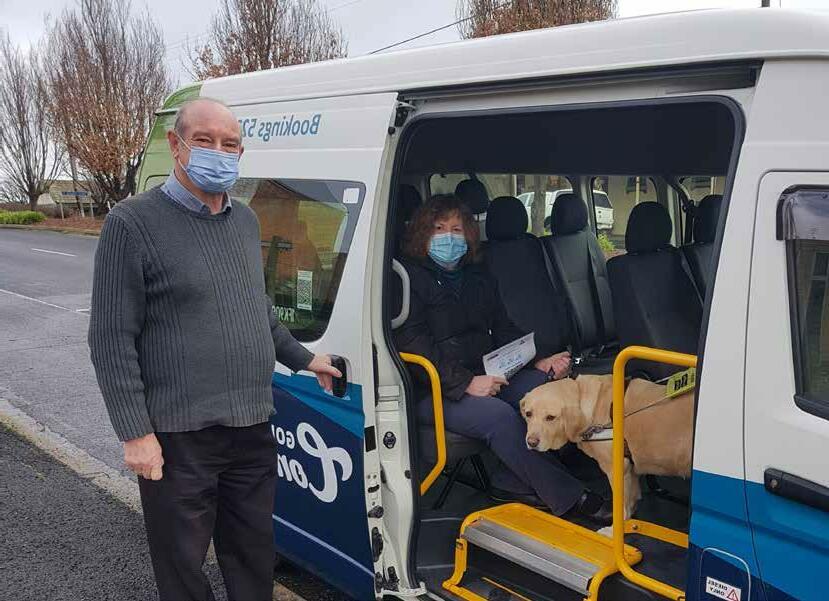
HIGHLIGHTS OF 2021/22
The following statement reviews the performance of Council against the strategic indicators included in the Council Plan 2021-2025.
Strategic Objective:
roads, crossings, paths and transport
Council’s Road and Bridge Programs completed in 2021/22 included:
• Meredith-Shelford Road Widening Stages 1 to 3 Road Sealing Program
• Slate Quarry Road Bridge Replacement
• Reserve Road Bridge Replacement
• Paddys Gully Road Bridge Replacement
• Triggs Bridge renewal works
• Hardies Hill Road/Mt Mercer Road, Garibaldi intersection upgrade
• Staffordshire Reef Road/Donald McLeans Road Berringa intersection upgrade
• Gravel road resheeting
• Bridge guardrail program
VicRoads Projects completed in Golden Plains Shire in 2021/22 included:
• Bannockburn Township Entrance roundabout construction
• Road safety improvements on Hamilton Highway, Murghebuloc
• Road widening - Colac-Ballarat Road
• Road repairs - Lismore-Cressy Road
Paths and Trails Program Projects completed in 2021/22 included:
• Installation of new bus shelters in Haddon and Geelong Road, Bannockburn
• New footpaths at Linton Primary School, Lethbridge, Linton and Haddon
Road Safety Projects completed in 2021/22 included:
• Pedestrian crossing on Milton Street, Bannockburn
• Speed sign reviews and reduced limits on Blackall/Dog Rocks Road (Batesford), Common Road (Inverleigh), Harvey Road (Bannockburn), Slate Quarry Road (Meredith), Russells Bridge Road, Farley Road (Dereel) and Cemetery Road (Inverleigh)
•
•
Linton, Rokewood and Teesdale
• Bannockburn
• Bannockburn
To promote and advocate for healthy eating and drinking, more than 400 community members participated in a suite of programs centred around food sustainability, growing food at home, consumption of local produce and reducing food wastage.
Council advocacy for upgrades and new recreational facilities in 2021/22 included pre-election lobbying and applying for funding opportunities to deliver the following future projects:
• Bannockburn Netball Pavilion Upgrade
• Rokewood Community Pavilion Upgrade
• Rokewood Netball & Tennis Court Upgrade
• Inverleigh Active Youth Space
• Woady Yaloak Recreation Reserve Lighting Upgrade
• Maude Community Pavilion Upgrade
• Linton Oval Redevelopment
• Bannockburn Skate Park Stage 2 Upgrade
With the support of Regional Sports Assembly, Leisure Networks, Council undertook research (including a survey) to understand community needs relating to physical activity. This included identifying barriers to participation and opportunities to encourage people to be more active, more often. The recommendations from this work will be provided in 2022/23 and will inform the planning and roll out of the Active Golden Plains Program.
Strategic Objective: 2.3 Provide for a diversity lifestyle and housing options
Land use planning activities to plan for future growth whilst maintaining rural and township character included:
• Approval of the Teesdale Structure Plan
• Progression of Bannockburn South East PSP
• Council successfully securing $315,000 for the preparation of a Shire-wide Settlement Strategy
• Council secured a grant to prepare a Flood Study for Teesdale
• Continuing to assess applications for rezoning in Bannockburn including the North West Area, Ormond Street and the Bannockburn Industrial Estate expansion
During 2021/21, Council received a total 435 planning applications and determined 461 applications. Total estimated cost of works for permits issued was $70,212,720. Officers determined 66.4% within 60 days and completed 80% of VicSmart applications within 10 business days. Council issued permits for 53 new dwellings within the Shire and created 455 new allotments within the Shire.
Strategic Planning activities across the Shire in 2021/22 included:
• Finalising a framework for the collection of Development Contributions in Inverleigh
• The Shire-wide Development Contribution Scoping Study options paper was presented to Council in June 2022.
• Officers are working with the VPA on Development Contributions for Bannockburn and seeking a response on Development Contributions for Cambrian Hill
Community infrastructure works at Teesdale Turtle Bend have been completed inclusive of bridge, public toilet and playground upgrade.
Community engagement, a funding agreement and project timelines for delivery of the Meredith Multi Play Space (Skate/Play and BMX) have now been completed, with project works to commence in 2023.
Strategic Objective: 2.4 Attractive and well-maintained infrastructure and public spaces
Public and open space works and upgrades in 2021/22 included:
• Construction of Linton Recreation Reserve
Deck and supporting infrastructure for the newly upgraded play space
• Water fountain installation at Batesford Play Space
• Updated signage at Leighdale Equestrian Centre
• Installation of furniture at Haddon Recreation Centre
• Beautification works at Lethbridge Recreation Reserve, including carparking, pathways and landscaping
• Repainting of Don Wallace Recreation Reserve and internal upgrade of upstairs rooms including floors and kitchen
Community consultation for the Northern Streetscapes Project has been completed and Council developed
Northern Streetscapes Framework Plans for Smythesdale, Scarsdale and Linton. The works are planned to be undertaken commencing in July 2022.
Some significant challenges for open space maintenance
addressed during 2021/22, including storm events in the second quarter that caused widespread tree damage and localised flooding events.
The Township, Road and Drainage Maintenance Programs
been completed for 2021/22, including Common Road Drainage Upgrades.
Strategic Indicators
Major Initiatives
The following statement reviews the progress of council in relation to major initiatives identified in the Council Budget 2021/22.
Major Initiatives Progress
Recreation Planning
• Continue implementation of the Sport and Active Recreation Strategy 20202030 and Play Space Strategy 2019-2029
• Undertake Master planning for recreation reserves
• Develop concept plans, detailed designs and seek funding opportunities for Sport and Active Recreation projects
Implementation of recommendations and actions from both thePlay Space Strategy and Sport and Active Recreation Strategy has continued.
Specifically, Council completed upgrades of:
• Garibaldi Community Park Playground
• Harrison Reserve Play Space, Enfield
• Linton Recreation Reserve Play Space
• Bannockburn Skate Park
• Bannockburn Bowls Club Green 2
• Inverleigh Sporting Complex Pavilion and Changerooms
• Bannockburn Soccer Facility -Changeroom and Pitch 2 fencing and lighting
• Bannockburn Safety Netting
• Lethbridge Cricket Nets
• Linton Cricket Nets
• Work to develop and update Council Masterplans has been undertaken including for the Woady Yaloak Equestrian Centre, Ross Creek Recreation Reserve and Don Wallace Reserve in Teesdale.
Concept Planning and design work has continued for informing funding opportunities and recreation projects including:
• Smythesdale Sub Regional Playspace
• Meredith Multi Playspace
• Rokewood Netball/Tennis Upgrade
• Rokewood Community Hub
• Woady Yaloak Recreation Reserve Lighting Upgrade
• Inverleigh Active Youth Space
• Bannockburn Skate Park Stage 2 Upgrade
• Bannockburn Netball Change
x
Development Services
• Development Services
• Undertake targeted planning scheme enforcement and compliance checks
• Implement the Northern Settlement Strategy
• Commence the process of developing new land use policy directions for the township of Teesdale
• Complete the development of a new structure plan for the township of Teesdale
• Explore opportunities for the identification of new employment land within the Shire
• Implement Council’s adopted Domestic Wastewater Management Plan
• Implement a targeted inspection program to ensure high levels of swimming pool barrier compliance
• Due to COVID-19 restrictions and State recommendations across the year, a limited number of inspections occurred.
• Council continues to work with the Department of Environment, Land, Water and Planning (DELWP) on the implementation of the Northern Settlement Strategy and this body of work will be used to inform the Shire-wide growth strategy.
• The Teesdale Structure Plan has been completed and is included in the Golden Plains Shire Council Planning Scheme.
• The Golden Plains Shire Growth Plan is currently being undertaken and includes an analysis of industrial and commercial land zoned land. This work continues to be undertaken with the aim of growth scenarios being released for community consultation in December 2022.
• Council continues to work with the permit applicant on the expansion of the Bannockburn Industrial Estate, which was land identified through the Bannockburn Growth Plan.
• The Domestic Wastewater Management Plan (DWMP) continues to be implemented. In the 2022/2023 budget, the Environmental Health team have secured a budget of $50,000 to have the DWMP reviewed to ensure best practice.
• Phase One of the swimming pool compliance has been completed and required registration of swimming pools by 1 June 2022. Phase Two is due by 1 June 2023 and will require the registration and barrier compliance of more than 200 swimming pools within the Shire.
Development Engineering Council continues to require developments to comply with the Infrastructure Design Manual and undertake site inspections of works whilst in progress to ensure the compliance and quality of new infrastructure.
• Ensuring engineering requirements are implemented through the development process, including compliance with Council’s Infrastructure Design Manual
Health Promotion
• Implement the Municipal Public Health and Wellbeing Plan 2021-2025
• Consider and implement priorities from the CASIMO report
Year One of Council’s Municipal Public Health and Wellbeing Plan 2021-2025 was delivered during 2021/22. A stakeholder forum was held in June 2022, with 40 partners in attendance, to review actions delivered over the year and consider any changes that may be required to priority areas in the coming 12 months. Thirty-four organisations/ internal departments have been ‘active’ partners this past year.
The Community Service and Infrastructure Plan (CSIP) was adopted by Council in August 2021. During 2022, findings from the CSIP were used to inform service delivery of mental health support in various locations across the Shire.
Recreation Construction
• Bannockburn Soccerchangerooms, lighting and fencing
• Linton Cricket Nets
• Lethbridge Lighting and Irrigation Upgrade
• Bannockburn Skatepark Upgrade
• Three Trails Upgrade and Renewal
• Bannockburn Bowls Club
Works on Recreation Construction projects have been completed with openings for the following projects:
• Bannockburn Soccer Facility Upgrade including changerooms, lighting and fencing was officially opened on 15 May 2022.
• Linton Cricket Nets Facility was completed in early 2022 and opened on 15 May 2022.
• The Bannockburn Skatepark Upgrade was completed in December 2021 with an official opening and community celebration held on 14 March 2022.
• The Lethbridge Lighting and Irrigation Project was officially opened on 8 July 2021.
• Three Trails upgrade and renewal works are continuing including signage, shelters, furniture, tree and trail surface works. A key section of works at Nimons Bridge is completed and re-opened to the public on 1 July 2022.
• The new green at Bannockburn Bowls Club Upgrade and two safety nets at Victoria Park are scheduled for an official opening on 19 July 2022.
Recreation
• Working with Committee of Management groups to identify priority maintenance projects
• Service Planning & Asset Rationalisation Review
• Sports Field Management Optimisation
Sealed Roads Routine Maintenance
• Road condition survey and revaluation program
• Sealed road maintenance and rehabilitation
• Yearly fire prevention program of roadside slashing
Local Roads Resealing
Road condition survey and revaluation program
Local Roads Rehabilitation
• Road condition survey and revaluation program
• Major patching and maintenance
Annual facility inspections/audits of major recreation facilities are undertaken to identify the needs and in discussion with management entities, to inform the proactive maintenance program.
Planning for services and infrastructure to manage growth in Golden Plains is ongoing including identifying potential assets for rationalisation or decommissioning. Open space, irrigation and annual maintenance works on ovals and sports fields across the Shire are scheduled to ensure optimisation and enable fixturing of activities for clubs and user groups.
The road condition survey and revaluation program was not scheduled in 2021/22. Subject to budget, this work will be undertaken in 2022/23.
Ongoing maintenance of sealed roads and rehabilitation has been undertaken via pothole patching and edge break repairs.
The annual contract for fire prevention works has been rolled out for roadside slashing and fire track maintenance.
The road condition survey and revaluation program was not scheduled in 2021/22. Subject to budget, this work will be undertaken in 2022/23.
Ongoing maintenance of sealed roads and rehabilitation has been undertaken via pothole patching and edge break repairs.
A total of 155,742 square metres of sealed roads was resealed across the Shire.
The road condition survey and revaluation program was not scheduled in 2021/22. Subject to budget, this work will be undertaken in 2022/23.
Ongoing maintenance of sealed roads has occurred via major patching.
Local Roads Improvements
• Deliver the Roads to Recovery Funding Program
• Delivery of Fixing Country Roads Program
• Lobbying for Government and external road funding
• Road Design investigation
• Road Management Practice Improvements (Systems, Policies and Community Engagement)
Gravel Roads Routine Maintenance
• Road Management Practice Improvements (Systems, Policies and Engagement)
• Road condition survey and revaluation program
• Gravel road maintenance as per Customer Charter and maintenance program
• Dust suppression additive trials
Gravel Roads Routine Re-sheeting
• Road condition survey and revaluation program
Bridge Maintenance
• Bridge condition survey and revaluation program
• Lobbying for Government and external bridge funding
• Bridge and large culvert routine maintenance
• Obtaining contributions from other Councils where bridges are on Council boundarie
The Meredith-Shelford Road Stages 2 & 3 Upgrade was delivered under the Federal Government’s Roads to Recovery Program and the Victorian Government’s Agrilinks.
Council secured $5.25 million in funding for road projects through Local Roads and Community Infrastructure ($2,667,000), Blackspot ($513,000) and Agrilinks ($733,000) programs, as well as funding from Roads to Recovery ($1,333,000).
An ongoing program of road designs was investigated and scoped for projects to be constructed in 2022/23.
A review of the process to add roads to the Road Register has occurred. The Road Management Plan 2021-2025 was adopted by Council in July 2021.
The road condition survey and revaluation program was not scheduled in 2021/22. Subject to budget, this work will be undertaken in 2022/23. A review of the process to add roads to the Road Register has occurred. The Road Management Plan 2021-2025 was adopted by Council in July 2021.
In 2021/22, 627km of gravel roads were graded across the Shire with 1 grade per year. A review of the Charter has been undertaken to increase the level of service on 23 Shire roads to 2 grades per year. No dust suppression additive trials were undertaken, as Council no longer undertakes a dust suppression program. Council has improved its grading and gravel re-sheeting programs to minimise the impacts of dust. Alternate low costs sealing options are also being investigated.
The road condition survey and revaluation program was not scheduled in 2021/22. Subject to budget, this work will be undertaken in 2022/23.
The bridge condition survey and revaluation program was not scheduled. Subject to budget, this work will be undertaken in 2022/23. Funding received for bridge projects through Local Roads and Community Infrastructure was secured to deliver the replacement of Paddys Gully Road bridge.
Application to Round 6 of the Bridge Renewal Program was unsuccessful.
Completion of Round 5 funding for the replacement of Slate Quarry Road Bridge.
Ongoing maintenance of bridges and major culverts continues based on the inspection program.
Council has supported Surf Coast Shire Council with a financial contribution for design of the replacement of Pollocksford Bridge scheduled for 2022/23.
Tree Maintenance
• Develop strategies to address the Inverleigh Cypress Trees as well as the Meredith and Inverleigh Avenues of Significance
• Development and implementation of proactive routine inspection and maintenance programs across the Shire
• Inventory of all Arboriculture Assets
Line Marking, Guideposts and Signs
• Managing road user safety through line marking and sign maintenance
Street Lighting
• Management of power costs for street lighting
• Conversion of lighting to energy efficient systems where possible
Township Maintenance
• Working with Committees of Management, Progress Associations and Volunteers to deliver proactive work programs across the Shire
• Township maintenance activities including mowing, horticulture, street sweeping and irrigation maintenance
• Working with Community Coordinators to achieve community plan outcomes
Paths and Trails
• Maintenance of Council Paths & Trails
Two rounds of community consultation have been completed towards the Inverleigh Tree Succession Plan.
Proactive routine inspection of trees and maintenance programs have occurred across the Shire.
An arboriculture database and proactive inspection program is in development, to be completed in 2022/23.
The Linemarking Renewal Program was rolled out in 2021/22. New or replacement signs and guideposts have been installed across the Shire.
Ongoing management of street lighting operation and maintenance is occurring with Council’s provider.
Rollout of LED lighting has been undertaken where practicable in new estates and for replacement of existing lights.
Township maintenance has continued in line with the Township Maintenance Policy.
A comprehensive Open Space Management Plan is in development, to be completed in 2022/23.
Council has worked closely with Beautify Bannockburn and Linton Progress Association to achieve positive community outcomes with ongoing maintenance programs.
Ongoing maintenance of paths and trails has occurred via crack sealing, slab replacement and/or additional gravel material being added.
Trail maintenance/enhancement works have occurred in Lethbridge, Ross Creek and as part of the Three Trails project.
Services
The following statement provides information in relation to the services funded in the Council Budget
and the persons or sections of the community who are provided the service.
Service Area Description of Service
Statutory Planning
To provide a range of statutory planning services to promote the fair, orderly and sustainable development of land within the Shire.
Net Cost Actual Budget Variance
Building Control
To undertake a range of regulatory compliance actions to ensure a safe build environment for all Golden Plains Shire residents. The 2020/21 budget included additional corporate overheads in relation to ICT software and additional $150,000 funds to implement new registration and safety compliance requirements and a reduction of $60,000 in pool registration and pool permit information search fees.
Strategic Planning
Undertake long-term land use planning to meet the sustainable needs of current and future generations.
2020/21 budget included restructure impacts from separating Strategic and Statutory Planning.
Development Engineering
To provide engineering requirements to developments being approved within the Shire, ensuring WSUD principles are considered and implemented, together with best practice results.
Community Transport
The Community Transport service provides a flexible, responsive transport service for isolated residents to stay connected to services within the shire and beyond. Paid staff and volunteers provide the transport service and eligibility is based on individual circumstances.
Health Promotion
Recreation Planning
Collaboratively working with community, government, health and wellbeing partners and agencies to support, protect and improve the health and wellbeing of residents.
Working to develop a range of recreation facilities and services, with the aim to increase active living in our community. By identifying, supporting and applying for grant funding, strategically planning recreation service and facility provision, building capacity and supporting local leadership in facility management, and providing participation and engagement opportunities.
Recreation Construction
Construction of community facilities, including halls, paths and trails, recreation reserves and pavilions, sporting facilities and playgrounds.
Recreation Infrastructure Maintenance
Undertaking general maintenance of all Council owned and controlled land (DELWP), buildings and facilities and supporting communities that undertake these activities on behalf of Council. Maintenance completed in line with programs and Committee of Management agreements and conditions. Work completed through a mixture of in-house resources and contractors. Thirty-seven percent of this budget relates to depreciation.
3,125 3,323 (198)
Major Projects
Planning and development of major projects, including halls, recreation reserves and pavilions and sporting facilities. Major land development projects undertaken by Council are also included in this program.
1,436 1,995 (3,431)
Sealed Roads Routine Maintenance
Routine maintenance of the Road Register sealed local road network. Council road maintenance crew activities related to upkeep and maintenance of Council’s 987km of sealed road network. Provision of roadside slashing and guidepost spraying (fire prevention) for the sealed road network.
1,644 1,718 (74)
Local Roads Depreciation Depreciation for sealed roads. 3,504 4,114 (611)
Local Roads Resealing & Rehabilitation
Bituminous resealing of Council’s local sealed road network. Council depreciation of the sealed road network. Ninetyseven percent of this budget relates to depreciation. Repairs of major and significant road failures (hazardous) not identified in capital works improvement program.
Local Roads Improvements Road design to allow Council to submit grant applications. Majority of budget relates to income from these grant applications.
Gravel Roads Re-Sheeting & Routine Maintenance
Routine maintenance of the Road Register gravel road network. Council road maintenance crew activities related to upkeep and maintenance of Council’s 692km of gravel road network. There are 69km of formed and unmade roads not included on the road registers with minimal budget allocated to these roads. Reconstruction of gravel roads by gravel resheeting programs conducted on Council’s local gravel road network.
160 416 (256)
2,738 7,202 (4,464)
1,559 1,172 (387)
Gravel Road Depreciation
Depreciation for gravel roads. 1,186 1,318 (133)
Bridge Maintenance General maintenance of Council’s 138 bridges and major culverts. Maintenance activities are aligned to condition surveys and activities to keep assets safe and serviceable. Activities do not relate to asset improvement or upgrade. This budget includes income from grant funding applications. Forty-four percent of this budget relates to depreciation.
5 674 (679)
Gravel Pits
Operation of Council Sago gravel pit. This budget relates to the extraction and use of Sago gravel within the Shire in line with licence requirements. Sago gravel is used in Council road projects, gravel re-sheeting and general gravel road maintenance. Twenty percent of this budget relates to depreciation.
Drainage Maintenance
Maintenance of Council’s significant township and rural drainage assets. This includes pipe systems, open drains, discharge points, treatment wetlands and kerb & channel. The budget is split between urban and rural drainage projects. Sixteen percent of this budget relates to depreciation.
Private Works
Provision of private works services for residents, other Councils and developers. External parties can request Council to provide quotation to complete works on their behalf. These requests normally relate to works that have potential impact on existing Council assets. These requests are dependent on Council resource availability
Line marking, Guideposts and Signs
Street Lighting
Bus Shelters
Maintenance of line-marking, and delineation in the form of guideposts and signage across Council’s local road network to Australian and VicRoads guidelines. This work includes maintenance and new signage as well as addressing customer requests
Provision of street lighting across Council’s local road network. This includes power costs associated with running streetlights, installation of new streetlights and maintenance where required.
Provision and maintenance of bus shelters across the Shire in line with Council Policy.
Paths and Trails
Maintenance of Council’s network of footpaths and trails. Council maintains paths constructed from concrete, asphalt and gravel including all signage, drains and bollards. Fiftyeight percent of this budget relates to depreciation.
Tree Maintenance
Tree maintenance works on Council’s local road network and managed land, to ensure community safety and in response to customer requests. Maintenance work is delivered via internal staff and contractors. Council receives more than 400 customer requests per year for tree maintenance.
Township Maintenance Provision of all township maintenance services in accordance with Council policy. This includes street beautification works, roadside, parkland and recreation facility grass, horticulture and arboriculture maintenance. Street furniture maintenance and replacement. General litter removal and removal of graffiti. Maintenance work is delivered via a combination of internal staff and contractors.
service Performance Indicators
The following statement provides the results of the prescribed service performance indicators and measures including explanation of results in the comments
Statutory Planning Results
Service/
Timeliness 68.00 80.00 78.00 84.00 Physical usage of Council’s library facilities has been impacted by the COVID19 pandemic with usage gradually increasing.
Time taken to decide planning applications [The median number of days between receipt of a planning application and a decision on the application]
Service standard 83.80% 77.81% 66.20% 67.25%
Planning applications decided within required timeframes [(Number of regular planning application decisions made within 60 days) + (Number of VicSmart planning application decisions made within 10 days) / Number of planning application decisions made] x100
Service cost $1,679.15 $1,035.16 $707.84 $896.46 Increase in direct planning costs in 2021/22.Cost of statutory planning service [Direct cost of statutory planning service / Number of planning applications received]
Decision making 0.00% 100.00% 0.00% 100.00% All council planning decisions were upheld by VCAT in 2021/22. Council planning decisions upheld at VCAT [Number of VCAT decisions that did not set aside Council’s decision in relation to a planning application / Number of VCAT decisions in relation to planning applications] x100
Roads Results
Roads Satisfaction of use 28.86 52.08 80.12 90.66 15% increase in sealed road re-quests in 2021/22.
Sealed local road requests
[Number of sealed local road requests / Kilometres of sealed local roads] x100
Condition 98.98% 98.98% 98.83% 98.86%
Sealed local roads maintained to condition standard
[Number of kilometres of sealed local roads below the renewal intervention level set by council / Kilometres of sealed local roads] x100
Service cost $49.25 $42.67 $64.83 $44.47 The program costs year to year vary dependent on the rural or urban nature of the works. 2021/22 indicator has returned to the 2019/20 level.
Cost of sealed local road reconstruction [Direct cost of sealed local road reconstruction / Square metres of sealed local roads reconstructed]
Cost of sealed local road resealing $4.64 $4.25 $4.52 $6.08 Increase in cost of materials re-flected in 2021/22 result.[Direct cost of sealed local road resealing / Square metres of sealed local roads resealed]
Satisfaction $4.64 $4.25 $4.52 $6.08 Increase in cost of materials re-flected in 2021/22 result. Satisfaction with sealed local roads
[Community satisfaction rating out of 100 with how council has performed on the condition of sealed local roads]

HIGHLIGHTS OF 2021/22
The following statement reviews the performance of Council against the strategic indicators included in the Council Plan 2021-2025.
Strategic Objective: 3.1 Valuing and protecting nature, cultural heritage and the environment
In 2021/22, implementation of key deliverables as part of the Environmental Strategy 2019-2027 included:
• Pest plant and animal management in reserves and roadsides;
• Integrated Water Management projects;
• Planning for and developing the Climate Emergency Plan;
• Developing the Rabbit Management Strategy; and
• Implementing the Victorian Energy Collaboration.
Council has partnered with RMIT on a digital histories project called Golden Plains Stories – this work will capture and record the oral history of local residents in towns and districts across Golden Plains Shire.
• Natural reserves management works and planning included the running of a collaborative ‘Assist in Prescribed Burn Course’ and the completion of Ecological Burns in various Shire locations.
• Development of strong relationships and engagement with local Wadawurrung woman, Bonnie Chew from Mirriyu Cultural Consulting, has delivered cultural heritage education, including a partnership on the Victorian Women’s Public Art Program Project - Vera Scantlebury Sculpture, which is progressing in Linton.
Strategic Objective: 3.2 Effective and responsive waste services and education
Public place trials of solar compacting litter and recycling bins have commenced in Golden Plains, with installations at the Heart in Bannockburn and Turtle Bend in Teesdale.
A Collaborative Kerbside Collection Tender process for the collective procurement of kerbside waste collection services was undertaken with Surf Coast Shire and Borough of Queenscliffe. The process was completed with approval from the Australian Competition and Consumer Commission.
Collaborative work with other G21 Member Councils and Barwon Water has continued in 2021/22 on developing the Rural Regional Organics Network.
In 2021/22, key waste education activities included:
• The recruitment of a Waste Education and Sustainability Officer
• The development and delivery of the Waste Communications Plan
• Targeted waste education with community facilities
• Initiating a waste plan for Council offices
Strategic Objective: 3.3 Responsibly maintaining and managing natural landscapes and resources
As an active member of the Barwon and Central Highlands Integrated Water Management (IWM) Forums, Council led and completed the Green Blue Infrastructure Guide for Small Towns in 2021/22, which is being adopted across the Grampians region.
Council has provided advice to landowners to assist with sustainable land management practices on agricultural land, supported events focused on pest control (such as the Rabbit Management Workshop), and undertaken the development of the Rabbit Management Strategy and Weed Management Strategy.
Council continues to support on the ground activities of various Landcare Groups across the Shire, including Clean Up Australia Day initiatives and working with the Environmental Volunteers and Agency Networks to promote environmental volunteering in the region.
The declaration of a Climate Emergency was adopted by Golden Plains Shire Council in July 2021 and development of a Climate Emergency Plan including extensive community engagement is well progressed
Projects and initiatives using renewable energy and carbon neutral practices included:
• Support of the Geelong Plus Community Solar Initiative.
• Installation of solar panels on seven Council owned and leased community facilities across the Shire, funded by Berrybank Wind Farm.
• Identification of ESD as a priority for Council and Community Facilities as part of the Climate Emergency Plan.
• Working with the Victorian Greenhouse Alliances to advocate for Climate Change to be prioritised as part of the Planning Schemes and Victoria’s Planning Legislation
• Partnership work to undertake climate mitigation and adaptation measures is occurring with the Regional Climate Adaptation Strategy for the Grampians released in December 2021 and Golden Plains Shire Council’s participation in the Barwon South West Climate Alliance with the Environment and Sustainability Coordinator as Chairperson.
The Township, Road and Drainage Maintenance Programs have been completed for 2021/22, including Common Road Drainage Upgrades.
Strategic Indicators
Council
Council,
Major Initiatives
The following statement reviews the progress of council in relation to major initiatives identified in the Council Budget 2021/22.
Major Initiatives Progress
Garbage Collections
• Kerbside collection and disposal of garbage
• Kerbside collection and treatment of recycling
• Community communication, engagement and education of key waste management principles
• Deliver Waste and Resource Recovery Strategy
Municipal Landfills
• Operation of Rokewood transfer station
• Management of Governments new e-waste policy
Kerbside residual waste and recycling collection was completed across the Shire. In 2021/22, 5,005 tonnes of waste were collected and transported to landfill and 2,786 tonnes of kerbside recyclables were delivered to VCRR Material Recovery Facility. A total of 36% of kerbside waste was diverted from landfill. Development of communications plan to facilitate future education around waste topics was undertaken with a campaign focusing of correct sorting of recyclables. A third of actions in the Waste and Resource Recovery Strategy are related to communication and educating residents on waste. Modelling of different options to introduce Food Organics Garden Organics (FOGO) and glass services are in progress as mandated by the Circular Economy Act (Waste Reduction and Recycling).
• Rokewood Transfer Station operated as per determined service levels.
• Management of Victorian Government’s new e-waste policy is ongoing and will continue into the 22/23 year.
Environment Sustainability Maintenance and protection of natural environment reserves across the Shire is an ongoing activity for Council. Reserves are regularly inspected and pest management works scheduled accordingly. In addition, reserve improvement works are conducted through native vegetation plantings. In 2021/22, Council increased its capacity to manage reserves through ecological burns by upskilling relevant Council staff in an Assist in Planned Burn qualification and coordinating training for external staff from City of Greater Geelong, Colac Otway Shire, the Corangamite Catchment Management Authority and Wadawurrung Traditional Owners Aboriginal Corporation. Community communication, engagement and education of key environmental principles has occurred through the development of the Climate Emergency Plan with extensive community engagement in March and April 2022. Education activities included ongoing involvement with the Environmental Volunteers and Agency Network, participation in its ‘Meet the Managers’ online forum, and plantings in Council reserves with students from schools and universities. Weed management and eradication is an ongoing program of work for Council and is undertaken using a range of methods including spraying, by hand and through the application of fire with planned burns.
• Ensuring engineering requirements are implemented through the development process, including compliance with Council’s Infrastructure Design Manual
Development of Climate Change Action Plan and an Emissions Reduction Action Plan has been brought together under the upcoming Climate Emergency Plan (CEP) The CEP looks at both Climate Mitigation and Adaptation and outlines key actions Council can undertake as an organisation and in its support of the community. Following Council’s declaration of a Climate Emergency, officers have been working to develop the CEP with a draft to be provided for public exhibition in Quarter One 2022/23.
Services
The following statement provides information in relation to the services funded in the Council Budget 2021/22 and the persons or sections of the community who are provided the service.
Service Area Description of Service
Environment Sustainability
To implement the Environment Strategy that includes the development of programs to address climate emissions and deliver specific actions to ensure the protection and enhancement of identified environmental assets. This includes the development of natural environment reserve management plans, ecological and cultural burning programs, and community engagement activities to promote specific environmental projects.
Actual Budget
Garbage Collections
Delivery of the Waste and Resource Recovery Strategy. This includes the collection and disposal of domestic garbage and recyclables across the Shire. Management of ongoing shared services contracts including recycling, disposal and collection.
Municipal Tips
Operation of the Rokewood Transfer Station including sorting and appropriate recycling and disposal. Rehabilitation and environmental monitoring of Council’s registered historic landfill sites.
Litter Control
Control of general litter and illegal dumping that occurs across the Shire. Dumping is normally seen in remote areas of low traffic. Council investigates all dumping to identify sources. Dumped rubbish is collected and disposed of properly.
service Performance Indicators
The following statement provides the results of the prescribed service performance indicators and measures including explanation of results in the comments
Statutory Planning Results
Satisfaction 101.48 115.91 90.99 20% reduction in number of kerbside collection requests in 202122.
Kerbside bin collection requests [Number of kerbside garbage and recycling bin collection requests / Number of kerbside bin collection households] x1,000
Service standard 2.70 4.85 4.88 3.75 22% reduction in number of kerbside collection bins missed in 2021-22.
Kerbside collection bins missed [Number of kerbside garbage and recycling collection bins missed / Number of scheduled kerbside garbage and recycling collection bin lifts] x10,000
Service cost $1,679.15 $1,035.16 $707.84 $896.46 Increase in direct planning costs in 2021/22.Cost of kerbside garbage bin collection service [Direct cost of the kerbside garbage bin collection service / Number of kerbside garbage collection bins]
Cost of kerbside recyclables collection service $112.09 $140.48 $136.38 $151.46 Increase in direct cost of kerbside recyclable collection service.[Direct cost of the kerbside recyclables bin collection service / Number of kerbside recyclables collection bins]
Waste diversion 38.13% 22.46% 36.97% 35.75% No recycling collection during recycling crisis from Jul-Dec 2019 impacted 201920 result. The industry stabilised in 2020/21 with performance returning to prior levels, which continued in 2021/22.
Kerbside collection waste diverted from landfill [Weight of recyclables and green organics collected from kerbside bins / Weight of garbage, recyclables and green organics collected from kerbside bins] x100
Service/ Indicator/ measure 2019 2020 2021 2022 Comments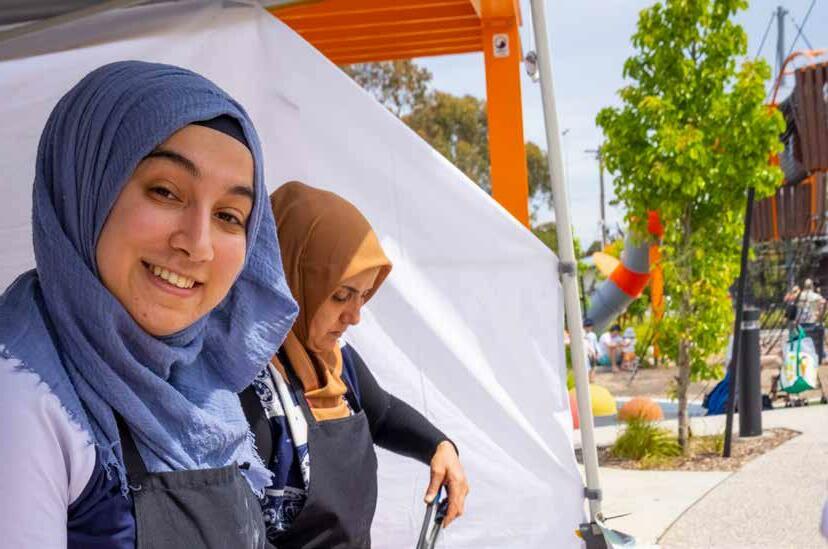
HIGHLIGHTS OF 2021/22
The following statement reviews the performance of Council against the strategic indicators included in the Council Plan 2021-2025.
Strategic Objective: 4.1 Education, learning and skill development
A Kindergarten Infrastructure Services Plan (KISP) was completed identifying infrastructure requirements to meet current and future demand up to 2029 and to provide 15 hours of funded Three- and Four-Yearold Kindergarten. Kindergarten infrastructure improvement projects have been identified at Haddon and Teesdale with the Haddon Kindergarten Extension progressing to detailed design.
82.57% of families/children participated in Council’s Maternal Child Health (MCH) service in 2021/22. MCH programs to support development needs of children aged 0 to 5 years included Key Ages and Stage appointments, supported play groups, sleep and settling programs, new parent groups and Baby Makes 3.
Library service provision in conjunction with the Geelong Regional Library Corporation has continued via the Bannockburn Library and Golden Plains Mobile Library despite COVID-19 causing temporary closures and pram cancellations. Almost 31,000 visits were recorded in 2021/22 at Golden Plains Shire locations.
Various programs were provided across Council services with skills development and capacity building as focus. This includes:
• The Community Development team’s work with community planning groups;
• The Health & Wellbeing team’s development of community leaders through the Community Leadership Program;
• The Active Ageing & Inclusion team’s engagement with Men’s Sheds; and
• The Youth Development team’s work with young people on vocational pathways.
Strategic Objective: 4.2 Supporting local producers, agriculture and business
The Golden Plains Farmers’ Market continues to create economic activity, connect the community and showcase local businesses. Ten COVID-safe markets were conducted during 2021/22 including the Annual Twilight Market in December 2021, which attracted an estimated 3,500 people.
Economic development support for local businesses included facilitating establishment of a business network in the northern region of the Shire and delivery of two business network events in Bannockburn and Smythesdale.
Subscription to Monitor CRMS will enable Council to track and maintain a comprehensive database of businesses operating in Golden Plains Shire with increased ability to segment business types for clear and more direct communication.
Strategic Objective: 4.3
options for shopping, hospitality, tourism and events
The Bannockburn Industrial Estate expansion, Gheringhap Employment Precinct development and Northern Streetscapes Project will greatly improve the opportunities for business attraction and growth in the Shire. The Shire-wide Settlement Strategy will also consider commercial and industrial land and potential opportunities.
The Three Trails Project has substantially progressed including surface works, furniture installations and gateway/township signage. A marketing strategy, promotional videos and communications plan are being progressed for implementation in the first quarter of 2022/23.
Successful delivery of two Community Fairs, funded by a Bushfire Recovery grant, was undertaken in partnership with the Golden Plains Farmers’ Market in Bannockburn and Smythesdale Country Market during April 2022.
Council secured $116,811 in funding from the Victorian Women’s Public Art Program, awarded by the Office of Minister for Women and administered through Regional Arts Victoria, for the Vera Scantlebury Sculpture and Gardens in Linton.
Strategic Objective: 4.4 Local employment and training
Golden Plains Shire’s first co-working space opened at The Well in Smythesdale in August 2021. The Digital Hub is a modern, accessible workspace with connectivity to fast, reliable digital broadband.
Support for the Bannockburn & District Chamber of Commerce (BDCC) continued during 2021/22 with provision of rooms for meetings and some financial support to cover costs.
Council’s Economic Development Unit is currently working with RMIT and Berrybank Wind Farm to develop an entrepreneurship pathways program in the Shire.
Development of a Volunteer Action Plan is underway, which will include the identification of capacity building needs of volunteers, a training program and identification of volunteer roles across Council functions. Relationships have been strengthened with Volunteering Geelong who will assist in determining requirements of a best practice model that incorporates National Standards of Volunteering.
Strategic Objective: 4.5 Partnerships, advocacy and opportunities for investment
Development of the Economic Development, Tourism & Investment Attraction Strategy 2022-2032 is well progressed in partnership with consultant SGS Economics & Planning. The Draft Strategy will be completed and provided for public exhibition in early 2022/23.
The Berrybank Wind Farm Community Grants funding guidelines have been developed and an expression of interest process advertised and undertaken for community participation on the assessment panel. The first round of the grants will provide $60,000 to the community and are scheduled be held in September 2022.
Advocacy for improved digital connectivity for residents across the Shire includes holding monthly meetings with NBNCo’s business and residential community engagement officers.
Strategic Indicators
The following statement reviews the performance of Council, detailing results achieved in relation to the strategic indicators in the Council Plan 2021-2025.
Strategic Indicator
Percentage of workforce with a Higher Education qualification (Cert I and above)
Current Value and year Previous Result and year
Similar Council or Victorian Average
58.6% (2016) N/A 66.3%
Kindergarten Participation Rate 108.4% (2021) 93.1% (2016)
Jobs within the Shire 3,494 (2016) (2020) 91.8%
Actively trading businesses in the Golden Plains Shire To be updated 3,150 (2019)
Council work placements, apprenticeships and work experience 9 (2021/22) (2011) Victorian Average
Business Engagement Activities (Contact hours)
525 (2021/22) 2,020 N/A
Visitor expenditure in Golden Plains Shire $58.1Mln (2021/22) (2020) N/A
Major Initiatives
The following statement reviews the progress of council in relation to major initiatives identified in the Council Budget 2021/22.
Major Initiatives Progress
Children Services
• Development of Municipal Early Years Plan
• Development of infrastructure planning concepts
• Planning and implementation of Sleep and Settling program (MCH/DHHS) (ongoing)
• Planning and implementation of School readiness funding from 2021 (ongoing)
• Planning and implementation of funded three-year-old kindergarten commencing 2022
There has been no action in the development of a Municipal Early Years Plan. Funding has been allocated in 2022/23 to progress the development of the Plan, with engagement with Health and Wellbeing, Maternal Child Health, Youth, and Active Ageing & Inclusion teams. The development of infrastructure planning concepts has been completed for the Haddon Kindergarten facility, and work is continuing with architects to complete a grant application to Department of Education and Training in October 2022 for a 2023/24 infrastructure project to provide 33+ places. Teesdale Kindergarten concept plans have also been completed and work is occurring with Department of Education and Training on plans for a new modular kindergarten room with 33 places including a playground extension. Additional projects have been identified for Bannockburn South Precinct, Inverleigh Community Hub and Smythes Creek.
Planning and implementation of the Sleep and Settling program with Maternal Child Health/Department of Health is ongoing. Sessions have been successfully implemented as part of the First-Time Parents’ groups. Additional groups are facilitated for families with babies aged 6 to 12 months and 18 months to 2 years. The MCH team have delivered 103.49 hours of sleep and settling support with 18 sleep and settling groups with 115 attendees.
Planning and implementation of school readiness funding from 2021 is ongoing. The 2021 program has been implemented and acquittals completed. New funding for the 2022/23 and program implementation is underway.
Planning and implementation of funded three-year-old kindergarten commenced in 2022 with the implementation and completion of five hours of funded kindergarten at all five Council services. Planning is underway for implementation of the full 15 hrs funded three-year-old kindergarten from 2023. Networking support and advocacy for funded three-year-old kindergarten has been provided across other approved providers within Golden Plains Shire - ECKA, Bright Minds, Kardinia Childcare and Happy Feet. The Central Registration and Enrolment Scheme (CRES) has included Council-operated funded three-year-old kindergarten from 2022.
Investment Attraction & Business Support
• Implement business support initiatives in response to the COVID-19 crisis
• Develop the Three Trails project to upgrade the Ballarat-Skipton Rail Trail, the Rainbow Bird Trail and the Kuruc-a-ruc Trail
• Develop new Golden Plains Economic Development, Tourism and Investment Attraction Strategy
Business support initiatives included the engagement of a Covid-safe Business Support Officer through funding by the State Government from August 2021 to June 2022. This role enabled the provision of assistance to businesses and community event committees with compliance, developing Covid-safe plans and advice.
The Three Trails Project is substantially progressed with most surface works and installations complete. Gateway and township signage has been manufactured for installation and completion in July 2022. A marketing strategy, promotional videos and communications plan is being developed for implementation in Quarter One 2022/23.
The Golden Plains Economic Development, Tourism and Investment Attraction Strategy is well progressed with community and stakeholder engagement and a background report completed. The draft strategy will be completed for endorsement by Council to be provided for public exhibition during September 2022.
Golden Plains Farmers’ Market
• Support local producers, business and tourism by conducting a monthly Farmers’ Market and annual Twilight Market.
Services
The Golden Plains Farmers’ Market continues to connect and showcase local business. Nine Farmers’ Markets and the Annual Twilight Market, which attracted an estimated 3,500 people, were conducted during 2021/22. Two markets in August and September 2021 were unfortunately cancelled due to COVID-19 restrictions.
The following statement provides information in relation to the services funded in the Council Budget 2021/22 and the persons or sections of the community who are provided the service.
Service Area Description of Service
Economic Development
This service facilitates and supports a diverse, resilient, prosperous and socially responsible economy. This is done by working with business, government and community partners, through attracting investment, supporting local business, lobbying and advocating for improved infrastructure, and developing tourism in the Shire.
Golden Plains Farmers’ Market
To provide a genuine farmers’ market experience for visitors and residents that strengthens opportunities for local growers and makers, supports the local economy and tourism, and creates a vibrant community meeting place.
Maternal and Child Health
Provides a comprehensive and focused approach for the promotion, prevention and early identification of the physical, emotional and social factors affecting young children and their families. The service supports child and family health, wellbeing and safety; focusing on maternal health and father inclusive practice as key enablers to optimise child learning and development.
Children Services
Improve the health and wellbeing of families by increasing access to a range of quality universal and specialist children and family services. Support access through advocacy and promotion of services operated throughout the Shire including Council-operated, private and not-for-profit services. Providing families choice and promoting quality services that meet community needs. Establish networks, develop relationships with service providers and consider gaps in community access to services.
Kindergartens
Early years management of five funded kindergartens and accompanying early learning facilities located at Bannockburn, Meredith, Rokewood, Inverleigh and Teesdale. Council also offers pre-kindergarten programs for three-year-olds and in 2022, it will introduce five hours of funded kindergarten to the three-year-old cohort as part of the Department of Education and Training’s state-wide reform of two years of funded kindergarten. Council works closely with Incorporated Volunteer Parent Committees (Advisory Groups).
Family Day Care Council manages a family day care service comprising of contracted educators, operating throughout the Shire within their own residences and from approved in-venue facilities. Qualified educators provide education and care to between four and seven children per day and are strictly regulated under National Regulation and Law. Some educators also provide before and after school care options for families.
Bannockburn Family Services Centre
Management and operation of the integrated children’s service at Bannockburn, incorporating childcare and funded Kindergarten programs. The service caters for children from six weeks to school age.
Libraries Providing an excellent fixed and mobile library service to residents of Golden Plains Shire through Council’s participation in the Geelong Regional Library Corporation.
(6)
service Performance Indicators
The following statement
including
of results in the
Statutory Planning Results
indicators
Service standard 101.20%
Infant enrolments in the MCH service [Number of infants enrolled in the MCH service (from birth notifications received) / Number of birth notifications received] x100
100.68% 100.34%
Cost of the MCH service [Cost of the MCH service / Hours worked by MCH nurses]
Service cost $84.74 $83.90 $80.01 $77.95 Increase in hours worked by MCH nurses in 2021/22 compared to 2020/21.
Participation 82.31% 83.30% 84.58% 82.57%
Participation in the MCH service [Number of children who attend the MCH service at least once (in the year) / Number of children enrolled in the MCH service] x100
Participation in the MCH service by Aboriginal children 86.96%
[Number of aboriginal children who attend the MCH service at least once (in the year) / Number of Aboriginal children enrolled in the MCH service] x100
86.05% 92.68%
Satisfaction New in 2020
95.27% 102.04% Increase in number of visits in 2021/22.Participation in 4-week Key Age and Stage visit
[Number of 4-week key age and stage visits / Number of birth notifications received] x100
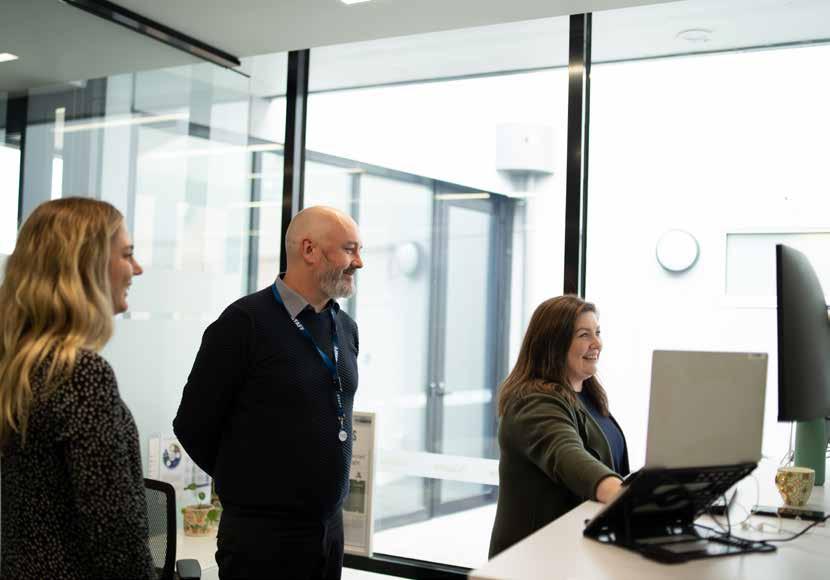
HIGHLIGHTS OF 2021/22
The following statement reviews the performance of Council against the strategic indicators included in the Council Plan 2021-2025.
Strategic Objective: 5.1 Information and engagement to involve community in decision making
Council published extensive, informative and engaging communications across its many channels in 2021/22 including:
• Council’s website
• Social media
• Publication and distribution of the Gazette
• Engage eNewsletter
• eGazette
• Council News in the Golden Plains Times
• Council News in local community newsletters
Open community consultation processes in 2021/22 were undertaken via in-person engagements, digital and print surveys, and public exhibition of key strategies and plans on many important subjects including:
• Asset Plan 2022-2032
• Council Budget 2022/23
• Inverleigh Tree Succession Plan
• Customer Experience Strategy 2022-2026
• Economic Development, Tourism & Investment Attraction Strategy 2022-2032
• Climate Emergency Plan 2022-2032
Council presented formal opening events in 2021/22 to mark the delivery of many community infrastructure projects including for the Inverleigh Change and Social Rooms Upgrade, Linton Cricket Nets, Golden Plains Youth Hub, Digital Hub in Smythesdale, Lethbridge Lighting and Irrigation Project, Bannockburn Soccer Pavilion Upgrade, Bannockburn Skate Park and Franklin Bridge in Napoleons.
Strategic Objective: 5.2 Accountable and transparent governance and financial management
Implementation of new requirements under Local Government Act 2020 is now complete, with all items adopted within the required timeframes. This included a comprehensive review of the Council’s Governance Rules, with changes and improvements made to enhance good governance and Council meeting procedures.
In accordance with the Local Government Act 2020, Council’s Annual Budget 2022/23 was developed including deliberative community engagement processes and was adopted by Council in June 2022. The annual review of Procurement policies was completed in October 2021, with the next review due in October 2022.
A Risk Management Consultant has been engaged to guide the implementation of Council’s Risk Management Framework and a risk management software system was identified. The Consultant and Governance & Risk Team will develop and deliver workshops with business units to identify and develop mitigation processes for strategic and organisational risks.
Development of the Asset Plan was undertaken with adoption by Council in June 2022, in accordance with legislative requirements. Implementation of the Assetic software system has progressed with all built assets now registered in Assetic, allowing for a single source of truth for these asset types.
Strategic Objective: 5.3 Responsive service delivery supported by systems, resources and an engaged workforce
Development of Council’s Customer Experience Strategy, including community engagement, has been undertaken with consultancy company, CX Loop. The Draft Strategy was available for public exhibition in March 2022 and was adopted by Council on 26 April 2022. The Strategy is supported by an Action Plan with initiatives to help drive cultural change across the business to improve Council’s customer experience.
Progress on organisational development activities to drive workplace engagement, capability and performance has included:
• A Workforce Plan and strategic resourcing review was completed.
• Council’s Capability Framework was developed and launched.
• The Values Champions’ group has driven the delivery of the ‘Take a Bow’ program, with a mini staff engagement survey also undertaken.
• A new Learning & Development Framework and Program has been developed and launched.
Improving and streamlining of ICT systems and processes has included:
• Development and completion of a new Digital ICT Strategy.
• Implementation of new customer, property, financial and regulatory systems with a planned go live date in October 2022.
• A review of GIS services and systems commenced.
• Knowledge management and collaboration is focused on the implementation of a new electronic document and records management system (EDRMS).
Strategic Objective: 5.4 Planning, advocating and innovating for the future
Council continues to develop funding and partnership opportunities through representation on networks and regional alliances to connect and advocate for regional priorities including through G21, MAV, Central Highlands Council Victoria and the Peri-Urban Group of Councils.
Advocacy in the lead up to the May 2022 Federal Election was successful in attracting $3.61 million across 7 projects in Golden Plains Shire including:
• $750,000 towards the reconstruction of Linton Recreation Reserve Oval
• $500,000 towards oval and netball lighting at Woady Yaloak Recreation Reserve in Smythesdale
• $350,000 towards the Maude Community Hub
• $700,000 towards the Inverleigh Active Youth Space
• $690,000 towards a new netball pavilion at Victoria Park in Bannockburn
• $450,000 towards the expansion of the Bannockburn Family Services Centre
• $170,000 for an undercover basketball court at Inverleigh Primary School
Planning of future service provision and infrastructure needs was a key focus of the Community Services and Infrastructure Plan, which was completed and provided to Council in August 2021.
Strategic Indicators
The following statement reviews the performance of Council, detailing results achieved in relation to the strategic indicators in the Council Plan 2021-2025.
Strategic Indicator
Community Satisfaction with Council’s consultation and engagement
Current Value and year Previous Result and year
Similar Council or Victorian Average
49 (2022) 47 (2021) 51 (2022) Similar Council
Own source revenue per head of municipal population $1171.57 $1148 (2020/21) $1638 (2020/21)
Similar Council
Community Satisfaction with Council lobbying on behalf of community 51 (2022) 50 (2021) 51 (2022)
Similar Council
Community Satisfaction rating with Council’s Customer Service 64 (2022) 62 (2021) 67 (2022)
Similar Council
Value of "recurrent" grants per head of population $558.17 $552.11 (2020/21) $501 (2020/2021)
Community Satisfaction on Council’s decisions being made in the interests of the community
50 (2022) 49 (2021) 51 (2022)
Similar Council
Staff turnover rate 24.06% (2021/22) 29.40% (2020/21) 13.95% (2020/21)
Similar Council
Major Initiatives
The following statement reviews the progress of council in relation to major initiatives identified in the Council Budget 2021/22.
Major Initiatives Progress
Communications & Engagement Council is preparing to undertake a community engagement plan to develop and deliver a new inclusive Communications, Events and Engagement Strategy.
• Deliver a new inclusive Communications, Events and Engagement Strategy
• Implement Council’s new Community Engagement Policy and develop quality, genuine engagement for all residents, including strengthening the Councillor Engagement program
• Review and update Council’s digital communications channels including websites, social media, and e-newsletters including the e-Gazette and the Community Engagement Register
• Undertake a photography project to build a diverse library of images and videos of Shire events, locations and people of all ages and abilities
Customer Service Centres
• Develop and begin implementing a Customer Experience Strategy that ensures Golden Plains Shire Council is an agile, capable and sustainable Council into the future
• Develop and adopt a Complaints Handling Policy and a framework to support staff in dealing with complaints consistently and efficiently
Under the guidance of its Community Engagement Policy, Council delivered a significant range of community engagement processes including surveys, in-person and online conversation posts, community reference groups and workshops for the more than 30 projects, programs and plans.
A significant redesign and redevelopment of Council’s website was completed in 2021/22, improving the accessibility, inclusiveness, navigation, functionality and security of the primary site.
The engagement has increased on Council’s social media channels with new, diverse content and Council launched the eGazette e-newsletter and increased participation in the Community Engagement Register.
The photography project has progressed with an audit and collation of Council’s existing library of images, identifying gap in diverse and inclusive representation of people and taking measures to complete the range of images on file and regularly published including more locations and events.
The Customer Experience Strategy 2022–2026 was adopted by Council in April 2022. The Strategy puts in focus Council’s clear direction for customer experience and the commitment it makes to customers which aligns with the broader Council Plan and reflects the Vision and Values of the organisation. The Strategy was also supported by an action plan with initiatives to help drive cultural change across the business to improve our customer experience.
Council’s Complaints Handling Policy was adopted in December 2021, in line with the Local Government Act 2020 and requirements of the Victorian Ombudsman. The Complaints Handling Policy was the first step in ensuring accountability across the organisation for customer complaints. In the next year, Council will implement effective systems and processes to help track, monitor and learn from complaints.
People and Culture Council consulted across the organisation to develop the Gender Equality Action Plan (GEAP), in line with the requirements of the Gender Equality Commission. Council received confirmation that the GEAP was compliant and will shift focus to implementation and delivery of the action across the remaining three years of the GEAP.
• Implement the Gender Equality Action Plan to create leadership opportunities for diverse women, ensure an enabling workplace culture and embed a gender inclusive approach to community programs, services and infrastructure
• Implement the requirements of the Local Government Act including development of the CEO Recruitment and Remuneration Policy and Workforce Plan
Corporate Planning
• Commence implementation of the adopted Council Plan 2021-2025 in accordance with the provisions of the Local Government Act 2020
Governance
• Implement policies that continue to promote transparency and accountability to support Council to achieve its short-, medium- and long- term goals for the municipal community
Occupational Health and Safety
• Provide a structured Occupational Health and Safety System to Council
• Upskill Council leaders in key Occupational Health and Safety Areas
• • Improve response to emerging hazards
Council have developed a CEO Recruitment & Remuneration Policy and appointed an independent chair to the CEO Recruitment & Remuneration Committee.
Council developed and finalised the Workforce Plan in December 2021, working through the initiatives, and committed to reviewing the plan annually.
Implementation of the Council Plan 2021-2025 (adopted 29 June 2021)
commenced on 1 July 2021, in accordance with the Local Government Act 2020. Quarterly reports on progress are provided to Council Meetings.
Council has commenced implementation and roll out of a Strategy Management software solution to enhance Council Plan reporting and management.
Council has adopted and implemented policies, strategies and plans throughout 2021/2022, including:
• Completing the implementation of the Local Government Act 2020 requirements.
• The review and adoption of Local Law 1 – General Public Amenity.
• Adoption and implementation of strategies and plans to guide Council in achieving its objectives, including the Customer Experience Strategy, Northern Streetscape Framework Plan and Asset Plan.
• Development of the Project Management Framework has been completed and is in implementation.
In 2021/22, Council has continued the management of the COVID-19 pandemic, and supporting the safety and wellbeing of staff to meet requirements and government directives created a significant workload. Subsequently, other initiatives have not yet progressed as intended and further implementation is planned for 2022/2023. Upskilling leaders in key Occupational Health and Safety (OHS) Areas has included OHS training modules being implemented and rolled out online via the learning management system. This will be further supported and embedded in 2022/23 with face-to-face training programs.
To improve response to emerging hazards, the OHS team has used the OHS Management System to capture and respond. Further steps to proactively respond and address hazards will be implemented in 2022/23.
Risk Management Council has continued the development of its risk management processes following the adoption of its Risk Management Framework in December 2020. This has included the development of risk assessment tools aligned with the Risk Management Framework, the completion of an insurable risk register and loss limit analysis, and the ongoing development of risk management workshops to identify risks and develop controls across the organisation. The risk management workshops are intended to be delivered in 2022/23.
• Expand Risk Management Systems across Council to mitigate risks and ensure the most appropriate use of Council resources
Records Management
• Implementation of a corporate Digitisation Plan for greater accessibility to corporate records
Digital Transformation
• Delivery of the key actions of the corporate Digital Transformation Strategy covering the four pillars: Data and Information Reform, Digital Opportunity, Technology Reform, and Capability Uplift
The Digitisation Plan includes the replacement of the Document Management System, which is scheduled to go live in October 2022.
This includes a single business classification scheme and consolidation of all documents into one searchable and accessible store. The inward correspondence digitisation plan is geared to the delivery of this project.
The key outcomes in the past 12 months were:
• Successful application to the Rural Council Transformation Program for the establishment of an Internet of Things Network
• Development and adoption of the Information Management Strategy
• Continued implementation and configuration of new finance, property, rates, customer and records systems due to go live in October 2022
• Installation of new payroll system
• Web platform upgrade
• Implement and boost for cyber security initiatives
• The Digital Transformation Strategy expired during this year and the new Strategy has been adopted for the next three years
Asset Management Program of works associated with Service Planning has been developed, as detailed in the organisations Asset Management Plans.
• Service Planning & Asset Rationalisation Review
• Building Inspections and Condition Consideration
• Road and Bridge asset revaluation and condition assessment
• Implementation of Asset Management System
Work on further Service Planning is scheduled to commence in 2023/24. The building condition assessments were not scheduled for 2021/22 and are next due to be undertaken 2023/24. Bridge & Road Condition Assessments were not scheduled for 2021/22 and are due to be undertaken 2023/24. The Bridge and Road Revaluation is due in 2024/25. Capital project for Asset Management System (AMS) implementation is complete.
Ongoing in-house implementation of AMS continues including:
• Work Orders for Buildings (reactive, planned and scheduled maintenance)
• Work Orders for Roads & Drainage (reactive, planned and scheduled maintenance)
• Road and Footpath Inspections using Assetic
• Integration of Assetic with other core systems (such as CouncilFirst and GIS)
• Timing of the above activities are subject to resourcing and available funding.
Services
The following statement provides information in relation to the services funded in the Council
the persons or sections of the community who are provided the service.
Service Area Description of Service
Communications and Engagement
Articulate clearly Council initiatives, strategies, benefits and services to internal and external stakeholders through strong story-telling and professional design in communication channels including corporate publications, traditional and digital media, and online. Deliver and support genuine engagement with local communities and Golden Plains Shire residents.
Customer Service Centres
To provide consistent, high quality customer service, by managing, resolving and preventing problems; empowering and educating our customers with self-service tools and solutions; and communicating effectively and exceeding customer expectations which will enable Council and our community to reach their goals.
Governance
To promote Council's organisational values - pride, respect, integrity, collaboration and excellence. To ensure principles of 'good' governance principles guide decision-making and contribute to the strategic direction of Council and outcomes for the community.
Elections Maintenance of voters’ rolls in readiness for elections.
Meetings
Conduct Council meetings, committee meetings, workshops and other meetings of Council with management.
Corporate Planning
Maintenance of an integrated approach to corporate planning, financial planning, budgeting and resource allocation, and the maintenance and measurement of organisational performance to meet customer service needs.
Occupational Health and Safety
Risk Management
To develop, build and identify effective management of Council's exposure to all forms of Occupational Health and Safety risk and to foster safer workplaces.
develop, build and identify effective management of Council's exposure to all forms of risk and to foster safer places and environments within the municipality.
General revenue
Levying of rates and charges, managing and collecting interest on rates, receipt of Victoria Grants Commission general purpose grant, managing investments to maximise interest and accounting for subdivisions handed to Council.
33,530 29,808 (3,722)
Property and Rating
Management of Council’s rating system, including levying rates and charges, outstanding interest and valuing all rateable properties.
Corporate Reporting and Budgeting
Procurement and Contract Management
Preparation of Council’s Annual Budget, annual financial statements, Financial Plan, and other statutory returns in accordance with statutory requirements.
Develop and maintain documented standards for procurement governance and procurement process which result in value for money outcomes and minimal procurement risk. Also, develop the contract management capacity of Council.
Borrowings
319 370 (51)
366 395 (29)
404 376 (28)
Effective management of Council borrowings. 255 261 (6)
Plant Replacement Management and replacement of Council’s plant and equipment in accordance with the plant replacement schedule.
Asset Management
Strategic Management of Council’s significant asset base including but not limited to roads, bridges, footpaths, buildings, recreation reserves, drainage systems, parks and playgrounds.
129 51 (78)
909 996 (87)
service Performance Indicators
The following
Statutory Planning Results
Transparency 0.92% 5.31% 2.70% 9.03% In 2021/22 Council made 13 resolutions in meetings closed to the public compared to 6 in 2020/21 and 11 in 2019-20.
Council decisions made at meetings closed to the public [Number of council resolutions made at ordinary or special meetings of council, or at meetings of a special committee consisting only of councillors, closed to the public / Number of council resolutions made at ordinary or special meetings of council or at meetings of a special committee consisting only of councillors] x100
Consultation and engagement 47.00 49.00 47.00 49.00
Satisfaction with community consultation and engagement [Community satisfaction rating out of 100 with how council has performed on community consultation and engagement]
Attendance 96.94% 95.92% 99.05% 96.94% Slight drop in average number of councillors attending council meetings in 2021/22.
Councillor attendance at council meetings [The sum of the number of councillors who attended each ordinary and special council meeting / (Number of ordinary and special council meetings) x (Number of councillors elected at the last council general election)] x100
Service cost $42,699.71 $44,124.14 $39,805.86 $49,552.43 Higher governance costs in 2021/22 compared to 2020/21.
Cost of elected representation [Direct cost of the governance service / Number of councillors elected at the last council general election]
Satisfaction 47.00 47.00 49.00 50.00
Satisfaction with council decisions [Community satisfaction rating out of 100 with how council has performed in making decisions in the interest of the community]
Other
Utilisation n/a n/a n/a n/a Golden Plains Shire Council does not operate any Aquatic Facilities
Utilisation of aquatic facilities [Number of visits to aquatic facilities / Municipal population]
Service cost n/a n/a n/a n/a Golden Plains Shire Council does not operate any Aquatic Facilities Cost of aquatic facilities [Direct cost of aquatic facilities less income received / Number of visits to aquatic facilities]
Retired service performance indicators
Service/ Indicator/
Aquatic Facilities
Service cost
Cost of indoor aquatic facilities
[Direct cost of indoor aquatic facilities less income received / Number of visits to indoor aquatic facilities]
Cost of outdoor aquatic facilities
[Direct cost of outdoor aquatic facilities less income received / Number of visits to outdoor aquatic facilities
Animal Management
Service cost
Cost of animal management service
[Direct cost of the animal management service / Number of registered animals]
Health and safety
Animal management prosecutions
[Number of successful animal management prosecutions]
Libraries
Service cost
Cost of library service
[Direct cost of the library service / Number of visits]
Maternal and Child Health (MCH)
Satisfaction
Participation in first MCH home visit
[Number of first MCH home visits / Number of birth notifications received] x100
n/a
This measure was replaced by Cost of aquatic facilities for 2020.
Golden Plains Shire Council does not operate Aquatic Facilities.
n/a
This measure was replaced by Cost of aquatic facilities for 2020.
Golden Plains Shire Council does not operate Aquatic Facilities.
$45.80
This measure was replaced by Cost of animal management service per population for 2020.
5
This measure was replaced by Animal management prosecutions (%) for 2020.
$6.34
This measure was replaced by Cost of library service per population for 2020.
99.2%
This measure was replaced by Participation in 4-week Key Age and Stage visit for 2020.
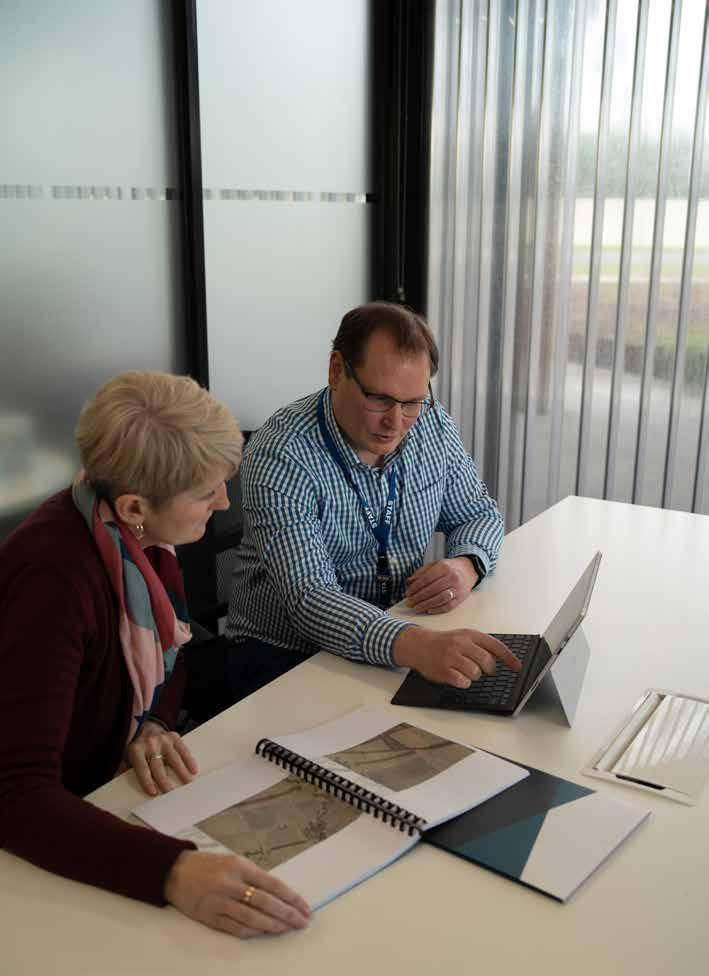
GOVERNANCE
Council has a number of important roles including:
• Taking into account the diverse needs of the local community in decision-making;
• Providing leadership by establishing strategic objectives and monitoring achievements;
• Ensuring that resources are managed in a responsible and accountable manner;
• Advocating the interests of the local community to other communities and governments; and
• Fostering community cohesion and encouraging active participation in civic life.
Council is committed to effective and sustainable forms of democratic and corporate governance as the key to ensuring that Council and its administration
Councillor
Mayor
Deputy
Cr
meet the community’s priorities.
The community has many opportunities to provide input into Council’s decision-making processes including community consultation, surveys, committees and reference groups, public forums and the ability to make submissions to Council.
Council’s formal decision-making processes are conducted through council meetings. Council delegates the majority of its decision-making to Council staff. These delegations are exercised in accordance with adopted Council policies.
Meetings of Council Council conducts open public meetings on the fourth Tuesday of each month. Members of the community are welcome to attend these meetings and observe from the gallery. Council meetings also provide the opportunity for
Meetings
community members to make a submission to speak to an item or to ask a question during Public Question Time. All Council meetings are recorded and livestreamed on Council’s YouTube page.
On matters presented to Council for decision, Council meetings provide an opportunity for community members to address the Council in support of their submissions. The procedures at Council meetings are provided for in Council’s Governance Rules.
For the 2021/22 year, Council held the following meetings:
• 13 scheduled Council meetings
• 1 unscheduled Council meeting
The following table provides a summary of Councillor attendance at scheduled meetings of Council and unscheduled meetings of Council for the 2021/22 financial year.
Meetings Total Meetings
Golden Plains Shire Council is constituted under the Act to provide leadership for the good governance of the municipal district and the local community.
Delegated Committees
Council can establish delegated committees consisting of Councillors, Council staff, other persons or any combination of these persons. There were no Delegated Committees established by Council in the 2021/22 year.
Councillor Code of Conduct
Council reviewed and adopted a new Councillor Code of Conduct 2021 and Councillor Dispute Resolution Policy 2021 at its scheduled meeting on 23 February 2021.
The Councillor Code of Conduct 2021 (Code of Conduct) sets out the values and standards of conduct Councillors have committed to adopting in the performance of their role.
The Code of Conduct requires Councillors to be accountable, transparent, collaborative and engaged with the municipal community. Councillors must treat others with dignity, fairness, objectivity, courtesy and respect, including taking positive action to eliminate discrimination, sexual harassment and victimisation, and supporting Council to achieve and promote gender equality.
The Code of Conduct operates in conjunction with the Councillor Dispute Resolution Policy 2021. This policy sets out the formal processes adopted to manage allegations of misconduct, serious misconduct and gross misconduct made against a Councillor for alleged breaches of the Code of Conduct and Local Government Act 2020.
Good Governance Principles
The Code of Conduct imposes specific obligations on Councillors when performing their duties and functions, including giving effect to overarching principles of ‘good’ governance. This obligation requires Councillors to:
• Make decisions and take action in accordance with the relevant law.
• Give priority to achieving the best outcomes for the municipal community, including future generations.
• Promote the economic, social and environmental sustainability of the municipal district, including mitigation and planning for climate change risk.
• Engage the municipal community in strategic planning and strategic decision-making.
• Pursue innovation and continuous improvement.
• Seek to collaborate with other councils, governments and statutory bodies.
• Ensure the ongoing financial viability of Council.
• Consider regional, state and national plans and policies in strategic planning and decision-making.
• Ensure the transparency of Council decisions, actions and information.
When giving effect to these principles, Councillors are required to engage in meaningful and informed community engagement, describe the ways Council information will be made publicly available, adopt an integrated approach to the preparation of strategic documents, focus on
the ongoing financial viability of Council, and provide a framework for Council to deliver services to the municipal community.
Conflict of Interest
Councillors are elected to represent the diversity of needs and interests of the municipal community. This is a position of trust that requires Councillors to act in the public interest. A conflict of interest arises when Councillor’s private interests could result in that person acting in a manner that is contrary to their public duty, or a Councillor could gain a benefit or suffer a loss depending on the outcome of the matter.
A Councillor exercising a power, duty or function, or making a decision in relation to any matter must disclose a conflict of interest and exclude themselves from the decision-making process.
Declarations of conflicts of interest are a standard agenda item at all Council meetings. The minutes of Council meetings record all disclosed conflict of interests. During 2021/22, 2 conflicts of interest were declared at Council meetings and 1 was declared at a Strategic Briefing meeting and reported to the next Council meeting.
The obligation to declare a conflict of interest and exclude oneself from the decision-making process also applies to Council officers or members of Delegated Committees when Council delegates its powers to the individual or group.
Councillor Allowances
Under the Local Government Act 2020, Mayors, Deputy Mayors, and Councillors are entitled to receive an allowance in accordance with a determination of The Victorian Independent Remuneration Tribunal (the ‘Tribunal’).
Councils are divided into three categories based on the income and population of each council.
Golden Plains Shire Council is recognised as a Category 2 council. The Tribunal determined from 18 December 2021 to 17 December 2022 the allowance for a Category 2 Councillor would be $30,024, for the Deputy Mayor $48,235, and for the Mayor $96,470. The value of the allowance payable to a Council member is inclusive of any Superannuation Guarantee Contribution amount.

The Tribunal’s Determination was published on 7 March 2022, and applied retroactively from 18 December 2021. The following table contains the allowances paid to the Mayor, Deputy Mayor and Councillors in 2021/22, inclusive of a backpay dated to 18 December 2021 in line with the Tribunal’s Determination.
Councillor Allowance
Mayor Cr Gavin Gamble $65,941.96
Deputy Mayor Cr Helena Kirby $54,537.65
Cr Brett Cunningham $27,224.02
Cr Ian Getsom $27,224.02
Cr Les Rowe $27,224.02
Cr Owen Sharkey $27,224.02
Cr Clayton Whitfield $27,224.02
Crs Clayton Whitfield, Gavin Gamble and Owen Sharkey met with residents to discuss the Climate Emergency Plan 2022-2032 at the Golden Plains Farmers’ Market in Bannockburn.Councillor and Delegated Committee Member Expenses
Council is required to reimburse Councillors and delegated committee members for expenses incurred whilst performing their role. Council is required to adopt a policy for the reimbursement of expenses for Councillors and delegated Committee members. The policy contains procedures to be followed in applying for, and the reimbursement of, expenses.
The details of the Councillor expenses for the 2021/22 year are set out in the following table:
Councillor Travel Council Car Expenses Childcare
Information & Communications Conference & Training Total $
Mayor Cr Gavin Gamble 377.70 1,810.85 535.35 1,590.33 4,314.23
Cr Helena Kirby 2,426.96 869.13 166.82 4,999.74
Cr Brett Cunningham 563.71 54.55 618.26
Cr Ian Getsom 2,294.48 565.52 152.27 3,012.27
Cr Les Rowe 1,764.68 567.04 133.32 2,465.04
Cr Owen Sharkey 27.10 534.60 164.52 726.22
Cr Clayton Whitfield 534.96 655 1,189.96
Audit & Risk Committee Independent Members Sitting Fee
Independent Member Sitting Fee
Joseph Adamski $2,932.50
Philip Delahunty $2,346.00
Andrew Pearce $3,516.96
The following expenses were paid to Independent Members of the Audit & Risk Committee: Independent Member Travel Car Mileage Information & Communications Conference & Training Total $
Joseph Adamski $62.10 $62.10 Philip Delahunty Andrew Pearce
The Local Government Act 2020 requires Council to undertake an assessment against the prescribed governance and management checklist and include this in its report of operations. Council’s Governance and Management Checklist results are set out in the section below. The following items have been highlighted as important components of the management framework.
AUDIT AND RISK COMMITTEE
The Audit and Risk Committee’s role is to oversee and monitor the effectiveness of Council in carrying out its responsibilities for accountable financial management, good corporate governance, maintaining an effective system of internal control and risk management, and fostering an ethical environment. The Audit and Risk Committee consists of three independent members, Mr Andrew Pearce (Chair), Mr Joe Adamski, Mr Philip Delahunty and two Councillors. Independent members are appointed for an initial term of up to three years, and may be reappointed for two additional three year terms, for a maximum of nine total years.
The Audit and Risk Committee meets a minimum of four times a year. The Chief Executive Officer, Director Corporate Services, Director Infrastructure and Development, Director Community Services and Manager Finance attend all Audit and Risk Committee meetings. Council’s Internal Auditors attend as required to present reports. The external auditors generally attend in February, May and September each year to present the audit plan, interim management letter and independent audit report respectfully.
Recommendations from each Audit and Risk Committee meeting are subsequently reported to, and noted by, Council.
INTERNAL AUDIT
Council’s internal audit function provides independent and objective assurance that the appropriate processes and controls are in place across Council. The function is provided by an external provider. A risk-based, three-year Strategic Internal Audit Plan (SIAP) is revised annually to ensure the audit resources remain focused on the appropriate areas. The review process considers Council’s risk framework, the Council Plan, the impact of any change on operations, systems or the
business environment prior audit coverage and outcomes, and management input. The SIAP is reviewed and approved by the Audit and Risk Committee.
The Internal Auditor generally attends all Audit and Risk Committee meetings to report on the status of the SIAP, to provide an update on the implementation of audit recommendations and to present findings of completed reviews. All audit issues identified are risk rated. Recommendations are assigned to the responsible Manager and tracked accordingly.
Managers provide quarterly status updates that are reviewed by the Internal Auditor and reported to the Audit and Risk Committee.
Quality assurance is measured through annual client satisfaction surveys, the annual Audit and Risk Committee self-assessment, completion of the internal audit plan and benchmarking against other internal audit functions.
The SIAP for 2021/22 was completed with the following reviews conducted:
• Data Analytics
• Cyber Security
• HR Review - Part 2 - HR Processes
• Complaints Handling
• Incoming non-recurring Grants
Council has implemented a number of statutory and better practice items to strengthen its management framework. Having strong governance and management frameworks leads to better decision-making by Council.
EXTERNAL AUDIT
Council is externally audited by the Victorian Auditor-General. In 2021/22, the annual external audit of Council’s Financial Statements and Performance Statement was conducted by the Victorian Auditor-General’s Office.

The external auditors generally attend the February, May and September Audit and Risk Committee meetings to present the annual audit plan, interim management letter and Independent Audit Report respectfully. The final external audit management letter and responses are also provided to the Audit and Risk Committee.
RISK MANAGEMENT
Risk management is critical to the achievement of the Council Plan’s strategic objectives. Prudent decision-making regarding the use of Council’s human, financial and physical resources is vital to attaining Council’s vision of offering a lifestyle and opportunities that foster social and economic wellbeing.
Council has adopted the Risk Management Framework in line with current best practice in the management of business enterprise risks and current AS/NZS 31000 guidelines. The Risk Management Framework addresses items such as:
• Risk management commitment
• Best practice in risk management
• Roles and accountabilities
• Communication and consultation
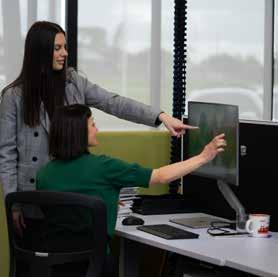
• Risk management process
• Risk registers
• Monitoring and review
GOVERNANCE AND MANAGEMENT CHECKLIST
Golden Plains Shire Council is constituted under the Local Government Act 2020 to provide leadership for the good governance of the municipal district and the local community.
Governance and Management Items Assessment
1. Community Engagement Policy
(policy outlining Council’s commitment to engaging with the community on matters of public interest)
2. Community Engagement Guidelines
(guidelines to assist staff to determine when and how to engage with the community)
3. Financial Plan
(plan under section 91 of the Local Government Act 2020 outlining the financial and non-financial resources required for at least the next 10 financial years)
4. Annual Budget
(plan under section 94 of the Local Government Act 2020 setting out the services to be provided and initiatives to be undertaken during the budget year and the funding and other resources required)
5. Asset Plan
(plan under section 92 of the Local Government Act 2020 setting out the asset maintenance and renewal needs for key infrastructure asset classes for at least the next 10 years)
6. Revenue and Rating Plan
(plan under section 93 of the Local Government Act 2020 setting out the rating structure of Council to levy rates and charges)
7. Risk Policy
(policy outlining Council’s commitment and approach to minimising the risks to Council’s operations)
8. Fraud Policy
(policy outlining Council’s commitment and approach to minimising the risk of fraud)
Adopted in accordance with section 55 of the Local Government Act 2020
Date of adoption: 23 February 2021
Incorporated into the Community Engagement Policy (Appendix 2 & 3).
Date of adoption: 23 February 2021
Adopted as part of the new Council Plan 2021-2025 on 29 June 2021, in accordance with section 91 of the Local Government Act 2020.
Adopted in accordance with section 94 of the Local Government Act 2020
Date of adoption: 28 June 2022
Adopted in accordance with section 92 of the Local Government Act 2020
Date of adoption: 28 June 2022
Adopted in accordance with section 93 of the Local Government Act 2020.
Date of adoption: 28 June 2022
Incorporated into the Risk Management Framework 2020.
Date of adoption: 23 July 2020
Date of adoption: 26 November 2019
Governance
9. Municipal Emergency Management Plan
(plan under section 20 of the Emergency Management Act 1986 for emergency prevention, response and recovery)
10. Procurement Policy
(policy under section 108 of the Local Government Act 2020 outlining the principles, processes and procedures that will apply to the purchase of goods and services by the Council)
11. Business Continuity Plan
(plan setting out the actions that will be undertaken to ensure that key services continue to operate in the event of a disaster)
12. Disaster Recovery Plan
(plan setting out the actions that will be undertaken to recover and restore business capability in the event of a disaster)
13. Risk Management Framework
(framework outlining Council’s approach to managing risks to the Council’s operations)
14. Audit & Risk Committee
(advisory committee of Council under section 53 & 54 of the Local Government Act 2020 whose role is to oversee the integrity of a Council’s financial reporting, processes to manage risks to the Council’s operations and for compliance with applicable legal, ethical, and regulatory requirements)
15. Internal audit
(independent accounting professionals engaged by the council to provide analyses and recommendations aimed at improving Council’s governance, risk, and management controls)
16. Performance reporting framework
(a set of indicators measuring financial and non- financial performance, including the performance indicators referred to in section 98 of the Local Government Act 2020)
17. Council Plan Report
(quarterly report reviewing the performance of the council against the Council Plan, including the results in relation to the strategic indicators, for the first six months of the financial year)
18. Financial reporting
(quarterly statements to Council under section 97 of the Local Government Act 2020 comparing actual and budgeted results and an explanation of any material variations)
19. Risk Management & Insurance Reporting
(quarterly reports of strategic risks to Council’s operations, their likelihood, and consequences of occurring and risk minimisation strategies)
20. Performance Reporting
(six monthly reports of indicators measuring results against financial and non-financial performance, including the performance indicators referred to in section 98 of the Local Government Act 2020)
Prepared and maintained in accordance with section 60ADB of the Emergency Management Act 2013
Date of preparation: November 2021
Adopted in accordance with section 108 of the Local Government Act 2020
Date of adoption: 26 October 2021
Date of adoption: July 2018
Last updated: June 2020
Incorporated into the Business Continuity Plan.
Date of adoption: July 2018
Date of adoption: 15 December 2020
Established in accordance with section 53 of the Local Government Act 2020
Date of establishment: 27 February 1997
Date of engagement of current provider: 11 September 2018
Date of adoption: 1 July 2014
Date reports presented:
23 November 2021, 22 February 2022, 28 June 2022, 23 August 2022
Statements presented to council in accordance with section 97 of the Local Government Act 2020
26 October 2021, 22 February 2022, 26 April 2022, 26 July 2022
Date Reports Presented:
14 September 2021, 9 November 2021, 8 February 2022, 10 May 2022
Date of Report: 23 November 2021, 26 April 2022
Governance and Management Items Assessment
21. Annual Report
(annual report under sections 98 and 99 of the Local Government Act 2020 containing a report of operations and audited financial and performance statements)
22. Councillor Code of Conduct
(Code under section 139 of the Local Government Act 2020, setting out the standards of conduct to be followed by Councillors and other matters)
23. Delegations
(Document setting out the powers, duties and functions of council and the Chief Executive Officer that have been delegated to members of staff, in accordance with sections 11 and 47 of the Local Government Act 2020)
Presented at a meeting of the Council in accordance with section 100 of the Local Government Act 2020 on 28 September 2021.
Reviewed and adopted in accordance with section 139 of the Local Government Act 2020
Date adopted: 23 February 2021
Reviewed in accordance with section 11(7) of the Local Government Act 2020 and a register kept in accordance with sections 11(8) and 47(7) of the Local Government Act 2020.
Date of Review

Council to CEO: 24 August 2021
Council to Staff (EPA 2017): 24 August 2021
Council to Staff: 24 August 2021, 28 June 2022
24. Meeting procedures
(governance rules under section 60 of the Local Government Act 2020 governing the conduct of meetings of Council and delegated committees)
Governance Rules adopted in accordance with section 60 of the Local Government Act 2020
26 October 2021
I certify that

fairly
status of Council’s governance and management arrangements.
Eric Braslis Cr Gavin Gamble Chief Executive Officer Mayor
STATUTORY
DOCUMENTS AVAILABLE FOR PUBLIC INSPECTION
In accordance with sections 57 and 58 of the Local Government Act 2020, the following documents are available for public inspection or copies of the documents can be obtained at Golden Plains Civic Centre, 2 Pope Street, Bannockburn:
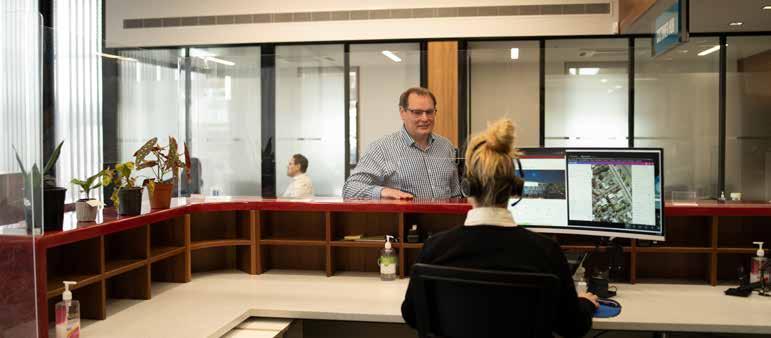
• a document containing details of overseas or interstate travel (other than interstate travel by land for less than three days) undertaken in an official capacity by a Councillor or any member of Council staff in the previous 12 months.
• agendas for, and minutes of, Scheduled and Unscheduled meetings held in the previous 12 months, other than those agendas and minutes relating to a part of a meeting which was closed to members of the public under section 66 of the Local Government Act 2020 and are confidential information within the meaning of section 3(1) of the Local Government Act 2020
• the minutes of meetings of Delegated Committees established under section 63 of the Local Government Act 2020 and held in the previous 12 months, other than those minutes relating to a part of a meeting, which was closed to members of the public under section 66 of the Local Government Act 2020 and are confidential information within the meaning of section 3(1) of the Local Government Act 2020
• a register of delegations kept under sections 11(8) of the Local Government Act 2020, including the date on which the last review took place.
• a document containing details of all leases involving land which were entered into by Council as lessor, including the lessee and the terms and the value of the lease.
• a register maintained under section 224(1A) of the Local Government Act 1989 of authorised officers appointed under that section.
• a list of donations and grants made by Council in the previous 12 months, including the names of persons who, or bodies which, have received a donation or grant and the amount of each donation or grant.
SERVICE PERFORMANCE PRINCIPLES
In accordance with section 106 of the Local Government Act 2020, Council is to comply with the six Best Value principles and to report to the community at least once a year on how this has been achieved.
The principles relate to:
• Quality and cost standards
• Responsiveness to community needs
• Accessibility
• Continuous improvement
• Community consultation
• Reporting to the community
Golden Plains Shire Council has embraced all of these principles by incorporating them into its management planning process to ensure it provides the services that best reflect the needs of the community. Council’s commitment is demonstrated though various initiatives including:
• Service reviews and briefings to Council
• Enhanced community consultation, listening posts, and online feedback
• A Council Plan which is reflective of the community’s needs
• Community Satisfaction Surveys
• Community planning framework
• Supporting local and regional procurement practices
• Collaboration with other Councils and various agencies
CARERS RECOGNITION
The Carers Recognition Act 2012 formally acknowledges the important contribution that people in care relationships make to our community and recognises, promotes and values the role of people in care relationships.
As a care support organisation, Golden Plains Shire Council considers the care relationship principles when developing and implementing policies, programs and services that affect people in care relationships.
Council values the active participation and contribution of all carers. Carers are specifically involved in individual care planning development, monitoring and review. Carers continue to play an active role, formally and informally as they connect with the activities of the Social Support programs. Respite services provide flexible and responsive support for carers, recognising the value of their caring role.
CONTRACTS
Council did not enter into any contracts valued at $150,000 or more for goods and services, or $200,000 or more for construction works, without first engaging in a competitive process, in accordance with Section 108 and 109 of the Local Government Act 2020, and Council’s Procurement Policy.
DISABILITY ACTION PLAN
The Disability Act 2006 (Section 38) requires all government organisations to have a Disability Action Plan (or similar). A Disability Action Plan identifies actions to remove physical, civic and attitudinal barriers for people with a disability. It is also designed to increase employment opportunities and influence community attitudes.
At its meeting on 23 February 2021, Council resolved to adopt the Active Ageing & Inclusion Plan 2020-2024 (AAIP), which ensures Council’s continued compliance with the Disability Act 2006 legislative requirements.
The information contained in the AAIP builds on the work undertaken previously in the Access and Inclusion Plan 2016-2019 and the Ageing Well in Golden Plains Shire Strategy and Action Plan 2012-2016.
The AAIP provides the framework for Council to address current and future needs of older residents and people with disability and will assist to improve awareness of ageing, disablement and associated issues. The Plan also ensures continued support for people with disabilities and other access challenges to engage with Council and access all areas of the organisation’s operations.
A key component in the development of the AAIP was consultation with the Golden Plains’ community, as well as Council staff.
The AAIP identifies four priority areas for access and inclusion in order to meet objectives and goals over the next four years:
1. Our Social Environment –Accessible events, community grants, consultations, social supports and diversity.
2. Our Support Environment –Aged and disability services, transport and safety, and continuing to strive to achieve best practice whilst considering the impacts of policy and funding changes in the sector.
3. Our Built and Natural Environments – Infrastructure access and inclusion continuing to improve accessible parking provision, improving the quality of accessible toilets, and playgrounds and recreation especially for children with a disability.
4. Our Leadership – Operational processes in the areas of employment, communication with the community and advocacy roles Council will undertake with external stakeholders.
Throughout 2021-22, Council has continued to respond to the AAIP, through addressing actions under the four priority areas for access and inclusion, that meet the needs of older residents and people with a disability, and assist to improve awareness of ageing, disablement and all associated issues within the Shire.
DOMESTIC ANIMAL MANAGEMENT PLAN 2022-2025
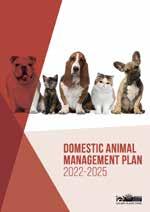
In accordance with the Domestic Animals Act 1994, Council is required to prepare a Domestic Animal Management Plan every
four years and evaluate its implementation in the Annual Report.
Council adopted the current Domestic Animal Management Plan in December 2021, in line with State Government requirements. The plan was developed through consultation with Council’s Animal Management Team and surveys with the community which received 327 responses.
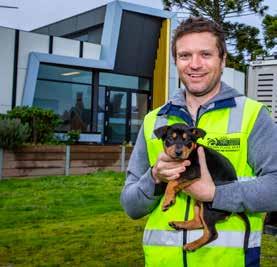
During the review and creation of the Domestic Animal Management Plan 2022-2025, the following trends were identified:
• Resource limitations are impacting service delivery and innovation.
• Registration has declined since the start of the pandemic.
• Dog attacks on people, pets and livestock continue to impact the community.
• Dog attacks reporting is low compared to the survey results.
• A majority of respondents want a cat curfew.
Some of the actions completed in the 6 months of the Domestic Animal Management Plan 20222025 have been:
• Council approval for a fee reduction on registration for owners of cats who have a suitable cat enclosure on their property.
• Recruitment and appointment of a Team Leader Animals and Amenity.
• New signage alerting residents of dog and cat registration inspections.
• Inclusion of the definition of ‘effective control’ in the Local Law.
Actions to be investigated in the 2022/23 financial year include:
• Investigation of a cat curfew.
• Investigation on the feasibility of a dog park and an appropriate location.
• Implementation of an in school program, with schools and students engaging with the Community Safety Team about responsible pet ownership.
Council officers will continue with targeted township registration checks, domestic animal business audits, investigation of prevention to cruelty of animal matters, prosecution of serious dog attack matters, maintenance and audit of the declared dog register, and discounted desexing of cats for eligible community members.
During 2021/22, the total number of animals impounded by Council officers or delivered to animal shelters by residents was 143 animals, while only 35 were reclaimed.
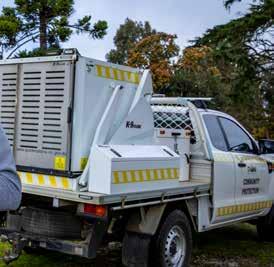
Council is also running a cat desexing program with the National Desexing Network where cat owners are offered desexing and microchipping at a heavily discounted rate that includes free registration for one year, at local veterinary clinics for eligible residents.
FOOD ACT MINISTERIAL DIRECTIONS
In accordance with section 7E of the Food Act 1984, Council is required to publish a summary of any Ministerial Directions received during the financial year in its Annual Report. No such Ministerial Directions were received by Council during 2021/22.
Freedom of information
In accordance with section 7(4AA) (a) and 7(4AA)(b) of the Freedom of Information Act 1982, Council is required to publish certain statements in its annual report or separately such as on its website, concerning its functions and information available. Council has chosen to publish the statements separately however provides
the following summary of the application and operation of the Freedom of Information Act 1982.
Access to documents may be obtained through written request to the Freedom of Information Officer, as detailed in section 17 of the Freedom of Information Act 1982 and in summary as follows:
• it should be in writing
• it should identify as clearly as possible which document is being requested
• it should be accompanied by the appropriate application fee (the fee may be waived in certain circumstances).
Requests for documents in the possession of Council should be addressed to the Freedom of Information Officer. Requests can also be lodged online or by email.
Access charges may also apply once documents have been processed and a decision on access is made (e.g. photocopying and search and retrieval charges).
Further information regarding FOI can be found on the Office of the Victorian Information Commissioner website at www.ovic.vic.gov.au
Public Interest DISCLOSURE PROCEDURES
The Public Interest Disclosures Act 2012 aims to ensure openness and accountability in government by encouraging people to disclose improper conduct within the public sector and provide protection for people who make disclosures.
In accordance with Section 69 of the Public Interest Disclosures Act 2012, Council must include in its Annual Report information about
how to access the procedures established by Council under Part 9 of that Act. Procedures on how to make a disclosure are publicly available on Council’s website: goldenplains.vic.gov.au
Council is also required to provide certain information about the number and types of protected disclosure complaints investigated during the financial year. During 2021/22, no disclosures were notified to Council officers appointed to receive disclosures, or to the Independent Broadbased Anti-Corruption Commission (IBAC).
ROAD MANAGEMENT ACT
MINISTERIAL DIRECTION
In accordance with section 22 of the Road Management Act 2004, Council must publish a copy or summary of any Ministerial direction in its Annual Report. No such Ministerial Directions were received by Council during 2021/22.
NATIONAL COMPETITION POLICY
For the year ended 30 June 2022, Golden Plains Shire Council has adhered to, and is obligated to adhere to, competitive neutrality principles.
INFRASTRUCTURE AND DEVELOPMENT CONTRIBUTIONS
Council pursue development contributions by way of s173 Agreements at the time of land rezoning. Council are currently working on a development contributions plan for the Shire, which is yet to be completed. Therefore, Council does not have any formal Infrastructure Contributions Plans (ICP’s) or Development Contributions Plans (DCP’s).
FINANCIAL REPORT

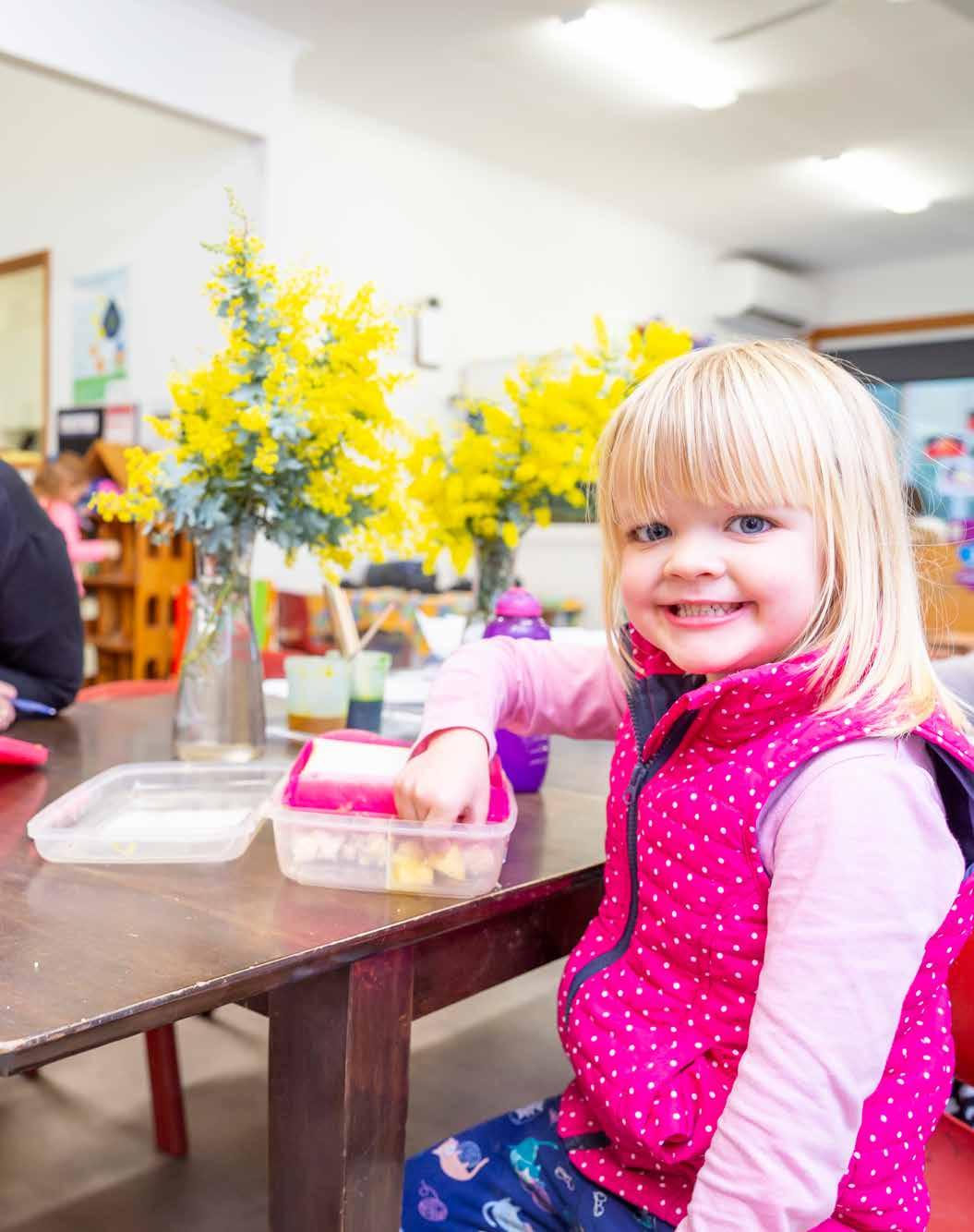
FInancial report Table of Contents
Notes
Note
Note 5 Our financial position 158
Financial assets 158 5.2. Non-financial assets 160 5.3. Payables 160 5.4. Interest-bearing liabilities 161 5.5. Provisions 161 5.6. Financing arrangements 163 5.7. Commitments 164
Note 6 Assets we manage 165 6.1. Non current assets classified as held for sale 165 6.2. Property,infrastructure plant and equipment 166 6.3. Investments in associates, joint arrangements and subsidiaries 173
Note 7 People and relationships 174
and key management remuneration 174
175
Note 8
uncertainties 176
176 8.2.
assets
in accounting
177 8.3. Financial instruments 177 8.4. Fair value measurement 179
Note 9 Other matters 180
Reserves 180 9.2. Reconciliation of cash flows from operating activities
surplus/(deficit) 182
Superannuation 183
10
in Accounting
11 Correction of
185
186
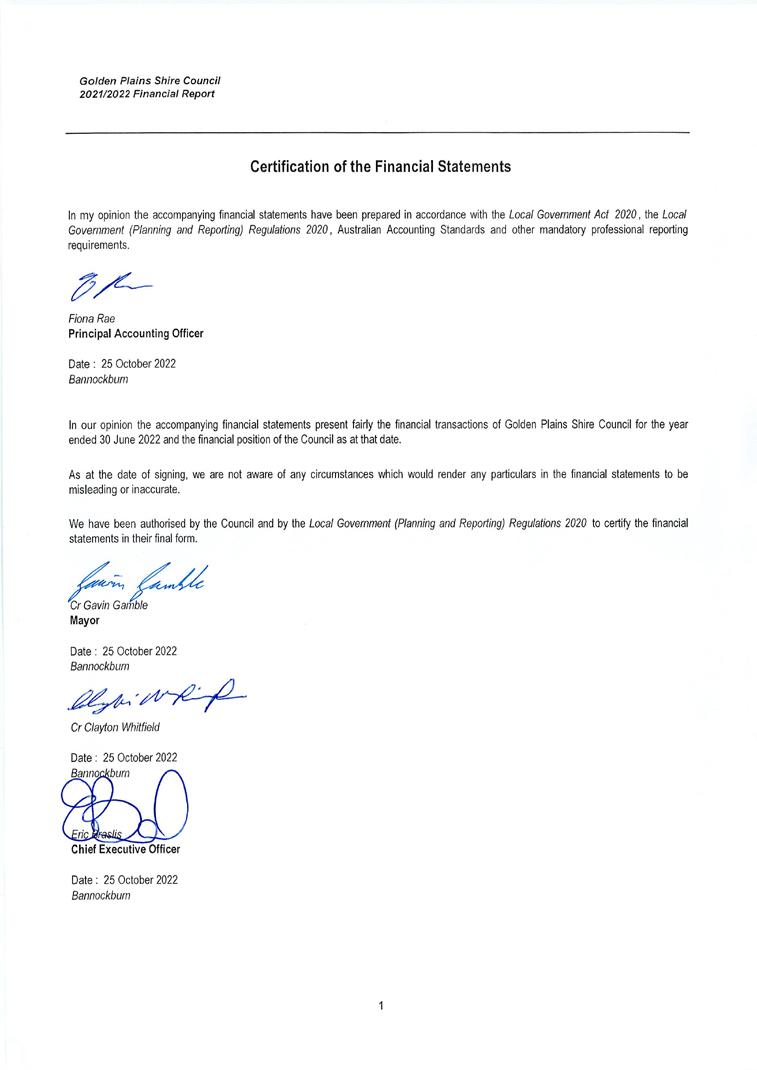
Independent Auditor’s Report
To the Councillors of Golden Plains Shire Council
Opinion I have audited the financial report of Golden Plains Shire Council (the council) which comprises the:

• balance sheet as at 30 June 2022
• comprehensive income statement for the year then ended
• statement of changes in equity for the year then ended
• statement of cash flows for the year then ended
• statement of capital works for the year then ended
• notes to the financial statements, including significant accounting policies
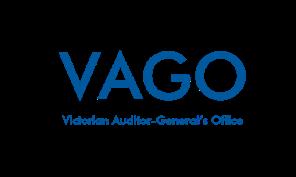
• certification of the financial statements
In my opinion the financial report presents fairly, in all material respects, the financial position of the council as at 30 June 2022 and their financial performance and cash flows for the year then ended in accordance with the financial reporting requirements of Part 4 of the Local Government Act 2020, the Local Government (Planning and Reporting) Regulations 2020 and applicable Australian Accounting Standards
Basis for Opinion I have conducted my audit in accordance with the Audit Act 1994 which incorporates the Australian Auditing Standards. I further describe my responsibilities under that Act and those standards in the Auditor’s Responsibilities for the Audit of the Financial Report section of my report.
My independence is established by the Constitution Act 1975. My staff and I are independent of the council in accordance with the ethical requirements of the Accounting Professional and Ethical Standards Board’s APES 110 Code of Ethics for Professional Accountants (the Code) that are relevant to my audit of the financial report in Victoria. My staff and I have also fulfilled our other ethical responsibilities in accordance with the Code
I believe that the audit evidence I have obtained is sufficient and appropriate to provide a basis for my opinion.
Councillors' responsibilities for the financial report
The Councillors of the council are responsible for the preparation and fair presentation of the financial report in accordance with Australian Accounting Standards, the Local Government Act 2020 and the Local Government (Planning and Reporting) Regulations 2020, and for such internal control as the Councillors determine is necessary to enable the preparation and fair presentation of a financial report that is free from material misstatement, whether due to fraud or error.
In preparing the financial report, the Councillors are responsible for assessing the council’s ability to continue as a going concern, disclosing, as applicable, matters related to going concern and using the going concern basis of accounting unless it is inappropriate to do so
Auditor’s responsibilities for the audit of the financial report
As required by the Audit Act 1994, my responsibility is to express an opinion on the financial report based on the audit. My objectives for the audit are to obtain reasonable assurance about whether the financial report as a whole is free from material misstatement, whether due to fraud or error, and to issue an auditor’s report that includes my opinion. Reasonable assurance is a high level of assurance, but is not a guarantee that an audit conducted in accordance with the Australian Auditing Standards will always detect a material misstatement when it exists. Misstatements can arise from fraud or error a nd are considered material if, individually or in the aggregate, they could reasonably be expected to influence the economic decisions of users taken on the basis of this financial report.
As part of an audit in accordance with the Australian Auditing Standards, I exercise professional judgement and maintain professional scepticism throughout the audit. I also:

• identify and assess the risks of material misstatement of the financial report, whether due to fraud or error, design and perform audit procedures responsive to those risks, and obtain audit evidence that is sufficient and appropriate to provide a basis for my opinion. The risk of not detecting a material misstatement resulting from fraud is higher than for one resulting from error, as fraud may inv olve collusion, forgery, intentional omissions, misrepresentations, or the override of internal control.
• obtain an understanding of internal control relevant to the audit in order to design audit procedures that are appropriate in the circumstances, but n ot for the purpose of expressing an opinion on the effectiveness of the council’s internal control
• evaluate the appropriateness of accounting policies used and the reasonableness of accounting estimates and related disclosures made by the Councillors
• conclude on the appropriateness of the Councillors’ use of the going concern basis of accounting and, based on the audit evidence obtained, whether a material uncertainty exists related to events or conditions that may cast significant doubt on the council’s ability to continue as a going concern. If I conclude that a material uncertainty exists, I am required to draw attention in my auditor’s report to the related disclosures in the financial report or, if such disclosures are inadequate, to modify my opinion. My conclusions are based on the audit evidence obtained up to the date of my auditor’s report. However, future events or conditions may cause the council to cease to continue as a going concern.
• evaluate the overall presentation, structure and content of the financial report, including the disclosures, and whether the financial report represents the underlying transactions and events in a manner that achieves fair presentation.
I communicate with the Councillors regarding, among other matters, the planned scope and timing of the audit and significant audit findings, including any significant deficiencies in internal control that I identify during my audit.
Rates
Statutory
User
Grants
Contributions
Contributions
Netgain(orloss)ondisposalofproperty,infrastructure,plant
Other
Total
Employee
Restated* Note 2022
3.1 26,082 24,706
3.2 824 847
3.3 1,889 2,091
3.4 14,973 12,698
3.4 4,457 8,774
3.5 1,6101,780
3.5 2,4935,193
3.6 162 114
3.7 58 88
52,547
4.1 18,394 18,434
4.2 18,075 14,875
4.3 8,699 8,795
As
Balance Sheet
2022
Restated*
Note 2022 2021 $'000 $'000 Assets
Current assets
Cash and cash equivalents
5.1 26,257 24,935
Trade and other receivables 5.1 3,674 2,940
Inventories 5.2 14 14
Non-current assets classified as held for sale 6.1 1,827
Other assets 5.2 1,562 208
Total current assets 33,334 28,097
Non-current assets
Investments in associates 6.3a 627 637
Property, infrastructure, plant and equipment 6.2 537,321 496,561
Total non-current assets 537,948 497,198
Total assets 571,282 525,295
Liabilities
Current liabilities
Trade and other payables
5.3 5,517 3,260
Trust funds and deposits 5.3 1,398 871
Unearned revenue 5.3 6,796 3,252
Provisions 5.5 3,014 3,115
Interest-bearing liabilities 5.4 1,629 1,643
Total current liabilities 18,355 12,141
Non-current liabilities
Provisions
5.5 2,628 2,665
Interest-bearing liabilities 5.4 9,982 11,611
Total non-current liabilities 12,609 14,276
Total liabilities 30,964 26,417
Net assets 540,318 498,878
Equity
Accumulated surplus 203,088 196,296
Reserves 9.1 337,230 302,582
Total
The
540,318 498,878
Statement of Changes in Equity
For
Year
Accumulated Revaluation Other Total Surplus Reserve Reserves 2022 $'000 $'000 $'000 $'000
Note
Balance at beginning of the financial year 498,878 196,296 290,269 12,313
Surplus/(deficit) for the year 6,029 6,029
Net asset revaluation increment/(decrement) 9.1(a) 35,411 35,411
Transfers from other reserves 9.1(b) 1,530 (1,530)
Transfers to other reserves 9.1(b) (767) 767
Balance at end of the financial year 540,318 203,088 325,680 11,550
Accumulated Revaluation Other Restated* Total Surplus Reserve Reserves 2021 $'000 $'000 $'000 $'000
Balance at beginning of the financial year 461,860 187,143 265,708 9,009
Surplus/(deficit) for the year 12,457 12,457
Net asset revaluation increment/(decrement) 9.1(a) 24,561 24,561
Transfers from other reserves 9.1(b) 43 (43) Transfers to other reserves 9.1(b) (3,347) 3,347
Balance at end of the financial year 498,878 196,296 290,269 12,313
For
Statement of Cash Flows
2022 2021 Inflows/ Inflows/ (Outflows) (Outflows)
Note $'000 $'000
Cash flows from operating activities
Rates and charges 25,801 24,632
Statutory fees and fines 824 847
User fees 1,990 2,093
Grants - operating 14,016 12,616
Grants - capital 8,816 8,774
Contributions - monetary 1,581 1,790
Interest received 63 76
Trust funds and deposits taken 527 298
Net GST refund 1,456 1,399
Employee costs (18,394) (18,687)
Materials and services (19,418) (15,209)
Net cash provided by/(used in) operating activities 17,261 18,629
Cash flows from investing activities
Payments for property, infrastructure, plant and equipment 6.2(14,391) (14,279)
Proceeds from sale of property, infrastructure, plant and equipment 349 238
Net cash provided by/(used in) investing activities (14,042) (14,041)
Cash flows from financing activities
Finance costs (255) (291)
Proceeds from borrowings 600
Repayment of borrowings (1,643) (1,376)
Net cash provided by/(used in) financing activities (1,898) (1,067)
Net increase (decrease) in cash and cash equivalents 1,321 3,522
Cash and cash equivalents at the beginning of the financial year 24,936 21,414
Cash and cash equivalents at the end of the financial year 26,257 24,936
Financing
Statement of Capital Works
For the Year Ended 30 June 2022
2022 2021 $'000 $'000
Property Land 1,387 116
Total land 1,387 116
Buildings - Specialised 2,876 244 Buildings - Non Specialised 1,040 1,916 Heritage buildings 11 0
Total buildings 3,927 2,160
Total property 5,314 2,276
Plant and equipment
Plant, machinery and equipment 678 677
Computers, Fixtures, fittings and furniture 151 896
Total plant and equipment 829 1,573
Infrastructure Roads 3,530 4,634 Bridges 1,413 2,632 Footpaths and cycleways 190 104 Drainage 196 118
Recreational, leisure and community facilities 1,788 1,895 Parks, open space and streetscapes 1,004 735
Off street car parks 127 312
Total infrastructure 8,248 10,430
Total capital works expenditure 14,391 14,279
Represented by:
New
Asset
Asset
Asset
expenditure 3,018 2,316
6,606 6,079
expenditure 1,364 5,572
expenditure 3,403 312
Total capital works expenditure 14,391 14,279
The
Notes to the Financial Report
For the Year Ended 30 June 2022
Note 1 OVERVIEW
Introduction
The Golden Plains Shire Council was established by an Order of the Governor in Council on 6 May 1994 and is a body corporate. The Council's main office is located at 2 Pope Street, Bannockburn.
Statement of compliance
These financial statements are a general purpose financial report that consists of a Comprehensive Income Statement, Balance Sheet, Statement of Changes in Equity, Statement of Cash Flows, Statement of Capital Works and Notes accompanying these financial statements. The general purpose financial report complies with the Australian Accounting Standards (AAS), other authoritative pronouncements of the Australian Accounting Standards Board, the Local Government Act 2020, and the Local Government (Planning and Reporting) Regulations 2020.
The Council is a not-for-profit entity and therefore applies the additional AUS paragraphs applicable to a not-for-profit entity under the Australian Accounting Standards.
Significant accounting policies
(a) Basis of accounting
The accrual basis of accounting has been used in the preparation of these financial statements, except for the cash flow information, whereby assets, liabilities, equity, income and expenses are recognised in the reporting period to which they relate, regardless of when cash is received or paid.
The financial statements are based on the historical cost convention unless a different measurement basis is specifically disclosed in the notes to the financial statements.
Judgements, estimates and assumptions are required to be made about the carrying values of assets and liabilities that are not readily apparent from other sources. The estimates and associated judgements are based on professional judgement derived from historical experience and various other factors that are believed to be reasonable under the circumstances. Actual results may differ from these estimates.
The financial statements have been prepared on a going concern basis. The financial statements are in Australian dollars. The amounts presented in the financial statements have been rounded to the nearest thousand dollars unless otherwise specified. Minor discrepancies in tables between totals and the sum of components are due to rounding.
Revisions to accounting estimates are recognised in the period in which the estimate is revised and also in future periods that are affected by the revision. Judgements and assumptions made by management in the application of AAS's that have significant effects on the financial statements and estimates relate to:
- the fair value of land, buildings, infrastructure, plant and equipment (refer to Note 6.2)
- the determination of depreciation for buildings, infrastructure, plant and equipment (refer to Note 6.2)
- the determination of employee provisions (refer to Note 5.5)
- the determination of landfill provisions (refer to Note 5.5)
- the determination of whether performance obligations are sufficiently specific so as to determine whether an arrangement is within the scope of AASB 15 Revenue from Contracts with Customers or AASB 1058 Income of Not-forProfit Entities (refer to Note 3)
- other areas requiring judgements
Unless otherwise stated, all accounting policies are consistent with those applied in the prior year. Where appropriate, comparative figures have been amended to accord with current presentation, and disclosure has been made of any material changes to comparatives.
(b) Impact of Covid-19
During 2021-22 the COVID-19 pandemic continued to impact on Council’s operations. Council has noted the following impacts on its financial operations:
• Additional revenue – $100,000 funding received for COVID-19 Immediate Outdoor Activation for Council to assist local businesses establish outdoor dining areas.
• Revenue reductions – In response to government directives amidst the COVID-19 outbreak libraries and community centres were closed which resulted in a decrease in usage of these facilities however there was only a minimal impact on revenue.
• Revenue foregone – Council developed a COVID-19 hardship policy in response to this crisis on 9 April 2020 which provided rebates to customers who met the criteria with a total of $30,500 in rebates to customers. This has also seen an increase in the rates debtor balance as at 30 June 2022 by $281,000 compared to last year.
• Additional costs –COVID-19 Immediate Outdoor Activation costs which utilised grant funds for Council to assist local businesses establish outdoor dining areas and costs for the community activation and social isolation initiative. Grant funds were utilised for Council to assist business implement COVIDSafe initiatives. Council provided COVID-19 support with $16,667 of expenditure to establish a community mental health program. Compliance with government directives has resulted in additional expenditure of $17,323 on protective equipment.
Note 2.1 Performance against budget
Notes to the Financial Report
For the Year Ended 30 June 2022
The performance against budget notes compare Council’s financial plan, expressed through its annual budget, with actual performance. The Local Government (Planning and Reporting) Regulations 2020 requires explanation of any material variances. Council has adopted a materiality threshold of $20,000 and 10 percent where further explanation is warranted. Explanations have not been provided for variations below the materiality threshold unless the variance is considered to be material because of its nature.
The budget figures detailed below are those adopted by Council on 29 June 2021. The Budget was based on assumptions that were relevant at the time of adoption of the Budget. Council sets guidelines and parameters for income and expense targets in this budget in order to meet Council’s planning and financial performance targets for both the short and long-term. The budget did not reflect any changes to equity resulting from asset revaluations, as their impacts were not considered predictable.
These notes are prepared to meet the requirements of the Local Government Act 2020 and the Local Government (Planning and Reporting) Regulations 2020
2.1.1 Income and expenditure
Income
Budget Actual Variance Variance 2022 2022 2022 2022 $'000 $'000 $'000 % Ref
Rates and charges 25,668 26,082 413 2%
Statutory fees and fines 740 824 85 11%1
User fees 2,154 1,889 (265) -12%2
Grants - operating 11,961 14,973 3,012 25%3
Grants - capital 8,350 4,457 (3,893) -47%4
Contributions - monetary 2,775 1,610 (1,165) -42%5
Contributions - non monetary 1,125 2,493 1,368 122%6
Net gain/(loss) on disposal of property, infrastructure, plant and equipment 2,001 162 (1,839) 100%7
Other income 72 58 (14) -20% 8
Total income 54,846 52,547 (2,299)
Expenses
Employee costs 17,952 18,394 (442) -2%9
Materials and services 19,398 18,075 1,323 7%10
Bad and doubtful debts 132 11 120 92%11
Depreciation and amortisation 9,239 8,699 540 6%
Borrowing costs 271 255 16 6%
Share of net profits/(losses) of associates and joint ventures 0 10 10 100%12
Other expenses 293 1,073 (781) -267%13 Total expenses 47,284 46,518 786
Surplus/(deficit) for the year 7,562 6,029 (1,513)
Notes to the Financial Report
the Year
Town planning permit fees and lodgement fees $80k higher than budget due to increase in the number of property planning and rezoning activities.
Variance in budgeted due to lower enrolments in Childcare and Children's Programs and discontinuation of childcare services $115k as well as lower number of animal registration fees $55k.
Higher than budgeted due to General purpose grant payment in advance increased to 75% from 50% $2.1m, Shire wide settlement strategy $310k, Three trails project $300k, COVID Safe Grant - Immediate Outdoor Activation $100k, Teesdale Flood Study $81k, Business Concierge & Hospitality Support $60k and Shuttle Bus Trial $60k grants approved after 2021-22 original budget was formulated. Working for Victoria grant $107k received in 2021-22, originally expected in 2020-21.
Lower than budgeted due to income for Local roads and infrastructurephase 3 grant $2.6m and Female friendly facilities Leighdale equestrian upgrade grant $358k to be recognised in 2022-23 due to performance obligations, Black spot program funding $648k lower than expected, Federal bridge renewal program grant $700k was not successful and Local roads and infrastructure - phase 2 grant $488k carried forward to 2022-23, offset by carried forward 2020-21 Slate Quarry Road - Bridge Renewal grant $690k received in 2021-22. Lower than budgeted due to Bannockburn Industrial Estate contribution not received with change in funding arrangements, offset against reduction in material and services expenditure $1.1m.
Notes to the
Higher than budgeted due to increase in subdivisions handed to council $1.4m.
Delay in titles being issued for Lomandra Drive Land Sales (Bakers Lane Stage 4 land development for re-sale) $2m, offset by Net gain on sale of plant & Equipment $161k.
Reduced income due to low interest rates on term deposits $11k
Higher than budgeted due to redundancy costs for Active Ageing & Inclusion team $439k
Lower than budgeted expenditure due to lower material and contract cost for Bannockburn Industrial Estate project $1.1m offset against reduction in Bannockburn Industrial Estate contribution not received with change in funding arrangements, cost of Bannockburn Industrial Estate $481k, Rezoning and Development of Surplus Land $185k, Rural Drainage Maintenance $146k and Roadside Slashing Maintenance $130k carried forward to 2022-23 due to delay in projects, Carers payments under spent by $169k, offset by more work required to be taken for Sealed Road Routine Maintenance & Major Patching $280k and cost of Software purchase $810k originally budgeted under capital cost.
Lower than budget expenditure due to COVID Mental Health Initiatives funded from Materials and Services budget $70k and provision for bad debts raised in 2020-21 no longer required as issue resolved in 2021-22 $45k.
Share of net deficit from Geelong Regional Library Corporation $10k.
Derecognition of assets no longer held by the Council $717k.
Notes to the Financial Report
For the Year Ended 30 June 2022
Note 2 Performance against budget (cont'd)
2.1.2
works
Budget Actual Variance Variance 2022 2022 2022 2022 $'000 $'000 $'000 % Ref
Property Land 1,387 1,387 100% 1
Total Land 1,387 1,387
Buildings - specialised 160 2,876 2,716 1698% 2 Buildings - unspecialised 175 1,040 865 494% 3 Heritage buildings - 11 11 100%
Total Buildings 335 3,927 3,592
Total Property 335 5,314 4,979
Plant and Equipment
Plant, machinery and equipment 2,243 678 (1,565) -70% 4
Computers and telecommunications 542 151 (391) -72% 5
Total Plant and Equipment 2,785 829 (1,956)
Infrastructure Roads 8,876 3,530 (5,346) -60% 6 Bridges 1,782 1,413 (369) -21% 7 Footpaths and cycleways 600 190 (410) -68% 8 Drainage 355 196 (159) -45% 9
Recreational, leisure and community facilities 2,218 1,788 (430) -19% 10 Parks, open space and streetscapes 925 1,004 79 8% 11 Off street car parks 100 127 27 27% 12 Other infrastructure 205 0 (205) -100% 13 Total Infrastructure 15,061 8,248 (6,813)
Total Capital Works Expenditure 18,181 14,391 (3,790)
Represented by:
New
Asset
Asset
Asset
Total
2,510 3,018 508
10,030 6,606 (3,424)
1,364 1,364
5,641 3,403 (2,238)
18,181 14,391 (3,790)
Variance
Ref
Actuals $1.3m relates to Bakers Lane Stage 4 land development for re-sale (Lomandra Drive) project cost carried forward budget from 2020-21.
Higher than budgeted expenditure due to $2.7m carried forward budget from 2020-21 for Inverleigh Sporting Complex Clubroom Upgrade and Bannockburn Soccer Club Female Friendly Changerooms.
Higher than budgeted expenditure due to Golden Plains Community & Civic Centre and Bannockburn Youth Hub cost $897k carried forward from 2020-21.
Cars and Utes Purchases delayed due to COVID19 $365k , replacement cost of $1,090k for Tipper Truck & Trailer, Truck Trailer, Crane Truck and Roller carried forward to 2022-23 due to delivery delays.
Lower than budgeted expenditure due to software purchase cost $486k recorded under operating cost to comply with Accounting Standard: offset by $95k additional IT equipment's cost for Golden Plains Community & Civic Centre.
Lower than budgeted expenditure due to LRCI Phase 3 project $2.7m budgeted under roads but actuals split
multiple projects, actual fund received for Blackspot program lower than budget by $629k, cost of Paddys
Rd bridge replacement, Rokewood junction $636k and Bridge Guard Replacements $200k originally budgeted under Roads but actual expenditure under Bridges, cost of Local Roads Improvements $908k and Bunninyong-Mt Mercer Rd, Hardies Hill Rd, Garibaldi intersection upgrades $228k carried forward to 2022-23 due
delays in project completion.
Lower than budgeted expenditure due to Bridge replacement program cost $1.4m carried forward to 2022-23 due to delays in program commencement, offset by carried forward cost of Bridge Rehabilitation $519k and Paddys Gully Rd bridge replacement and Rokewood junction cost $565k originally budgeted under 'Roads' but actuals expenditure recorded under 'Bridges' .
Lower than budgeted expenditure due to delays in commencing projects. Budgeted cost of Kerb & Channel $250k and Footpaths $170k carried forward into 2022-23.
Ongoing projects, budget carried forward into 2022-23, Storm Water Drainage Improvements $51k, Future Drainage Design $41k.
Lower than budgeted expenditure. Cost of Leighdale Equestrian Centre $570k and Linton Oval Drainage Upgrade $321k carried forward to 2022-23 due to delay in project completion, offset by Bannockburn Bowls Upgrade $256k and Bannockburn Skatepark Upgrade $244k carried forward budget from 2020-21.
Parks, open space and streetscapes
Higher than budgeted expenditure due to Open Space Strategy Implementation $38k and Streetscape Design Work $37k unspent 2020-21 fund carried forward to 2021-22.
Off street car parks
Higher than budgeted expenditure due to original budget $100k for Off street car parks budged under Other infrastructure.
Other infrastructure
Car Parks
Notes to the Financial Report
For the Year Ended 30 June 2022
Analysis of Council results by
Council delivers its functions and activities through the following programs.
2.2.1 Citizen & Customer Service
The key objective is to foster a culture across the organisation which addressed the needs of the community through communication and the provision of excellent customer service.
Civic Leadership
Civic leadership’s objective is to enhance Council’s decision making capacity by strengthening the governance and advocacy of Council. Good governance and leadership is supported by planning, delivering and improving high quality, cost effective, accessible and responsible services.
The strategic objective of economic development is to facilitate the growth of the local economy particularly in township development and rural based industries.
A key objective is to encourage and facilitate sustainable land use and development and protect and enhance the natural environment. Central to environment and land use is the assessment of development, health and local laws, planning strategy and urban growth.
Economic Development Development and regulatory service Financial Management
To ensure the efficient and effective allocation of resources through sound financial planning and management that secures the long-term financial viability of the municipality. This objective is achieved by providing proactive support services across Council which include finance services, digital information and technology, property and procurement, strategy and program delivery.
Human Support Services Recreation & Community Development
To provide a range of sustainable human support services that maintain and enhance the wellbeing and quality of life of Golden Plains Shire residents.
To facilitate the provision of a range of recreation facilities across the Shire and assist the community committees to best service their communities and to continue to enhance townships through Town Place Plans. To identify and respond to community needs and provide opportunities to enable needs and provide opportunities to enable people in the community to be supported and involved.
Assets Services
To maintain and enhance the road and bridge network at a level that adequately satisfied transportation needs and provide community infrastructure including drainage, street lighting, bus shelters and paths and trails, including the management of Council’s assets.
Community Places and Environment
Continue to provide the current satisfactory garbage bin and recycling bin collection disposal service. Construction and maintenance of recreation infrastructure and provision of township and tree maintenance while ensuring environment sustainability is achieved.
Notes to the Financial Report
For the Year Ended 30 June 2022
Note 3 Funding for the delivery of our services 2022 2021 3.1 Rates and charges $'000 $'000
Council uses Capital Improved Valuation (CIV) as the basis of valuation of all properties within the municipal district. The CIV of a property is its total market value including land and improvements.
The valuation base used to calculate general rates for 2021/22 was $7,264 million (2020/21 $6,027 million).
General Rates 18,785 18,066 Municipal charge 3,482 3,354
Waste management charge 3,589 3,081
Supplementary rates and rate adjustments 2 101
Interest on rates and charges 225 104
Total rates and charges 26,082 24,706
The date of the latest general revaluation of land for rating purposes within the municipal district was 1 January 2021, and the valuation will be first applied in the rating year commencing 1 July 2021
Annual rates and charges are recognised as revenues when Council issues annual rates notices. Supplementary rates are recognised when a valuation and reassessment is completed and a supplementary rates notice issued.
3.2 Statutory fees and fines
Planing and building fees 121 658
Infringements and costs 58 53
Property information fees 37 34
Town planning fees 511
Land information certificates 32 29
Drainage information fees 56 56
Pool Registration and Permit Information 9 17
Total statutory fees and fines 824 847
Statutory fees and fines (including parking fees and fines) are recognised as revenue when the service has been provided, the payment is received, or when the penalty has been applied, whichever first occurs.
3.3 User fees
Childcare/Children's Programs 6 371
Home and Community Care Fees 109 110
Animal Registration Charges 368 388
Early Childhood Education 102 57 Subdivision Supervision Fees 303 231
Gravel Cartage Levy 128 174
Septic Tank Fees 225 248
Food Premises Registration Fees 67 78
Fire Hazard Eradication Fees and Fines 43 12
Bannockburn Family Services Centre Charges 16 6
Bannockburn Cultural Centre Charges 44 14
Smythesdale Business Hub Centre Charges 22 32
Farmers Market Fees 23 16 Lease of Land 37 55
Lease of Building 206 131 Town Planning 112 89 Other 80 79
Total user fees 1,889 2,091
User fees are recognised as revenue when the service has been provided or council has otherwise earned the income.
Notes to the Financial Report
For the Year Ended 30 June 2022 20222021
Funding from other levels of government Grants were received in respect of the following :
Summary of grants
Commonwealth funded grants 13,319 13,606 State funded grants 6,112 7,866 Total grants received 19,430 21,472
(a) Operating Grants
Recurrent - Commonwealth Government Financial Assistance Grants - General 6,204 3,966
Financial Assistance Grants - Local Roads 2,258 2,112 Children's Services 106 646 General home care 1,007 985
Recurrent - State Government Kindergarten 873 1,379 Community Health 528 488 Home Care 198 195 Maternal and Child Health 542 444 Emergency Management 146 191 Youth projects 77 74 Other 163 257 Environment Projects 85 83 Total recurrent operating grants 12,187 10,820
Non-recurrent - Commonwealth Government Kindergarten 3 199 Other 1 9
Non-recurrent - State Government Economic Development 2,577 1,313 Environment Projects 86 Other 15 Emergency Management 81 200 Community Health 23 7 Recreational Leisure & Community 150 Total non-recurrent operating grants 2,786 1,878 Total operating grants 14,973 12,698
Notes to the Financial Report
For the Year Ended 30 June 2022
2022 2021 $'000$'000
(b) Capital Grants
Recurrent - Commonwealth Government Roads to recovery 1,457 1,921
Total recurrent capital grants 1,457 1,921
Non-recurrent - Commonwealth Government Roads 1,466 2,336 Bridges 818 600 Recreational Leisure & Community 832
Non-recurrent - State Government Recreational Leisure & Community 717 2,697 Youth projects 271 Bridges 17 Other 100
Total non-recurrent capital grants 3,000 6,853
Total capital grants 4,4578,774
(c) Unspent grants received on condition that they be spent in a specific manner
Operating Balance at start of year 580 707
Received during the financial year and remained unspent at balance date 1,698 580
Received in prior years and spent during the financial year (307) (707) Balance at year end 1,971 580
Capital Balance at start of year 2,711 85
Received during the financial year and remained unspent at balance date 6,416 2,711
Received in prior years and spent during the financial year (2,711) (85) Balance at year end 6,416 2,711
(d) Recognition of grant income
Before recognising funding from government grants as revenue the Council assesses whether there is a contract that is enforceable and has sufficiently specific performance obligations in accordance with AASB 15 Revenue from Contracts with Customers . When both these conditions are satisfied, the Council:
- identifies each performance obligation relating to revenue under the contract/agreement
- determines the transaction price
- recognises a contract liability for its obligations under the agreement
- recognises revenue as it satisfies its performance obligations, at the time or over time when services are rendered. Where the contract is not enforceable and/or does not have sufficiently specific performance obligations, the Council applies AASB 1058 Income for Not-for-Profit Entities
Grant revenue with sufficiently specific performance obligations is recognised over time as the performance obligations specified in the underlying agreement are met. Where performance obligations are not sufficiently specific, grants are recognised on the earlier of receipt or when an unconditional right to receipt has been established. Grants relating to capital projects are generally recognised progressively as the capital project is completed. The following table provides a summary of the accounting framework under which grants are recognised.
Notes to the Financial Report
For the Year Ended 30 June 2022
2022 2021 $'000 $'000
Income recognised under AASB 1058 Income of Not-for-Profit Entities
General purpose 8,461 6,078
Specific purpose grants to acquire non-financial assets 4,457 8,774 Other specific purpose grants 6,361 6,195 Revenue recognised under AASB 15 Revenue from Contracts with Customers
Specific purpose grants 151 425 19,430 21,472
3.5 Contributions
Monetary 1,610 1,780 Non-monetary * 2021 Restated 2,493 5,193
Total contributions 4,103 6,973
Contributions of non monetary assets
relation to the following asset classes.
Land 24 12 Infrastructure 2,469 5,181 Total non-monetary contributions 2,493 5,193
Monetary and non monetary contributions
recognised
revenue when Council obtains control over the contributed asset.
Proceeds of
down value
(188) (124)
The
Notes to the Financial Report
For the Year Ended 30 June 2022 2022 2021 $'000 $'000
3.7 Other income
Interest on Investment 59 66 Present value discount for gravel pit provision 16 Present value discount for landfill provision Other (1) 6 Total other income 58 88
Interest is recognised as it is earned. Other income is measured at the fair value of the consideration received or receivable and is recognised when Council gains control over the right to receive the income.
Note 4 The cost of delivering services
4.1 Employee costs
Wages and salaries 16,391 16,604 WorkCover 365 252
Superannuation 1,524 1,436
Fringe benefits tax 111 134 Other 3 8
Total employee costs 18,394 18,434
(b) Superannuation
Council made contributions to the following funds:
Defined benefit fund
Employer contributions to Local Authorities Superannuation Fund (Vision Super) 154 189 Employer contributions - other funds 154 189
Employer contributions payable at reporting date. Nil Nil
Accumulation funds
Employer contributions to Local Authorities Superannuation Fund (Vision Super) 747 770 Employer contributions - other funds 927 570 1,674 1,340
Employer contributions payable at reporting date. 130 177
Refer to note 9.3 for further information relating to Council's superannuation obligations.
4.2
Delivery
General
Garbage
Contractors
Vehicle and Machinery
Notes to the
Report
2022 2021 $'000 $'000
2,283 2,198
3,330 3,895
2,959 2,572
3,134 1,170
944 730
Building maintenance 835 698
Information technology 1,635 716
Utilities 286 318 Printing, Stationery and Postage 238 261
Telecommunication 275 366
Debt Collection and
200 249
Cleaning 330 364
Insurance 446 414
Training 419 162 Advertising 164 155
Election Expenses 2 169 Gravel Pit Operation 4 17 Other Expenses 591 421
Total
Expenses
4.3
18,075 14,875
Infrastructure 6,376 6,708
730 805 Buildings 1,254 1,046
340 236
8,699 8,795
Refer
Community
(59)
Movement
(21)
Provision
Note
costs
Notes to the Financial Report
For the Year Ended
June
2022 2021 $'000
Interest - Borrowings 255 290
Total borrowing costs 255 290
Borrowing costs are recognised as an expense in the period in which they are incurred, except where they are capitalised as part of a qualifying asset constructed by Council.
expenses
Auditors' remuneration - VAGO - audit of the financial statements, performance statement and grant acquitals 70 45
Internal Auditors' remuneration 26 23
Councillors' allowances 260 198
De-recognition of Non-current Assets 717 868
Total other expenses 1,0731,134
financial position
Financial assets
(a) Cash and cash equivalents
Cash on hand 2 2
Cash at bank 1,637 2,343
Short Term Deposit 17,113 18,090 At call deposits 7,506 4,500
Total cash and cash equivalents 26,25724,935
Councils cash and cash equivalents are subject to external restrictions that limit amounts available for discretionary use. These include:
- Other Reserves (Note 9.1(b)) 619 559
- Trust funds and deposits (Note 5.3 (b)) 1,398 871
Total restricted funds 2,0171,430
Total unrestricted cash and cash equivalents 24,241 23,505
Intended
Although not externally restricted the following amounts have been allocated for specific future purposes by Council:
- Cash held to fund carried forward capital works 5,890 8,804
- Unspent grant funding - operational 1,698 580
- Long Service Leave Investment Account 1,635 1,390
Total funds subject to intended allocations 9,223 10,774
Cash and cash equivalents include cash on hand, deposits at call, and other highly liquid investments with original maturities of 90 days or less, net of outstanding bank overdrafts.
Other financial assets are valued at fair value, at balance date. Term deposits are measured at original cost. Any unrealised gains and losses on holdings at balance date are recognised as either a revenue or expense.
Other financial assets include term deposits and those with original maturity dates of three to 12 months are classified as current, whilst term deposits with maturity dates greater than 12 months are classified as non-current.
Notes to the Financial Report
For the Year Ended 30 June 2022
2022 2021
(b) Trade and other receivables $'000 $'000
Current Statutory receivables
Rates debtors 2,499 2,218
Infringement debtors 303 252
Provision for doubtful debts - infringements (243) (206) Net GST receivable 3 Other Statutory receivable 249 491 Other debtors 896 271 Provision for doubtful debts - other debtors (31) (89) Total current trade and other receivables 3,6742,940
Short term receivables are carried at invoice amount. A provision for doubtful debts is recognised when there is objective evidence that an impairment has occurred. Long term receivables are carried at amortised cost using the effective interest rate method.
(i) Ageing of Receivables
The ageing of the Council's trade & other receivables (excluding statutory receivables) that are not impaired was:
Current (not yet due) 634 64
Past due by up to 30 days 26 14
Past due between 31 and 180 days 182 55
Past due between 181 and 365 days 1 2 Past due by more than 1 year 22 47 Total trade & other receivables 865 182
(ii) Ageing of individually impaired Receivables
At balance date, other debtors representing financial assets with a nominal value of $ 23,453 (2021: $23,453) were impaired. The amount of the provision raised against these debtors was $ 23,453 (2021: $23,453). They individually have been impaired as a result of their doubtful collection. Many of the long outstanding past due amounts have been lodged with Council's debt collectors or are on payment arrangements.
The ageing of receivables that have been individually determined as impaired at reporting date was:
Past due by more than 1 year 23 23 Total trade & other receivables 23 23
Notes to the Financial Report
For the Year Ended 30 June 2022
5.2 Non-financial assets 2022 2021
(a) Inventories $'000 $'000
Inventories held for distribution 14 14 Total inventories 1414
Inventories held for distribution are measured at cost, adjusted when applicable for any loss of service potential. All other inventories, including land held for sale, are measured at the lower of cost and net realisable value. Where inventories are acquired for no cost or nominal consideration, they are measured at current replacement cost at the date of acquisition.
(b) Other assets
Prepayments 729196 Accrued income 833 12
Total other assets 1,562208
5.3 Payables, trust funds and deposits and unearned income/revenue
(a) Trade and other payables
Current Non-statutory payables
Trade payables 3,7792,194 Accrued expenses 1,7381,066
Total trade and other payables 5,5173,260
(b) Trust funds and deposits current
Current
Refundable deposits 1,398871
Total trust funds and deposits 1,398871
(c) Unearned income/revenue
Current
Grants received in advance - operating 381151
Grants received in advance - capital 6,4163,101
Total unearned income 6,7963,252
Amounts received as deposits and retention amounts controlled by Council are recognised as trust funds until they are returned, transferred in accordance with the purpose of the receipt, or forfeited. Trust funds that are forfeited, resulting in council gaining control of the funds, are to be recognised as revenue at the time of forfeit.
Purpose and nature of items
Refundable deposits - Deposits are taken by council as a form of surety in a number of circumstances, including in relation to building works, tender deposits, contract deposits and the use of civic facilities.
Fire Service Levy - Council is the collection agent for fire services levy on behalf of the State Government. Council remits amounts received on a quarterly basis. Amounts disclosed here will be remitted to the state government in line with that process.
Retention Amounts - Council has a contractual right to retain certain amounts until a contractor has met certain requirements or a related warrant or defect period has elapsed. Subject to the satisfactory completion of the contractual obligations, or the elapsing of time, these amounts will be paid to the relevant contractor in line with Council's contractual obligations.
5.4 Interest-bearing liabilities
Notes to the Financial Report
For the Year Ended 30 June 2022
20222021
Current $'000$'000 Bank Borrowings - secured 1,629 1,643 1,629 1,643
Non-current Bank Borrowings - secured 9,982 11,611 9,982 11,611
Total 11,611 13,254
Borrowings are secured by Council rates and charges 11,61113,254
(a) The maturity profile for Council's borrowings is:
Not later than one year 1,629 1,643
Later than one year and not later than five years 6,072 6,372
Later than five years 3,910 5,239 11,611 13,254
Borrowings are initially measured at fair value, being the cost of the interest bearing liabilities, net of transaction costs. The measurement basis subsequent to initial recognition depends on whether the Council has categorised its interest-bearing liabilities as either financial liabilities designated at fair value through the profit and loss, or financial liabilities at amortised cost. Any difference between the initial recognised amount and the redemption value is recognised in net result over the period of the borrowing using the effective interest method. The classification depends on the nature and purpose of the interest bearing liabilities. The Council determines the classification of its interest bearing liabilities at initial recognition.
5.5 Provisions
Employee Landfill restoration Gravel Pit restoration Total
2022 $ '000 $ '000 $ '000 $ '000
Balance at beginning of the financial year
3,4011,5837965,780
Additional provisions 938- 24962
Amounts used (1,102)- (1,102)
Change in the discounted amount arising because of time and the effect of any change in the discount rate
Balance at the end of the financial year
2021
Balance at beginning of the financial year
3,2371,5838205,640
3,6011,5837905,974
Additional provisions 861- 22883
Amounts used (1,061)- (1,061)
Change in the discounted amount arising because of time and the effect of any change in the discount rate (16)(16)
Balance at the end of the financial year
3,4011,5837965,780
Notes to the Financial Report
For the Year Ended 30 June 2022 20222021
(a) Employee provisions $'000 $'000
Current provisions expected to be wholly settled within 12 months
Rostered days off 10176
Annual leave 1,035936
Long service leave 220 228 1,356 1,240
Current provisions expected to be wholly settled after 12 months
Annual leave 248 181 Long service leave 1,344 1,634 1,591 1,815
Total current employee provisions 2,947 3,055
Non-current Long service leave 291 346
Total non-current employee provisions 291 346
Aggregate carrying amount of employee provisions:
Current 2,947 3,055 Non-current 291 346 3,2393,401
Total aggregate carrying amount of employee provisions
The calculation of employee costs and benefits includes all relevant on-costs and are calculated as follows at reporting date.
Wages and salaries and annual leave
A liability for annual leave is recognised in the provision for employee benefits as a current liability because the Council does not have an unconditional right to defer settlement of the liability. Liabilities for annual leave are measured at: - nominal value if the Council expects to wholly settle the liability within 12 months - present value if the Council does not expect to wholly settle within 12 months.
Liabilities that are not expected to be wholly settled within 12 months of the reporting date are recognised in the provision for employee benefits as current liabilities, measured at the present value of the amounts expected to be paid when the liabilities are settled using the remuneration rate expected to apply at the time of settlement.
Long service leave
Liability for long service leave (LSL) is recognised in the provision for employee benefits. Unconditional LSL is disclosed as a current liability as the Council does not have an unconditional right to defer settlement. Unconditional LSL is measured at nominal value if expected to be settled within 12 months or at present value if not expected to be settled within 12 months. Conditional LSL that has been accrued, where an employee is yet to reach a qualifying term of employment, is disclosed as a non-current liability and measured at present value.
Key assumptions: 2022 2021 - discount rate 3.7% 1.5% - inflation rate 3.9% 3.0% 2022 2021
(b) Landfill restoration $'000$'000
Current Non-current 1,583 1,583 1,583 1,583
Council is obligated to restore closed Rokewood and Teesdale sites to a particular standard. The provision for landfill restoration has been calculated based on the present value of the expected cost of works to be undertaken. The expected cost of works has been estimated based on current understanding of work required to reinstate the site to a suitable standard. Accordingly, the estimation of the provision required is dependent on the accuracy of the forecast timing of the work, work required and related costs.
Notes to the Financial Report
For the Year Ended 30 June 2022 20222021
(c) Gravel Pit restoration $'000 $'000
Current 67 60 Non-current 753 736 820 796
Total current provisions 3,014 3,115
Total non-current provisions 2,628 2,665 Total provisions 5,642 5,780
Council operate Sagohill gravel pit to supply gravel for it’s roads and maintenance projects. The gravel pit has a further 28 years of expected life. Provision has been made to rehabilitate the excavated area at the end of the expected life of the quarry. The expected cost of works has been estimated to reinstate the site to a suitable standard, with the estimated rehabilitation costs to be reviewed annually. The provision has been calculated based on the present value of the expected cost of works to be undertaken.
5.6 Financing arrangements 2022 2021 $'000 $'000
The Council has the following funding arrangements in place as at 30 June 2022.
Credit card facilities 150 150
Total facilities 150 150
Used facilities (31) (24) Unused facilities 119 126
The above financing arrangements exclude loan facilities which have been fully drawn down.
Notes to the Financial Report
For the Year Ended 30 June 2022
5.7 Commitments
The Council has entered into the following commitments. Commitments are not recognised in the Balance Sheet. Commitments are disclosed at their nominal value and presented inclusive of the GST payable.
2022
Not later than 1 year
Later than 1 year and not later than 2 years
Later than 2 years and not later than 5 years Later than 5 yearsTotal $'000 $'000 $'000 $'000 $'000 Operating Waste Management 2,493 2,486 7,458 4,972 17,410 Cleaning contracts for council buildings 251 251 Suppliers 1,104 1,104
Total 3,848 2,486 7,458 4,972 18,765
Capital Buildings 77 77 Roads 854 854 Computer Software 512 512 Recreational, leisure and Community 371 371 Plant & Machinery 550 550 Total 2,365 - - - 2,365 2021
Not later than 1 year
Later than 1 year and not later than 2 years
Later than 2 years and not later than 5 years Later than 5 yearsTotal $'000 $'000 $'000 $'000 $'000 Operating Waste Management 1,360 453 1,813 Suppliers 431 34 465 Total 1,791 487 2,278
Capital Buildings 62 62 Roads 1,336 1,336 Computer Software 799 799 Recreational, leisure and Community 2,831 2,831 Plant & Machinery 169 169 Total 5,198 5,198
Notes to the Financial Report
For the Year Ended 30 June 2022
Note 6 Assets we manage 20222021 6.1Non current assets classified as held for sale $'000$'000
Cost of acquisition 324
Capitalised development costs (eg roads, drainage) 1,502 Borrowing costs capitalised during development Total non current assets classified as held for sale 1,827
Capitalisation rate used in the allocation of borrowing costs
Non-current assets classified as held for sale (including disposal groups) are measured at the lower of its carrying amount and fair value less costs of disposal, and are not subject to depreciation. Non-current assets, disposal groups and related liabilities and assets are treated as current and classified as held for sale if their carrying amount will be recovered through a sale transaction rather than through continuing use. This condition is regarded as met only when the sale is highly probable and the asset's sale (or disposal group sale) is expected to be completed within 12 months from the date of classification.
Notes to the Financial Report For the Year Ended 30 June 2022
plant and
$'000
In
$'000
11,490
$'000
$'000
At fair value 1 July 2021
(5,869) 4,3221,299-
(4,074)(1,795)-
at 1 July 2021
5,621
Movements
829
-
151
678
(297)
-
(1,069)
(235)
(84)
(892)
(1,127) (214)
(340)
(730)
of
Movements in
and
(215)
706149
(191)
854 (24)
11,193
8,1823,010-
(6,084)
5,108
-
(4,098)(1,986)-
1,024
4,084
At fair value 30 June 2022
depreciation at 30 June 2022
amount
(6,376)
(5,780)
(61)
(133,898)
(80)
1,002
(478)
(582)
(643)
(353)
(97,276)(19,936)(6,415)(3,446)(4,868)(766)(989)(201)
Notes to the Financial Report For the Year Ended 30 June 2022
Acquisition
The purchase method of accounting is used for all acquisitions of assets, being the fair value of assets provided as consideration at the date of acquisition plus any incidental costs attributable to the acquisition. Fair value is the price that would be received to sell an asset (or paid to transfer a liability) in an orderly transaction between market participants at the measurement date.
Where assets are constructed by Council, cost includes all materials used in construction, direct labour, borrowing costs incurred during construction, and an appropriate share of directly attributable variable and fixed overheads. In accordance with Council's policy, the threshold limits have applied when recognising assets within an applicable asset class and unless otherwise stated are consistent with the prior year.
Asset recognition thresholds and depreciation periods
Threshold Limit Depreciation Period $'000
Property Buildings heritage buildings 30 to 150 years 5 buildings 30 to 150 years 5 building improvements 30 to 150 years 5
Plant and Equipment heritage plant and equipment 3 to 20 years 1 plant, machinery and equipment 3 to 20 years 1 fixtures, fittings and furniture 3 to 20 years 1 computers and telecommunications 3 to 10 years 1 Infrastructure sealed pavements 90 years 5 unsealed pavements 25 years 5 sealed surfaces 19 years 5 road kerb, channel and minor culverts 90 years 5 bridges deck 90 years 5 bridges substructure 90 years 5 footpaths and cycleways 85 years 5 drainage 50 years 5 recreational, leisure and community facilities 30 to 60 years 5 parks, open space and streetscapes 40 years 5 off street car parks 50 years 5 Land under roads Council recognises land under roads it controls at fair value. Depreciation and amortisation
Buildings, land improvements, plant and equipment, infrastructure, and other assets having limited useful lives are systematically depreciated over their useful lives to the Council in a manner which reflects consumption of the service potential embodied in those assets. Estimates of remaining useful lives and residual values are made on a regular basis with major asset classes reassessed annually. Depreciation rates and methods are reviewed annually.
Where assets have separate identifiable components that are subject to regular replacement, these components are assigned distinct useful lives and residual values and a separate depreciation rate is determined for each component.
Road earthworks are not depreciated on the basis that they are assessed as not having a limited useful life. Straight line depreciation is charged based on the residual useful life as determined each year. Depreciation periods used are listed below and are consistent with the prior year unless otherwise stated.
Notes to the Financial Report
For the Year Ended 30 June 2022
Where the repair relates to the replacement of a component of an asset and the cost exceeds the capitalisation threshold the cost is capitalised and depreciated. The carrying value of the replaced asset is expensed.
Repairs and maintenance Valuation of land and buildings
Valuation of land and buildings were undertaken by a qualified independent valuer Mr Liam McNamara AAPI CPV registration no 63119. The valuation of land and buildings is at fair value, being market value based on highest and best use permitted by relevant land planning provisions. Where land use is restricted through existing planning provisions the valuation is reduced to reflect this limitation. This adjustment is an unobservable input in the valuation. The adjustment has no impact on the comprehensive income statement.
Specialised land is valued at fair value using site values adjusted for englobo (undeveloped and/or unserviced) characteristics, access rights and private interests of other parties and entitlements of infrastructure assets and services. This adjustment is an unobservable input in the valuation. The adjustment has no impact on the comprehensive income statement.
Any significant movements in the unobservable inputs for land and land under roads will have a significant impact on the fair value of these assets.
The date of the current valuation is detailed in the following table. An indexed based revaluation was conducted in the current year, this valuation was based on recent sales throughout the Golden Plains Shire Council from the 1 July 2021 to the 30 June 2022 to determine the material change in the underlying land value, a full revaluation of these assets will be conducted in 2023-24.
Details of the Council’s land and buildings and information about the fair value hierarchy as at 30 June 2022 are as follows:
Level 1 Level2 Level 3 Date of Valuation
Land - - 47,655 Jun-21 Specialised land - - 6,973 Jun-21
Heritage Buildings - - 1,119 Jun-21
Specialised Buildings - - 32,499 Jun-21 Non - Specialised Buildings - - 10,290 Jun-21
Total - - 98,536
Notes to the Financial Report
For the Year Ended 30 June 2022
Valuation of infrastructure
Valuation of Roads, Bridges, Footpaths and Drainage assets have been determined in accordance with valuations undertaken by Council staff and expert contractors. At balance date Council reviewed the carrying value of the individual classes of assets measured at fair value to ensure that each asset materially approximated its fair value. Where the carrying value materially differed from the fair value at balance date, the class of asset was revalued.
Council performed a desktop revaluation of Roads, Footpaths, and Drainage as at 30 June 2022, and Council noticed fair value has a material increment. Further revaluation adjustment was made accordingly.
Valuation of Recreational leisure and community, Park open space and streetscapes and Offstreet carpark infrastructure assets have been undertaken by Mr Liam McNamara AAPI CPV registered Certified Practising Valuer as a part of land and buildings valuation as at 30 June 2021.
The date of the current valuation is detailed in the following table.
The valuation is at fair value based on current replacement cost less accumulated depreciation as at the date of valuation. Details of the Council’s infrastructure and information about the fair value hierarchy as at 30 June 2022 are as follows:
Level 1Level2Level 3Date of Valuation
Roads - - 362,499 Jun-22
Bridges - - 33,628 Jun-21
Footpaths and cycleways - - 13,224 Jun-22
Drainage - - 6,233 Jun-22
Recereational, leisure and community facilities - - 11,410 Jun-21
Parks, open space and streetscapes - - 1,411 Jun-21
Off street car parks - - 1,532 Jun-21
Gravel Pit - - 242 Jun-21
Total - - 430,178
Description of significant unobservable inputs into level 3 valuations
Specialised land and land under roads is valued using a market based direct comparison technique. Significant unobservable inputs include the extent and impact of restriction of use and the market cost of land per square metre. The extent and impact of restrictions on use varies and results in a reduction to surrounding land values between 5% and 95%. The market value of land varies significantly depending on the location of the land and the current market conditions. Currently land values range between $0.02and $2,415.09 per square metre.
Specialised buildings are valued using a depreciated current replacement cost technique. Significant unobservable inputs include the current replacement cost and remaining useful lives of buildings. Current replacement costs are calculated on a square metre basis and ranges from $42.33 to $8,817.86 per square metre. The remaining useful lives of buildings are determined on the basis of the current condition of buildings and vary from 30 years to 150 years. Replacement cost is sensitive to changes in market conditions, with any increase or decrease in cost flowing through to the valuation. Useful lives of buildings are sensitive to changes in expectations or requirements that could either shorten or extend the useful lives of buildings.
Infrastructure assets are valued based on the current replacement cost. Significant unobservable inputs include the current replacement cost and remaining useful lives of infrastructure. The remaining useful lives of infrastructure assets are determined on the basis of the current condition of the asset and vary from 19 years to 90 years. Replacement cost is sensitive to changes in market conditions, with any increase or decrease in cost flowing through to the valuation. Useful lives of infrastructure are sensitive to changes in use, expectations or requirements that could either shorten or extend the useful lives of infrastructure assets.
Notes to the Financial Report
For the Year Ended 30 June 2022
6.3 Investments in associates, joint arrangements and subsidiaries
(a) Investments in associates
Investments in associates accounted for by the equity method are: - Equity in Geelong Regional Library (GRL) 627 637
Geelong Regional Library (GRL)
Background Council share of the net equity in GRL is 6.07% (6.11% 2021). The GRL Board is comprisedofsevenrepresentativesfromfourmemberCouncils.GoldenPlains Shire Council has one representative on the GRL Board.
Fair value of Council's investment in Geelong Regional Library 627 637
Council's share of accumulated surplus/(deficit) Council's share of accumulated surplus(deficit) at start of year 637 791 Reported surplus(deficit) for year (10) (154) Council's share of accumulated surplus(deficit) at end of year 627 637 Council's share of expenditure commitments Operating commitments 426 406 Council's share of expenditure commitments 426 406
Associates are all entities over which Council has significant influence but not control or joint control. Investments in associates are accounted for using the equity method of accounting, after initially being recognised at cost.
Investments in joint arrangements are classified as either joint operations or joint ventures depending on the contractual rights and obligations each investor has, rather than the legal structure of the joint arrangement.
For joint operations, Council recognises its direct right to, and its share of jointly held assets, liabilities, revenues and expenses of joint operations.
Interests in joint ventures are accounted for using the equity method. Under this method, the interests are initially recognised in the consolidated balance sheet at cost and adjusted thereafter to recognise Council’s share of the post-acquisition profits or losses and movements in other comprehensive income in profit or loss and other comprehensive income respectively.
(c ) Community Asset Committee
All entities controlled by Council that have material revenues, expenses, assets or liabilities, such as community asset committees, have been included in this financial report. Any transactions between these entities and Council have been eliminated in full.
Notes
For
the Financial Report
Helena Kirby (1/07/21 - 30/06/22)
Les Rowe (1/07/21 - 30/06/22)
Owen Sharkey (1/07/21 - 30/06/22)
(01/07/21-16/11/21) Deputy Mayor (16/11/21-30/06/22)
Ian Getsom (1/07/21 - 30/06/22) Deputy Mayor (01/07/21-16/11/21)
Brett Cunningham (1/07/21 - 30/06/22)
Gavin Gamble (1/07/21 - 30/06/22) Mayor (16/11/21-30/06/22)
Clayton Whitfield (1/07/21 - 30/06/22)
Eric Braslis,
- (1/07/21 - 30/06/22)
Philippa O'Sullivan, Director Corporate Services - (1/7/21 - 26/01/22)
Simon Rennie, Director Corporate Services - (28/02/22 - 30/06/22)
Phil Josipovic,
Development - (1/07/21 - 30/06/22)
Lisa Letic, Director Community Services - (1/07/21 - 27/08/21)
Steven Sagona,
Community Services - (16/08/21 - 30/06/22)
of
Notes to the Financial Report
the Year Ended
management personnel
any related entities, fall within the following
$9,999
- $19,999
- $29,999
- $39,999
- $59,999
- $69,999
- $119,999
- $149,999
- $209,999
- $219,999
- $289,999
- $309,999
(d) Senior Officer Remuneration
total remuneration
Council
Officer is an officer of Council,other than Key Management Personnel,
management responsibilities and reports directly to the Chief Executive;
total annual remuneration exceeds $151,000
Officers are shown below in their
Range:
- $159,999
- $169,999
TotalRemunerationforthereportingyearforSeniorOfficersincludedabove,
to:
Related party disclosure
Transactions with related parties
During the
Council entered into the following transactions with related parties.
Outstanding balances with related parties
at the end of the reporting period in relation
transactions with related parties.
(c) Loans to/from related parties
The
amount of loans in existence at balance date that have been made,
secured by the council to a
(d) Commitments to/from related parties
are
follows:
amount of commitments in existence at balance date that have been made, guaranteed or secured by the council to a related party are as follows:
The
Notes to the Financial Report
For the Year Ended 30 June
uncertainties
Contingent assets and contingent liabilities are not recognised in the Balance Sheet, but are disclosed and if quantifiable, are measured at nominal value. Contingent assets and liabilities are presented inclusive of GST receivable or payable, respectively.
assets
Contingent assets are possible assets that arise from past events, whose existence will be confirmed only by the occurrence or non-occurrence of one or more uncertain future events not wholly within the control of the Council.
Contingent liabilities
Contingent liabilities are:
- possible obligations that arise from past events, whose existence will be confirmed only by the occurrence or non-occurrence of one or more uncertain future events not wholly within the control of the Council; or
- present obligations that arise from past events but are not recognised because:
- it is not probable that an outflow of resources embodying economic benefits will be required to settle the obligation; or
- the amount of the obligation cannot be measured with sufficient reliability.
Bank Guarantee – Minister for Energy & Resources
Council has issued a Bank Guarantee for the amount of $9,000 in favour of the Minister for Energy & Resources for rehabilitation of the De Motts/Jollys Gravel Pit. Council does not believe that the bank guarantee will be exercised.
Bank Guarantee – Department of Sustainability & Environment
Council has issued a Bank Guarantee for the amount of $37,500 in favour of the Department of Natural Resources & Environment for rehabilitation of the Sago Hill Gravel Pit. Council does not believe that the bank guarantee will be exercised.
Council has issued a Bank Guarantee for the amount of $17,000 in favour of the Department of Natural Resources & Environment for rehabilitation of the Black Hill Gravel Pit. Council does not believe that the bank guarantee will be exercised.
Superannuation
Council has obligations under a defined benefit superannuation scheme that may result in the need to make additional contributions to the scheme, matters relating to this potential obligation are outlined below. As a result of the volatility in financial markets the likelihood of making such contributions in future periods exists.
Liability Mutual Insurance
Council is (was) a participant of the MAV Liability Mutual Insurance (LMI) Scheme. The LMI scheme provides public liability and professional indemnity insurance cover. The LMI scheme states that each participant will remain liable to make further contributions to the scheme in respect of any insurance year in which it was a participant to the extent of its participant’s share of any shortfall in the provision set aside in respect of that insurance year, and such liability will continue whether or not the participant remains a participant in future insurance years.
MAV Workcare
Council was a participant of the MAV WorkCare Scheme. The MAV WorkCare Scheme provided workers compensation insurance. MAV WorkCare commenced business on 1 November 2017 and the last day the Scheme operated as a self-insurer was 30 June 2021. In accordance with the Workplace Injury Rehabilitation and Compensation Act 2013 , there is a six year liability period following the cessation of the Scheme (to 30 June 2027). During the liability period, adjustment payments may be required (or received). The determination of any adjustment payments is dependent upon revised actuarial assessments of the Scheme's tail claims liabilities as undertaken by Work Safe Victoria. If required, adjustments will occur at the 3-year and 6-year points during the liability period, and will affect participating members.
8.2
Change in accounting standards
Notes to the Financial Report
For the Year Ended 30 June 2022
8.3 Financial instruments
(a) Objectives and policies
The Council's principal financial instruments comprise cash assets, term deposits, receivables (excluding statutory receivables), payables (excluding statutory payables) and bank borrowings. Details of the significant accounting policies and methods adopted, including the criteria for recognition, the basis of measurement and the basis on which income and expenses are recognised, in respect of each class of financial asset, financial liability and equity instrument is disclosed in the Notes of the financial statements. Risk management is carried out by senior management under policies approved by the Council. These policies include identification and analysis of the risk exposure to Council and appropriate procedures, controls and risk minimisation.
(b) Market risk Interest rate risk
Market risk is the risk that the fair value or future cash flows of council financial instruments will fluctuate because of changes in market prices. The Council's exposure to market risk is primarily through interest rate risk with only insignificant exposure to other price risks and no exposure to foreign currency risk.
Interest rate risk refers to the risk that the value of a financial instrument or cash flows associated with the instrument will fluctuate due to changes in market interest rates. Council's interest rate liability risk arises primarily from long term loans and borrowings at fixed rates which exposes council to fair value interest rate risk. Cash flow interest rate risk is the risk that the future cash flows of a financial instrument will fluctuate because of changes in market interest rates. Council has minimal exposure to cash flow interest rate risk through its cash and deposits that are at floating rates.
Investment of surplus funds is made with approved financial institutions under the Local Government Act 2020 . Council manages interest rate risk by adopting an investment policy that ensures:
- diversification of investment product; - monitoring of return on investment; and - benchmarking of returns and comparison with budget.
Certain new Australian Accounting Standards and interpretations have been published that are not mandatory for the 30 June 2022 reporting period. Council assesses the impact of these new standards. As at 30 June 2022 there were no new accounting standards or interpretations issued by the AASB which are applicable for the year ending 30 June 2023 that are expected to impact Council. There has been no significant change in the Council's exposure, or its objectives, policies and processes for managing interest rate risk or the methods used to measure this risk from the previous reporting period.
Interest rate movements have not been sufficiently significant during the year to have an impact on the Council's year end result.
For the Year Ended 30 June 2022 Notes to the Financial Report
(c) Credit risk
Credit risk is the risk that a contracting entity will not complete its obligations under a financial instrument and cause Council to make a financial loss. Council have exposure to credit risk on some financial assets included in the balance sheet. Particularly significant areas of credit risk exist in relation to outstanding fees and fines as well as loans and receivables from sporting clubs and associations. To help manage this risk:
- council have a policy for establishing credit limits for the entities Council deal with; - council may require collateral where appropriate; and
- council only invest surplus funds with financial institutions which have a recognised credit rating specified in council's investment policy.
Receivables consist of a large number of customers, spread across the ratepayer, business and government sectors. Credit risk associated with the council's financial assets is minimal because the main debtor is secured by a charge over the rateable property.
There are no material financial assets which are individually determined to be impaired.
Council may also be subject to credit risk for transactions which are not included in the balance sheet, such as when Council provide a guarantee for another party. Details of our contingent liabilities are disclosed in Note 8.1(b).
The maximum exposure to credit risk at the reporting date to recognised financial assets is the carrying amount, net of any provisions for impairment of those assets, as disclosed in the balance sheet and notes to the financial statements. Council does not hold any collateral.
(d) Liquidity risk
Liquidity risk includes the risk that, as a result of council's operational liquidity requirements it will not have sufficient funds to settle a transaction when required or will be forced to sell a financial asset at below value or may be unable to settle or recover a financial asset.
To help reduce these risks Council:
- have a liquidity policy which targets a minimum and average level of cash and cash equivalents to be maintained;
- have readily accessible standby facilities and other funding arrangements in place;
- have a liquidity portfolio structure that requires surplus funds to be invested within various bands of liquid instruments; - monitor budget to actual performance on a regular basis; and
- set limits on borrowings relating to the percentage of loans to rate revenue and percentage of loan principal repayments to rate revenue.
The Council's maximum exposure to liquidity risk is the carrying amounts of financial liabilities as disclosed on the face of the balance sheet and the amounts related to financial guarantees disclosed in Note 8.1(c), and is deemed insignificant based on prior periods' data and current assessment of risk.
There has been no significant change in Council's exposure, or its objectives, policies and processes for managing liquidity risk or the methods used to measure this risk from the previous reporting period.
With the exception of borrowings, all financial liabilities are expected to be settled within normal terms of trade. Details of the maturity profile for borrowings are disclosed at Note 5.4.
Unless otherwise stated, the carrying amounts of financial instruments reflect their fair value.
(e) Sensitivity disclosure analysis
Taking into account past performance, future expectations, economic forecasts, and management's knowledge and experience of the financial markets, Council believes the following movements are 'reasonably possible' over the next 12 months:
- A parallel shift of + 0.5% and -0.5% in market interest rates (AUD) from year-end rates of 0.85%.
These movements will not have a material impact on the valuation of Council's financial assets and liabilities, nor will they have a material impact on the results of Council's operations.
Notes to the Financial Report
For the Year Ended 30 June 2022
Fair value measurement
Fair value hierarchy
Council's financial assets and liabilities are not valued in accordance with the fair value hierarchy Council's financial assets and liabilities are measured at amortised cost.
Council measures certain assets and liabilities at fair value where required or permitted by Australian Accounting Standards. AASB 13 Fair value measurement, aims to improve consistency and reduce complexity by providing a definition of fair value and a single source of fair value measurement and disclosure requirements for use across Australian Accounting Standards.
All assets and liabilities for which fair value is measured or disclosed in the financial statements are categorised within a fair value hierarchy, described as follows, based on the lowest level input that is significant to the fair value measurement as a whole:
Level 1 — Quoted (unadjusted) market prices in active markets for identical assets or liabilities
Level 2 — Valuation techniques for which the lowest level input that is significant to the fair value measurement is directly or indirectly observable; and
Level 3 — Valuation techniques for which the lowest level input that is significant to the fair value measurement is unobservable.
For the purpose of fair value disclosures, Council has determined classes of assets and liabilities on the basis of the nature, characteristics and risks of the asset or liability and the level of the fair value hierarchy as explained above.
In addition, Council determines whether transfers have occurred between levels in the hierarchy by re-assessing categorisation (based on the lowest level input that is significant to the fair value measurement as a whole) at the end of each reporting period.
Revaluation
Subsequent to the initial recognition of assets, non-current physical assets, other than plant and equipment, are measured at their fair value, being the price that would be received to sell an asset (or paid to transfer a liability) in an orderly transaction between market participants at the measurement date. At balance date, the Council reviewed the carrying value of the individual classes of assets measured at fair value to ensure that each asset materially approximated its fair value. Where the carrying value materially differed from the fair value at balance date, the class of asset was revalued.
Fair value valuations are determined in accordance with a valuation hierarchy. Changes to the valuation hierarchy will only occur if an external change in the restrictions or limitations of use of an asset result in changes to the permissible or practical highest and best use of the asset. In addition, Council undertakes a formal revaluation of land, buildings, and infrastructure assets on a regular basis ranging from 4 to 5 years. The valuation is performed either by experienced council officers or independent experts.
Where the assets are revalued, the revaluation increments are credited directly to the asset revaluation reserve except to the extent that an increment reverses a prior year decrement for that class of asset that had been recognised as an expense in which case the increment is recognised as revenue up to the amount of the expense. Revaluation decrements are recognised as an expense except where prior increments are included in the asset revaluation reserve for that class of asset in which case the decrement is taken to the reserve to the extent of the remaining increments. Within the same class of assets, revaluation increments and decrements within the year are offset.
Impairment of assets
At each reporting date, the Council reviews the carrying value of its assets to determine whether there is any indication that these assets have been impaired. If such an indication exists, the recoverable amount of the asset, being the higher of the asset's fair value less costs of disposal and value in use, is compared to the assets carrying value. Any excess of the assets carrying value over its recoverable amount is expensed to the comprehensive income statement, unless the asset is carried at the revalued amount in which case, the impairment loss is recognised directly against the revaluation surplus in respect of the same class of asset to the extent that the impairment loss does not exceed the amount in the revaluation surplus for that same class of asset.
Flood events during October 2022 in the Golden Plains Shire region have resulted in damage to a number of Council's infrastructure assets. A number of sealed roads, unsealed roads, bridge and recreation areas in low lying areas will require repair. Council is assessing the damage and is unable to reliably estimate the value of any repairs or other recovery/clean-up works.
Balance
Balance at end of
2022 Property Land 21,890 11,773 33,663
Land Under Roads 1,023 1,710 2,733 Buildings 12,923 12,923 35,836 13,484 49,320 Infrastructure Roads 228,232 20,560 248,792 Bridges 20,602 20,602 Footpaths and cycleways 2,781 440 3,220 Drainage 2,644 927 3,571 Offstreet car parks 175 175 254,433 21,927 276,360
Total
290,269 35,411 325,680
Restated* 2021 Property Land 15,970 5,920 21,890 Land Under Roads 165 858 1,023 Buildings 12,412 511 12,923 28,547 7,289 35,836 Infrastructure Roads 225,964 2,268 228,232 Bridges 5,507 15,095 20,602 Footpaths and cycleways 2,881 (100) 2,781 Drainage 2,772 (128) 2,644 Offstreet car parks 37 138 175 237,161 17,272 254,433
Total asset revaluation reserves 265,708 24,561 290,269
The asset
(net) value of Council's assets over time.
(b) Other reserves
Notes to the Financial Report
For the Year Ended 30 June 2022
Balance at beginning of reporting period
Transfer to accumulated surplus Balance at end of reporting period $'000 $'000 $'000 $'000
Transfer from accumulated surplus
2022 Recreation Lands 606 411 1,017
Unexpended project reserve 9,489 (1,210) 8,279
LSL Investment Reserve 447 (156) 291
Developer Contribution reserve 559 60 619
Quarry Levy 171 - (163) 8 Waste Management 1,041 296 1,337
Total Other reserves 12,313 767 (1,530) 11,550
2021 Recreation Lands 172 434 606
Unexpended project reserve 7,103 2,386 9,489
LSL Investment Reserve 490 (43) 447
Developer Contribution reserve 432 127 559 Quarry Levy 36 135 171 Waste Management 776 265 1,041
Total Other reserves 9,009 3,347 (43) 12,313
Purposes of Other Reserve Recreation Lands
These funds relate to Public Open Space Contributions collected from property developers. The funds are utilised to develop open space (including recreation facilities) areas thoughout the Shire.
Unexpended project reserve
LSL Investment Reserve
Developer Contribution reserve
Quarry Levy
Waste Management
These funds have been received or commited in prior year/s and are held to enable Council to deliver the corresponding projects.
These funds relate to the non-current portion of Council's Long Service Leave liability.
These funds relate to Developer Contributions collected from property developers. The funds are utilised to develop new community infrastructure.
These funds are collected from Quarry operators and the funds are utilised to maintain the local road network utilised by these quarries.
These funds relate to the waste management charges collected from customers less associated waste management expenses therefore represent the surplus generated from providing waste management services. The funds are committed to future waste management expenses and are held to offset the expected increase in recycling disposal costs.
Notes to the Financial Report
the Year
Restated*
$'000 $'000
Surplus/(deficit) for the year 6,029 12,457
Depreciation/amortisation 8,699 8,795
Cost of Infrastructure assets written-off to Income Statement 717 868 (Profit)/loss on acquisition/disposal of property, infrastructure, plant and equipment (79) (114)
Contributions - Non-monetary assets (2,493) (5,193) Finance cost 276 290
Change in assets and liabilities:
(Increase)/decrease in trade and other receivables (734) (366) (Increase)/decrease in accrued income (821) (5) (Increase)/decrease in prepayments (533) (108)
Increase/(decrease) in trade payables 1,585 (1,282)
Increase/(decrease) in Unearned revenue 3,544 2,827
Increase/(decrease) in accrued expenses 672 199 (Increase)/decrease in other assets 10 154 (Increase)/decrease in inventories 0 3
Increase/(decrease) in trust funds 527 298 Increase/(decrease) in provisions (140) (194)
Net cash provided by/(used in) operating activities 17,261 18,629
Notes to the Financial Report
the Year Ended 30 June 2022
Superannuation
Council makes the majority of its employer superannuation contributions in respect of its employees to the Local Authorities Superannuation Fund Vision Super. This Fund has two categories of membership, accumulation and defined benefit, each of which is funded differently. Obligations for contributions to the Fund are recognised as an expense in the Comprehensive Income Statement when they are made or due.
Accumulation
The Fund's accumulation categories, Vision MySuper/Vision Super Saver, receive both employer and employee contributions on a progressive basis. Employer contributions are normally based on a fixed percentage of employee earnings (for the year ended 30 June 2022, this was 10.0% as required under Superannuation Guarantee (SG) legislation (2021: 9.5%)).
Defined Benefit
Council does not use defined benefit accounting for its defined benefit obligations under the Fund's Defined Benefit category. This is because the Fund's Defined Benefit category is a pooled multi-employer sponsored plan.
There is no proportional split of the defined benefit liabilities, assets or costs between the participating employers as the defined benefit obligation is a floating obligation between the participating employers and the only time that the aggregate obligation is allocated to specific employers is when a call is made. As a result, the level of participation of Golden Plains Shire Council in the Fund cannot be measured as a percentage compared with other participating employers. Therefore, the Fund Actuary is unable to allocate benefit liabilities, assets and costs between employers for the purposes of AASB 119 Employee Benefits.
Funding arrangements
Council makes employer contributions to the Defined Benefit category of the Fund at rates determined by the Trustee on the advice of the Fund Actuary.
As at 30 June 2021, an interim actuarial investigation was held as the Fund provides lifetime pensions in teh Defined Benefit category.
The vested benefit index (VBI) of the Defined Benefit category of which Council is a contributing employer was 109.8%. The financial assumptions used to calculate the VBI were:
Net investment returns 4.75% pa
Salary information 2.75% pa Price inflation (CPI) 2.25% pa.
As at 30 June 2022, an interim actuarial investigation is underway as the Fund provides lifetime pensions in the Defined Benefit category. It is expected to be completed by 31 October 2022.
Vision Super has advised that the estimated VBI at 30 June 2022 was 102.2%.. Council was notified of the 30 June 2022 VBI during August 2022 (2021: August 2021). The financial assumptions used to calculate this VBI were,
Net investment returns 5.5% pa Salary information 2.5% pa to 30 June 2023, and 3.5% pa thereafter Price inflation (CPI) 3.0% pa
The VBI is used as the primary funding indicator. Because the VBI was above 100%, the 30 June 2021 actuarial investigation determined the Defined Benefit category was in a satisfactory financial position and that no change was necessary to the Defined Benefit category’s funding arrangements from prior years.
Notes to the Financial Report
For the Year Ended 30 June 2022
Employer contributions
Regular contributions
On the basis of the results of the 2021 interim actuarial investigation conducted by the Fund Actuary, Council makes employer contributions to the Fund’s Defined Benefit category at rates determined by the Fund’s Trustee. For the year ended 30 June 2022, this rate was 10.0% of members' salaries (9.5% in 2020/2021). This rate is expected to increase in line with any increases in the SG contribution rate and was reviewed as part of the 30 June 2020 triennial valuation.
In addition, Council reimburses the Fund to cover the excess of the benefits paid as a consequence of retrenchment above the funded resignation or retirement benefit.
Funding calls
If the Defined Benefit category is in an unsatisfactory financial position at an actuarial investigation or Defined Benefit category's VBI is below its shortfall limit at any time other than the date of the actuarial investigation, the Defined Benefit category has a shortfall for the purpose of SPS 160 and Fund is required to put a plan in place so that the shortfall is fully funded within three years of the shortfall occurring. The Fund monitors its VBI on a quarterly basis and the Fund has set its shortfall limit at 97%.
In the event that the Fund Actuary determines that there is a shortfall based on the above requirement, the Fund’s participating employers (including Council) are required to make an employer contribution to cover the shortfall.
Using the agreed methodology, the shortfall amount is apportioned between the participating employers based on the pre-1 July 1993 and post-30 June 1993 service liabilities of the Fund’s Defined Benefit category, together with the employer’s payroll at 30 June 1993 and at the date the shortfall has been calculated.
Due to the nature of the contractual obligations between the participating employers and the Fund, and that the Fund includes lifetime pensioners and their reversionary beneficiaries, it is unlikely that the Fund will be wound up.
If there is a surplus in the Fund, the surplus cannot be returned to the participating employers.
In the event that a participating employer is wound-up, the defined benefit obligations of that employer will be transferred to that employer’s successor.
Notes to the Financial Report
The 2021 interim actuarial investigation surplus amounts
An actuarial investigation is conducted annually for the Defined Benefit category of which Council is a contributing employer. Generally, a full actuarial investigation is conducted every three years and interim actuarial investigations are conducted for each intervening year. An interim investigation was conducted as at 30 June 2021 and the last full investigation was conducted as at 30 June 2020.
The Fund’s actuarial investigation identified the following for the Defined Benefit category of which Council is a contributing employer:
the defined benefit obligations exceed the vested benefits that the defined benefit members
means that the market value of the fund’s assets
have been entitled to if they had all exited on 30 June 2021.
The total service liability surplus means that the current value of the assets in the Fund’s Defined Benefit category plus expected future contributions exceeds the value of expected future benefits and expenses as at 30 June 2021.
The discounted accrued benefit surplus means that the current value of the assets in the Fund’s Defined Benefit category exceeds the value of benefits payable in the future but accrued in respect of service as at 30 June 2021.
Council was notified of the 30 June 2021 VBI during August 2021 (2020: August 2020).
The 2022 interim actuarial investigation
An interim actuarial investigation is being conducted for the Fund’s position as at 30 June 2022 as the Fund provides lifetime pensions in the Defined Benefit category. It is anticipated that this actuarial investigation will be completed by October 2022.
was notified of the 30 June 2022 VBI during August 2022 (2021: August 2021).
Superannuation Contribution
Contributions by Council (excluding any unfunded liability payments) to the above superannuation plans for the financial year ended 30 June 2022 are detailed below:
Note 10 Change in accounting policy
There have been no changes to accounting policies in the 2021-22 year.
no pending accounting standards that are likely to have a material impact on council.
Note 11 Correction of Prior Period Error
Comparative figures have been restated in the Comprehensive Income Statement, Balance Sheet and Statement of Changes in Equity. These changes are a result of prior period errors in accordance with AASB 108 Accounting Policies, Changes in Accounting Estimates and Errors.
During 2021-22, Council identified number of infrastructure assets that have not been recognised in the financial statements. Those found assets understated the revenue and non-current assets by $ 3.4 million in 2020-21.
During 2020-21 Council revalued Roads, Footpaths and Drainage infrastructure asset classes, however an error in the allocation of accumulated depreciation has been identified. The error resulted in the overstatement of the asset revaluation reserve and written down values of the abovementioned asset classes by $4.6 million in 2020-21.
As these adjustment reflected characteristics of assets that existed in the prior period, an adjustment to the prior period balances has been made. This is classified as an error in accordance with AASB 108. The prior period adjustment are detailed below, with the Balance Sheet balances as at 30 June 2021 restated as follows.
Restated
Prior year Adjustments As previously reported 2021 2021 2021 $'000 $'000 $'000
(i) Comprehensive Income Statement
Income
Rates and charges 24,706 24,706
Statutory fees and fines 847 847
User fees 2,091 2,091
Grants - operating 12,698 12,698
Grants - capital 8,774 8,774
Contributions - monetary 1,780 1,780
Contributions - non monetary 5,193 3,393 1,800
Netgain(orloss)ondisposalofproperty, infrastructure, plant and equipment 114 114
Other income 88 88
Total income 56,291 3,393 52,898
Expenses
Employee costs 18,434 18,434
Materials and services 14,875 14,875
Depreciation and amortisation 8,795 8,795
Bad and doubtful debts 152 152
Borrowing costs 290 290 Share of net profits (or loss) of associates 154 154
Other expenses 1,134 1,134
Total expenses 43,834 0 43,834
Surplus/(deficit) for the year 12,457 3,393 9,064
Other comprehensive income Items that will not be reclassified to surplus or deficit in future periods
Net asset revaluation increment/(decrement) 24,560 (4,598) 29,158 Total other comprehensive income 24,560 (4,598) 29,158
Total comprehensive result 37,017 (1,205) 38,222
Balance Sheet
Prior year Adjustments As previously reported 2021 2021 2021 $'000 $'000 $'000 Assets
Current assets
Restated
Cash and cash equivalents 24,935 - 24,935
Trade and other receivables 2,940 2,940 Inventories 14 14
Other assets 208 208
Total current assets 28,097 28,097
Non-current assets
Investments in associates 637 637
Property, infrastructure, plant and equipment 496,561 (1,205) 497,766
Total non-current assets 497,198 (1,205) 498,403
Total assets 525,295 (1,205) 526,500
Liabilities
Current liabilities
Trade and other payables 3,260 - 3,260
Trust funds and deposits 871 871 Unearned revenue 3,252 3,252 Provisions 3,115 3,115 Interest-bearing liabilities 1,643 1,643
Total current liabilities 12,141 12,141
Non-current liabilities
Provisions 2,665 2,665
Interest-bearing liabilities 11,611 11,611
Total non-current liabilities 14,276 14,276
Total liabilities 26,417 26,417
Net assets 498,878 500,083
Equity
Accumulated surplus 196,296 3,393 192,903 Reserves 302,582 (4,598) 307,180
Total Equity 498,878 (1,205) 500,083
Note 11 Correction of Prior Period Error (Cont.)
(iii) Statement of Changes in Equity
Accumulated Revaluation Other Total Surplus Reserve Reserves $'000 $'000 $'000 $'000
Balance at beginning of the financial year 461,860 187,143 265,708 9,009
Surplus/(deficit) for the year - As previously reported 9,0649,064
Assets not previously recognised 3,3933,393
Error correction for assets re-valuation reserve (4,598) 0(4,598)
Surplus/(deficit) for the year - Restated 7,85912,457
Net asset revaluation increment/(decrement)9.1(a)29,159 29,159
Transfers from other reserves 9.1(b) 43 (43) Transfers to other reserves 9.1(b) (3,347) 3,347
Balance at end of the financial year 498,878196,296290,26912,313
(iv) Property, infrastructure, plant and equipment
Roads Bridges Footpaths and cycleways
Drainage $'000 $'000 $'000 $'000
At fair value 1 July 2021 431,07851,48518,4088,228 Assets not previously recognised 2,9962383962 434,07451,72318,8048,230
Accumulated depreciation at 1 July 2021 (88,301)(20,340)(5,779)(2,773) Assets not previously recognised (19)(119)(98)(1)
Error correction for 2020-21 depreciation (4,384) 0(184)(29) (92,705)(20,459)(6,062)(2,803)
Adjusted WDV 1 July 2021 341,36931,26412,7425,427

The Volunteers in Action photo exhibition highlighted the contributions of volunteers to Golden Plains Shire, including the Beautify Bannockburn volunteers who work together to beautify the streetscpaes of Bannockburn.
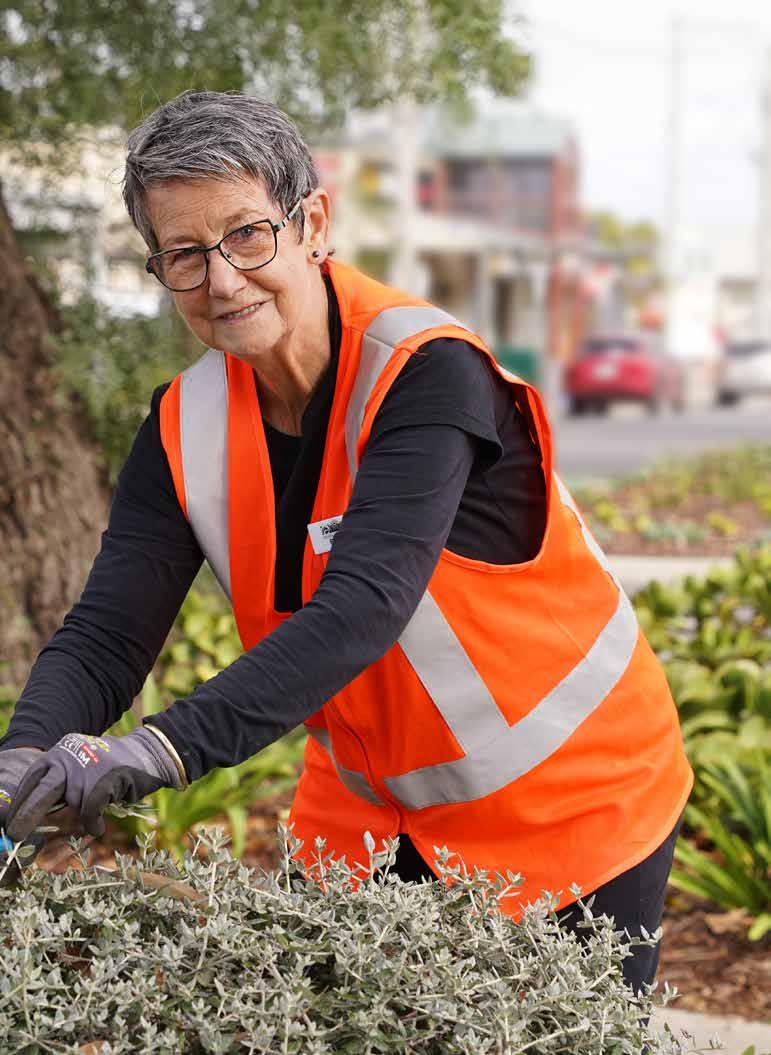

Independent Auditor’s Report
To the Councillors of Golden Plains Shire Council
Opinion I have audited the accompanying performance statement of Golden Plains Shire Council (the council) which comprises the:
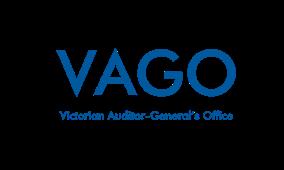
• description of municipality for the year ended 30 June 2022
• sustainable capacity indicators for the year ended 30 June 2022

• service performance indicators for the year ended 30 June 2022
• financial performance indicators for the year ended 30 June 2022
• other information and
• certification of the performance statement
In my opinion, the performance statement of Golden Plains Shire Council in respect of the year ended 30 June 2022 presents fairly, in all material respects, in accordance with the performance reporting requirements of Part 4 of the Local Government Act 2020 and Local Government (Planning and Reporting) Regulations 2020
Basis for Opinion I have conducted my audit in accordance with the Audit Act 1994 which incorporates the Australian Standards on Assurance Engagements. I further describe my responsibilities under that Act and those standards in the Auditor’s Responsibilities for the Audit of the performance statement section of my report.
My independence is established by the Constitution Act 1975 My staff and I are independent of the council in accordance with the ethical requirements of the Accounting Professional and Ethical Standards Board’s APES 110 Code of Ethics for Professional Accountants (the Code) that are relevant to my audit of the performance statement in Victoria. My staff and l have also fulfilled our other ethical responsibilities in accordance with the Code.
I believe that the audit evidence I have obtained is sufficient and appropriate to provide a basis for my opinion.
Councillors' responsibilities for the performance statement
The Councillors are responsible for the preparation and fair presentation of the performance statement in accordance with the performance reporting requirements of the Local Government Act 2020 and the Local Government (Planning and Reporting) Regulations 2020 and for such internal control as the Councillors determines is necessary to enable the preparation and fair presentation of a performance statement that is free from material misstatement, whether due to fraud or error.
Auditor’s responsibilities for the audit of the performance statement
As required by the Audit Act 1994, my responsibility is to express an opinion on the performance statement based on the audit. My objectives for the audit are to obtain reasonable assurance about whether the performance statement as a whole is free from material misstatement, whether due to fraud or error, and to issue an auditor’s report that includes my opinion. Reasonable assurance is a high level of assurance, but is not a guarantee that an audit conducted in accordance with t he Australian Standards on Assurance Engagements will always detect a material misstatement when it exists. Misstatements can arise from fraud or error and are considered material if, individually or in the aggregate, they could reasonably be expected to influence the decisions of users taken on the basis of this performance statement .
As part of an audit in accordance with the Australian Standards on Assurance Engagements, I exercise professional judgement and maintain professional scepticism throughout the audit. I also:

• identify and assess the risks of material misstatement of the performance statement, whether due to fraud or error, design and perform audit procedures responsive to those risks, and obtain audit evidence that is sufficient and appropriate to provide a basis for my opinion. The risk of not detecting a material misstatement resulting from fraud is higher than for one resulting from error, as fraud may involve collusion, forgery, intentional omissions, misrepresentations, or the override of internal control.
• obtain an understanding of internal control relevant to the audit in order to design audit procedures that are appropriate in the circumstances, but not for the purpose of expressing an opinion on the effectiveness of the council’s internal control
• evaluate the overall presentation, structure and content of the performance statement, including the disclosures, and whether performance statement represents the underlying events and results in a manner that achieves fair presentation.
I communicate with the Councillors regarding, among other matters, the planned scope and timing of the audit and significant audit findings, including any significant deficiencies in internal control that I identify during my audit.
description of municipality
In recent years, the region has experienced significant population growth as people discover the benefits of living in a semi-rural setting with plenty of space to breathe.
With 24,765 residents across 56 communities and 16 townships, Golden Plains Shire has been one of the fastest growing municipalities in Victoria, with population growth now around 2.5% per annum.
New residents, including many young families, continue to enjoy a diverse range of lifestyle choices available in the Shire’s welcoming communities.
Golden Plains Shire comprises 2,705 square kilometres between Victoria’s two largest regional cities, Geelong and Ballarat. The Shire’s close proximity to services available in neighbouring cities and convenient commuting distance to Melbourne and the Surfcoast adds to its appeal as a place to call home.
Business growth continues to create attractive investment opportunities and new jobs. While the Shire has a strong tradition of wool and grain production, intensive animal farming, particularly poultry and pigs, is increasing.
Golden Plains Shire is conveniently located close to export markets and welcomes investment and sustainable development. Strong population and economic growth render the region an attractive place to invest.
As a popular destination for family fun, food and wine connoisseurs and for those seeking adventure in the great outdoors, Golden Plains Shire also has it all for the perfect day trip experience.
This thriving municipality has become renowned across Australia, and internationally, for the produce on offer at local eateries, cellar doors and the monthly Golden Plains Farmers’ Market in Bannockburn.
The Golden Plains region has become known for its many gourmet food producers and the Moorabool Valley in the Shire’s east is home to a well established award winning wine industry. The newly created Moorabool Valley Taste Trail includes wineries, cellar doors and provedores.
Despite strong growth in the north west and south east, the Shire continues to be offer beautiful natural environments and landscapes. The natural beauty
of the region remains visible and accessible as does remnant townships and structures from the area’s rich gold mining history.
The region has a vibrant arts and culture scene including iconic music festivals which are all helping to make Golden Plains an emerging tourism destination.
Golden Plains is the place to enjoy life as it should be.
sustainable capacity indicators
Results
Service / Indicator / measure
Population
Expenses per head of municipal population [Total expenses / Municipal population] $1,655.84 $1,718.07 $1,805.19 $1,878.34
Infrastructure per head of municipal population [Value of infrastructure / Municipal population] $17,516.52 $18,029.17 $18,819.25 $19,490.89
Population density per length of road
[Municipal population / Kilometres of local roads] 13.73 14.08 13.98 14.24
Own-source revenue
Own-source revenue per head of municipal population [Own-source revenue / Municipal population] $1,171.76 $1,142.27 $1,148.34 $1,171.61
Recurrent grants
Recurrent grants per head of municipal population [Recurrent grants / Municipal population] $499.96 $499.03 $552.11 $550.94
Relative socio-economic disadvantage [Index of Relative Socioeconomic Disadvantage by decile]
Workforce Turnover
Resignations and terminations compared to average staff
of permanent staff
and terminations / Average number of permanent staff for the financial year} x
Variations
Council transitioned out of providing Long Day Care services in December 2020 with associated redundancies included in the 2021 result.
Voluntary permanent staff turnover was 18.72% including two retirements. Allowing for redundancies with the exit of Aged Care Services the 2022 figure is adjusted to
service performance indicators
Service / Indicator / measure Results
Animal management
safety
Animal management prosecutions
Food safety
and safety
major non-
notifications
of critical noncompliance notifications
major non-compliance notifications about a food premises followed up
Number of critical non-compliance notifications
major noncompliance notifications about food premises]
Governance
Variations
how Council
in making
in the
Libraries Participation
members
of
in the municipality has been
by the
Results
Service / Indicator / measure
Maternal and child health Participation
Participation in the MCH service
2022
Material Variations
[Number of children who attend the MCH service at least once (in the year) / Number of children enrolled in the MCH service] x100 82.31% 83.30% 84.58% 82.57%
Participation
Participation in the MCH service by Aboriginal children
[Number of Aboriginal children who attend the MCH service at least once (in the year) / Number of Aboriginal children enrolled in the MCH service] x100 86.96% 80.00% 86.05% 92.68%
Roads Satisfaction
Satisfaction with sealed local roads
[Community satisfaction rating out of 100 with how Council has performed on the condition of sealed local roads] 44.00 39.00 39.00 37.00
Statutory Planning Decision making Council planning decisions upheld at VCAT
[Number of VCAT decisions that did not set aside council’s decision in relation to a planning application / Number of VCAT decisions in relation to planning applications] x100 0.00% 100.00% 0.00% 100.00%
Waste Collection Waste diversion
Kerbside collection waste diverted from landfill [Weight of recyclables and green organics collected from kerbside bins / Weight of garbage, recyclables and green organics collected from kerbside bins] x100 38.13% 22.46% 36.97% 35.75%
Increase in participation by Aboriginal and Torres Strait Islander children. Low participation numbers in 2021 results in large changes in percentages between years.
2021 result incorrectly reported as 39 when it should be 42 as reflected in the Community Satisfaction Survey results. Increase in number of complaints in 2022 noting some roads are Vic Roads not Council roads.
All council planning decisions were upheld by Victorian Civil and Administrative Tribunal (VCAT) in 2022.
No recycling collection during recycling crisis from July until mid-December 2019 impacted on the 2019-20 figure. The recycling industry stabilised in 2020-21 which saw Council’s performance return to prior levels which continued into 2021-22.
Service / Indicator / measure Results
Animal management Health and safety
Animal management prosecutions
[Number of successful animal management prosecutions]
* These figures have been corrected to exclude prosecutions relating to unpaid fines. 5
Efficiency Revenue level
Average residential rate per residential property assessment
[Residential rate revenue/ number of residential property assessments] $2,014.78
Obligations
Asset Renewal
Asset renewal compared to depreciation
[Asset renewal expenses/Asset Depreciation]x100 55.67%
Retired in 2020 Retired in 2020 Retired in 2020
Material Variations
This measure was replaced by the animal management prosecutions measure from July 2019.
Retired in 2020 Retired in 2020 Retired in 2020
This measure was replaced by the average rate per property assessment from July 2019.
Retired in 2020 Retired in 2020 Retired in 2020
This measure was replaced by the asset renewal and upgrade compared to depreciation measure from July 2019.
Financial Performance Indicators
garbage charge forecast to increase due to mandated increase in State Government landfill levy resulting in corresponding increase in costs.
$3,602.58 $3,647.83 $3,876.42 $3,816.92 $3,938.00 $4,053.50 $4,178.50
Forecast includes projected increases in customers.
$1,932.25 $2096.75 $2,277.50 $2,350.08
Increase in grants recognized as unearned income in current liabilities due to accounting standard requirement when performance obligations remain.
108.33% 162.27% 183.47% 233.33%
Decrease in unrestricted cash balance and increase in grants included as unearned income in current liabilities 2022.
122.18% 140.65% 188.87%
78.30%
Budgeted $9.5m new loans taken-up in 2019-20. Reduction in loans by $1.4m in 2020-21 and $1.6m in 202122. Forecast period includes reduction of loans.
13.12%
28.42%
36.02%
37.38%
of
$1,838.68
in 2020
183.17% 189.24% 101.27%
$3.8m loan repaid in 2019-20. Reduction in loans by $1.4m in 2020-21 and $1.6m in 202122. Forecast includes projected reduction in loans.
8.89%
14.84%
5.37%
7.07%
7.28%
Budgeted $9.5m new loans taken-up in 2019-20. Reduction in loans by $1.4m in 2020-21 and $1.6m in 202122.
11.23%
20.43%
$3m increase in asset upgrade projects in 2021-22. Forecast includes increase in asset upgrade projects.
145.02% 151.11% 143.99%
Reduction in capital grants recognized as income in 202122. Capital grants forecast to increase.
6.01%
4.36%
0.20%
(2.12%)
(0.86%)
1.06%
17.21%
to
and principal
on interest
loans and borrowings
revenue]
to
Indebte
revenue]
to
in 2020
renewal and asset upgrade
depreciation]
Operating position
underlying result
1.07%
5.05%
underlying surplus (or deficit) [Adjusted underlying surplus (deficit) / Adjusted underlying revenue] x100
61.63%
62.65%
61.96%
60.28%
56.55%
55.84%
57.78%
56.84%
Stability Rates concentration Rates compared to adjusted underlying revenue [Rate revenue / Adjusted underlying revenue] x100
0.32%
0.33%
0.31%
0.30%
0.38%
0.41%
0.43%
0.49%
Rates effort Rates compared to property values [Rate revenue / Capital improved value of rateable properties in the municipality ] x100
other information
Basis of preparation
Council is required to prepare and include a Performance Statement within its annual report. The Performance Statement includes the results of the prescribed sustainable
capacity, service performance and financial performance indicators and measures together with a description of the municipal district and an explanation of material variations in the results. This statement has been prepared to meet the requirements of the Local Government Act 2020 and Local Government (Planning and Reporting) Regulations 2020.
Where applicable the results in the Performance Statement have been prepared on accounting bases consistent with those reported in the Financial Statements.
The other results are based on information drawn from Council information systems or from third parties (e.g. Australian Bureau of Statistics). In preparing this statement Council utilized March 2022 data published by the Australian Bureau of Statistics.
The Performance Statement presents the actual results for the current year and for the prescribed financial performance indicators and measures, the results forecast by the Council’s strategic resource plan. The Local Government (Planning and Reporting) Regulations 2020 requires explanation of any material variations in the results contained in the Performance Statement. Council has adopted materiality thresholds relevant to each indicator and measure and explanations have not been
provided for variations below the materiality thresholds unless the variance is considered to be material because of its nature.
The forecast figures included in the Performance Statement are those adopted by Council in its financial plan which forms part of the Council Plan. The strategic resource plan includes estimates based on key assumptions about the future that were relevant at the time of adoption and aimed at achieving sustainability over the long term. Detailed information on the actual financial results is contained in the General Purpose Financial Statements. The strategic resource plan can be obtained by contacting Council.
